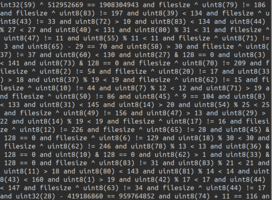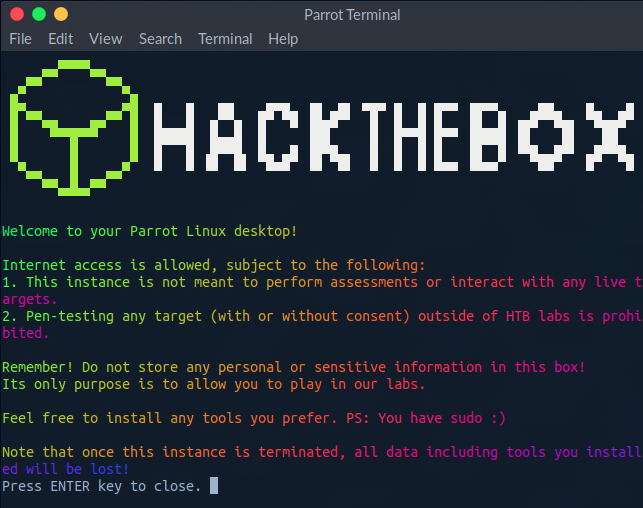Posts
-
SANS Holiday Hack Challenge 2025: Revenge of the Gnome(s)

The 2025 SANS Holiday Hack Challenge: Revenge of the Gnome(s) takes place over three acts in the Dosis neighborhood, where gnome dolls have come to life and are scurrying around furthering a plot by Frosty the Snowman to freeze the world so that it’s always winter and he never melts. I’ll work through 27 challenges ranging from beginner-friendly to expert-level, covering web exploitation, reverse engineering, cloud security, AI prompt injection, cryptography, and signal analysis to help stop Frosty and save the neighborhood. I’ll also write a hack the game itself, writing a TamperMonkey plugin to do NPC / terminal / door / item locations, teleportation, and allow walking through walls. I’ll find a bunch of hidden gnomes hanging out in a patch of snow and uncover how the game developers made the running gnomes, and a bunch of Easter Eggs as well.
-
Flagvent 2025

When Hackvent was canceled this year, the community came together and created Flagvent, and it delivered! In the easy sections I’ll reassemble QRcodes, find hidden audio channels in a video, decode a DNA sequence, look at a musicxml file, and do some good old XOR brute forcing. There were also two challenge from me, centered on PyGyat and symbolic links. The medium days brought an interesting steg technique counting pixels, XSS abusing window.name, modem decoding, web exploitation, and uuid abuse. The hard days brought pwn in both heap exploitation and Python exploitation, quantum computing, NAS exploitation, crypto PRNG prediction, reverse engineering, and air-gapped exfil over Christmas tree lights. Finally, in leet there was a hardware challenge, a Kubernetes / vault challenge, and BGP hijacking. 24 days of fun, even if the challenge levels felt harder this year.
-
HTB: WhiteRabbit

WhiteRabbit is a pentesting company. I’ll exploit their Uptime Kuma instance to find the domain for their WikiJS wiki. On that I’ll find documentation for a n8n pipeline, and find an SQL injection vulnerability in how it processes email, as well as the key for crafting signatures. I’ll make a proxy to add signatures using mitmproxy and then use sqlmap to dump the database. In the DB I’ll find restic commands, which I’ll use to get a backup with SSH keys. I’ll abuse restic command injection to get root on a container, and find SSH keys for a user on the host. From there I’ll find a custom password generator, and using logs from the DB that leak the time the command was run, generate the right password for the next user. That user can run any command as root.
-
HTB: Editor

Editor is a Linux box hosting a code editor website, with documentation on an XWiki instance. I’ll exploit a vulnerability in XWiki’s Solr search that allows unauthenticated Groovy script injection to get remote code execution and a shell. From there, I’ll find database credentials in the XWiki Hibernate config and pivot to a user who reuses the password. Enumerating localhost services, I’ll find NetData running an older version that installs a vulnerable ndsudo SetUID binary that is vulnerable to PATH injection, which I’ll abuse to get root.
-
HTB: Era

Era starts with a custom file upload website full of insecure direct object reference vulnerabilities. I’ll create an account and abuse one IDOR to download a site backup from the admin account. Then I’ll abuse an IDOR like vulnerability to get admin access to the site. The admin panel has a PHP vulnerability where I can get it to use the SSH module to login to the host and run commands, providing a reverse shell. From there, I’ll create my own signed binary to replace one that I can run with sudo to get root.
-
HTB: Mirage

Mirage is an Active Directory DC. I’ll start by finding a domain name in a report on an open NFS server. That name is not registered in DNS, so I’ll register it pointing to my host, and use that to capture NATS credentials. I’ll use those to enumerate NATS and find another set of creds. With those, I’ll Kerberoast another user to get a shell, and find another user logged into the box. A cross-session relay attack gets their hash which I can crack. That user can reset the password of a contractor user, and I’ll have to re-enable the account and set working hours to use it. From there, I’ll read a GMSA password, and use that service account to do a ESC10 attack, resulting in Administrator access.
-
HTB: Outbound

Outbound starts with a RoundCube instance and a set of creds to login. I’ll abuse a authenticated deserialization vulnerability to get remote code execution and a shell. From there, I’ll recover another user’s email password from the RoundCube database, showing both how to do it manually and using a RoundCube script. Finally, I’ll abuse a CVE in below to make the passwd file writable and get root. In Beyond Root, I’ll dig into the PHP exploit, showcase some neat CyberChef tricks, and play with the sudo rules on the box.
-
HTB: RustyKey

RustyKey starts as an assume breach Windows AD box, with initial creds provided for a low privilege account. I’ll collect BloodHound data and find some interesting computer accounts. I’ll Timeroast and crack the password for one of these computer accounts. This account can add itself to the helpdesk group, which has ForceChangePassword over a handful of users. I’ll get access to these users, having to remove them from the Protected Objects group in order to authenticate remotely. I’ll connect via WinRM as one of them, and find a PDF talking about a new context action for 7zip. I’ll pivot to another of these users who has full control over the registry key linking the context menu option to the 7zip dll. I’ll update that to point to my DLL, and get a shell as one of the testing users. That user can configure RBCD on the DC, which I’ll abuse to get full administrator access to the domain.
-
HTB: Dump

Dump has a website that collects packets on a specific port. It can also handle PCAP uploads and download all the current PCAP files in a zip archive. I’ll abuse wildcard injection in the zip command with some carefully crafted filenames to get RCE and a shell. I’ll pivot to the next user with a password from the database. I’ll then abuse how www-data can run sudo to run tcpdump to get root.
-
HTB: Voleur

Voleur is an active directory box that starts with assume breach credentials. I’ll find an Excel notebook with credentials and get a shell. I’ll find a deleted user and switch to a service account to recover it. That user can access an SMB share with a user’s home directory backup, where I’ll find DPAPI encrypted credentials. I’ll recover those, getting access to an SSH key that provides access to a WSL instance. There I’ll find registry hive backups where I can dump the administrator hash.
-
HTB: Store

Store has an ExpressJS website that offers file storage with military grade encryption. I’ll upload and retrieve files, but also find a way to leak the encrypted version of the files. The encryption is just a static nine-byte xor. I’ll find a way to directory traverse to leak files, but they are encrypted with the same key. I’ll decrypt them to leak an SFTP password. I’ll use the SFTP access to tunnel to a localhost port offering the nodejs inspect debugger, and use that to get a shell on the box. There I’ll find Chrome running as root and abuse it’s debug port to get execution.
-
HTB: Artificial

Artificial starts with an AI website where I can upload models that are run with TensorFlow. I’ll exploit a deserialization vulnerability in how TensorFlow handles h5 files to get RCE and a foothold. I’ll find hashes in the database and crack one to pivot to the next user. That user has access to an instance of Backrest running on localhost. I’ll find the config and crack the hash to get access, and then show three ways to get execution as root through the application.
-
HTB: DarkCorp

DarkCorp lives up to its insane difficulty, with three hosts, including a Windows AD domain, and starts with a Debian web/mail server. I’ll exploit an XSS in RoundCube to get access to the admin’s emails, leaking a private subdomain. I’ll reset the admin’s password and get into the dashboard, identifying an SQLI. I’ll abuse PostgreSQL to get RCE from this two ways. In a PGP-encrypted backup I’ll find the hash for another user and crack it, getting auth to the domain. Those creds also get me into a website on the Windows web server that can do status checks on other websites. These checks will attempt NTLM authentication, and I’ll relay that to create a domain entry, and then use printer bug to get the WEB-01 box to authenticate to me, which I can relay to get a silver ticket for administrator on WEB-01. On that host I’ll find the local administrator account creds in the scheduled tasks, and use those to decrypt a stored credential. Password spraying that password will own another account on the domain. That user can get a shadow credential for another user. That user has a matching .adm account, and I’ll do UPN spoofing to get access to that admin account back on the original Linux host. With root access on that host, I’ll pull cached AD credentials from the SSSD database to pivot back to the DC. This user can modify a GPO, which I’ll abuse to get administrator access over the entire domain.
-
HTB: TombWatcher

TombWatcher is an assume breach active directory box. I’ll use BloodHound to find a path to another user with targeted Kerberoasting, GMSA, ForceChangePassword, and a shadow credential. This user has access to the AD Recycle Bin, where I’ll recover an old ADCS admin account. I’ll use that account to exploit ESC15 to get Administrator access.
-
HTB: Watcher

Watcher starts with a Zabbix server. I’ll abuse CVE-2024-22120, a blind SQL injection to leak the admin session and get RCE. From there I’ll log in as admin and find a user logging in every minute. I’ll update the login PHP source to save the creds to a file. Those creds also work for a local instance of TeamCity, which I can log into as an admin and abuse a build pipeline to get execution as root.
-
HTB: Certificate

Certificate starts with a school website that accepts assignment uploads in limited formats that includes zip archives. I’ll show two ways to bypass the filters in PHP and upload a webshell - first with a null byte in the filename inside the zip, and then by stacking two zips together. Both of these abuse how the filesystem and PHP handle these cases differently. I’ll pivot to the next user after dumping a hash from the website DB. That user has access to a PCAP, where I’ll find a Kerberos authentication and crack it in hashcat to get the next user. I’ll exploit ESC in the ADCS environment to get the next user, and then use their membership in the Domain Storage Managers group (which gives SeManageVolumePrivilege) to get arbitrary file read on the system. The root flag is encrypted with EFS, so I’ll exfil the ADCS private key and use a Golden Certificate attack to get a shell as the Administrator user and the final flag.
-
HTB: Puppy

Puppy is a Windows Active Directory pentest simulation. It starts with a set of creds in the HR group, which a common target of phishing attacks. That user has GenericWrite over the Developers group, so I’ll add my user and get access to SMB shares where I’ll find a KeePassXC database. I’ll crack the secret with John, and get auth as the next user. That uses is a member of Senior Devs, which has GenericAll over another user. I’ll reset that user’s password and get a WinRM session. This user has access to a site backup, where I’ll find a password to spray and get WinRM as the next user. Finally, I’ll abuse that user’s DPAPI access to get a saved credential for an administrator.
-
HTB: BabyTwo

Another Windows box where I’ll try username as password and find two accounts. From those I’ll get access to the SYSVOL share, where I can poison a logon script to give me a reverse shell when the user logs in. That user has control over another service account that is meant to administer GPOs. I’ll abuse the GPO to get shell in the administrator’s group.
-
HTB: Fluffy

Fluffy is an assume-breach Windows Active Directory challenge. I’ll start by exploiting CVE-2025-24071 / CVE-2025-24055, a vulnerability in how Windows handles library-ms files in zip archives, leading to authentication attempts to the attacker. I’ll get a NetNTLMv2 and crack it. From there, BloodHound data shows that this user has GenericWrite over some service accounts. I’ll abuse that to get a WinRM shell with one. From this user, I’ll exploit ESC16 in the ADCS environment to get a shell as Administrator.
-
HTB: Baby

Baby is an easy Windows Active Directory box. I’ll start by enumerating LDAP to find a default credential, and spray it to find another account it works on. From there, I’ll abuse Backup Operators / SeBackupPrivilege to get dump both the local and domain hashes, finding a hash for the Administrator account that works to get a shell.
-
HTB: Forgotten

Forgotten starts with an uninitialized instance of LimeSurvey. I’ll do the installation wizard, using a MySQL instance hosted on my VM as the database, and giving myself superadmin access. I’ll upload a malicious plugin to get RCE and a shell in the LimeSurvey container. I’ll find a password in an environment variable that works for the user account on the host, as well as sudo to get root in the container. I’ll abuse that to write a root-owned SetUID binary in a shared folder on the container such that I get access to it on the host and complete the compromise.
-
HTB: Planning

Planning offers a Grafana instance that’s vulnerable to a CVE in DuckDB that is an SQL injection that can lead to remote code execution. I’ll abuse that to get a shell as root in the Grafana container. I’ll find creds in an environment variable, and use them to pivot to the host over SSH. There I’ll find an instance of Crontab UI. I’ll get creds from a backup cron, and use it to make my own cron as root to get execution. In Beyond Root I’ll dig into the Grafana Swagger UI and the Crontab UI configuration.
-
HTB: Delegate

Delegate starts with a bat script on an open SMB share that leaks credentials. I’ll use those to targeted Kerberoast another user, and get a shell. That user has SeChangeNotifyPrivilege, which I’ll use to give a fake computer unconstrained delegation, and then capture the DC machine account TGT. From there I can DCSync to dump the Administrator’s NTLM hash.
-
HTB: Environment

Environment starts with a Laravel website that happens to be running in debug mode. I’ll abuse a CVE that allows me to set the environment via the URL. I’ll find in the debug crashes that if the environment is set to “preprod”, the login page is bypassed, and use that to get access to the internal site. There I’ll abuse another CVE to bypass file filtering in the Laravel filemanager to upload a webshell. I’ll find a GPG-encrypted file and the private key to get access to the next user. Finally, I’ll abuse a sudo rule that allows keeping the BASH_ENV environment variable to get root.
-
HTB: Media

Media starts with a PHP site on Windows that takes video uploads. I’ll use a wax file to leak a net-NTLMv2 hash, and then crack it to get SSH access to the host. I’ll understand how the webserver is writing the files to the filesystem, and use a junction point link to have it write into the web root, allowing me to upload a webshell and get access as local service. I’ll use FullPowers to enable the SeImpersonatePrivilage, and then GodPotato to get System.
-
HTB: Race

Race starts with a website on Grav CMS, and a phpSysInfo page. I’ll find creds in the process list on phpSysInfo to get into the Grav admin panel as the limited backup user. I’ll create a backup, and use the results to reset the password of another admin. From this admin, I’ll show two ways to get execution, using CVE-2024-28116 and a malicious theme. From there I’ll pivot to the next user with a password from a shell script. For root, I’ll abuse a time-of-check / time-of-use vulnerability in a cron script, using named pipes to hang execution allowing me to switch files.
-
HTB: Eureka

Eureka starts with a Spring Boot website. I’ll abuse an exposed heapdump endpoint to get creds from memory and SSH access. From there I’ll poison the Spring Cloud Gateway configuration to capture login credentials for another user. To get root, I’ll abuse a Bash arithmetic injection to get execution in a script analyzing logs on a cron.
-
HTB: Sendai

Sendai starts with a password spray to get some initial credentials for two users. These users are in a group that can make a couple of AD hops to read a GMSA password and get a shell. From here, there are two paths. One involves finding creds for a user in a running service command line, and then abusing that user’s access to ADCS to exploit ESC4. The other involves MSSQL credentials from an SMB share, tunneling with Chisel, a Silver Ticket, and SeImpersonate.
-
HTB: Reaper

Reaper starts with a simple key validation service. I’ll find the binary on an open FTP and reverse it to find both a buffer overflow and a format string vulnerability. I’ll abuse the format string to leak a memory address to bypass ASLR. Then I’ll abuse the overflow with ROP to call VirtualAlloc to make the stack executable and return to shellcode to get a shell. For root, I’ll find a driver that provides an arbitrary read and write from the kernel. I’ll abuse that to copy the token from a legit system process into my current process and spawn cmd.
-
HTB: TheFrizz

TheFrizz starts with a Gibbons learning management platform that has a file write vulnerability that allows me to write a webshell and get a foothold on the box. I’ll grab a hash and salt from the database and crack that to move to the next user, connecting over SSH using Kerberos for auth. I’ll find an archive files for a WAPT install in the RecycleBin, and recover that to get a password for the next user. That user can edit group policy objects (GPOs), which I’ll abuse to get a shell as SYSTEM.
-
HTB: Lock

Lock starts with a Gitea instance where I’ll find an API token in an old commit. I’ll use that to access a private repo for the website. The repo is setup with CI/CD so that the production website is updated when the repo changes. I’ll add an ASPX webshell and get a foothold on the box. I’ll find a mRemoteNG config file and decrypt it to get the next user’s password and RDP access. From there I’ll exploit a vulnerability in the pdf24 installer repair functionality by putting a lock on a log file it wants to write, and running it. When a cmd.exe window hangs open, I’ll abuse a few steps to get a cmd.exe running as SYSTEM.
-
HTB: Phantom

I’ll start with guest share access where I’ll find an email with an attachment containing a default password. I’ll brute force users on the domain, and spray the password to find a user who hasn’t changed it. That user has access to another SMB share where I’ll find a VeraCrypt volume. I’ll crack that using a custom wordlist and hashcat rules, and get access to a VyOS backup. I’ll use creds from that backup to get a shell as a service account on the host. For root, I’ll abuse a BloodHound chain that involves AllowedToAct and performing RBCD without access to an account with an SPN.
-
HTB: Nocturnal

Nocturnal presents a website with an IDOR vulnerability that allows me to read other user’s files, and leak the admin password. Inside the admin panel, I’ll find a command injection vulnerability in the admin backup utility and exploit it to get a foothold. I’ll crack a hash to get the next user’s password. For root, there’s an instance of ISPConfig. I’ll exploit a PHP code injection vulnerability to get execution and a shell as root. In Beyond Root, I’ll look at the website file download feature before HTB patched it one week after Nocturnal’s release.
-
HTB: Sweep

Sweeper is about an instance of lansweeper. I’ll RID cycle to get usernames, and then spray to get authentication. In the application, I’ll get it to try to authenticate to an SSH server on my host, and capture the creds, which work to get onto the box. From there, I’ll show two ways to escalate. First, I’ll get access to the raw lansweeper data and decrypt a more privileges password. Then I’ll use lansweeper to make a deployment that runs a reverse shell as system.
-
HTB: Zero

Zero is all about abusing Apache. It’s a hosting provide, where I can get an account with SFTP access to upload files to be holder in a path on the site. I’ll overwrite the .htaccess file and use it to read files from the file system. I’ll write a Python script to automate this, and read files to find a password in the website database connection information. With a shell, I’ll see a script running every minute that looks at the Apache process in the process list and runs apache2ctl to verify the configuration is good. I’ll fake a process name and overload an argument to get apache2ctl running on a config I control. I’ll show a partial file read, a failed attempt at command injection, and two ways to get a shell as root.
-
HTB: University

University is a monster insane level machine. I’ll start with a website and exploit a CVE in the process of generating a PDF copy of my profile to get a shell on the host. I’ll find the same user’s creds in a PowerShell script, and use them to log into not only this host, but two containers (one Linux and one Windows). From there, I’ll generate a lecture package with a malicious URL file to get execution as one of the reviewers. I’ll use that user’s interactive session to coerce Windows into looking for WPAD hosts, and poison the response from the Linux container, allowing me to do a relay attack adding a fake computer with RBCD configured to allow me full access to the Windows container. That container also has unconstrained delegation, so I’ll dump Kerberos tickets from memory to get the next user. That user can read GMSA on a service account that can act as the DC, which I’ll abuse to get domain admin.
-
HTB: Rainbow

Rainbow has a custom Windows executable webserver. I’ll find a crash with some manual fuzzing and use x32dbg to weaponize it to get a shell. The user is in the administrator’s group, but UAC prevents reading the root flag. I’ll abuse the fodhelper UAC bypass to get full integrity and full access.
-
HTB: Build

Build starts with a Jenkins backup on an rsync server. I’ll download and decrypt a password to get access to a Gitea instance. I’ll update a Jenkins pipeline and get execution in a Docker container I’ll find PowerDNS-Admin running in another container, and on gaining access to that, set my host to have a hostname that’s allowed to authenticate using rlogin without a password, providing root access.
-
HTB: Code

The website in Code is a Python in browser code editor. A lot of the dangerous modules are blocked by a keyword filter. I’ll bypass the filter and get RCE. The next user’s hash is in the database, and I’ll crack it to move laterally. For root, I’ll work through a Bash wrapper script around a backup utility, backy. The script tries to prevent backups from outside of /var/ and /home/, but I’ll break out and backup /root. In Beyond Root, I’ll explore protected-regular, which led to some weird behaviors while solving root, and ends up with an unintended solution, and show an slightly unintended path on the foothold using SQLAlchemy.
-
HTB: LustrousTwo

LustrousTwo starts with a website that requires Kerberos authentication. I’ll get on an open FTP server and find a list of usernames, which I can spray to get initial authentication on the domain. That auth provides access to the site, and a directory traversal file read which I’ll abuse to find the source DLL for the website. With a bit of .NET reversing, I’ll find users that have extra access, and get a service ticket impersonating them. That access allows me to run commands on the host and get a shell. To escalate, I’ll find a Velociraptor server and it’s key material, allowing me to run commands as system on the host.
-
HTB: Manage

Manage starts with a Tomcat website with RMI and JMX exposed. I’ll abuse these to get execution and a shell. I’ll find a Google Authenticator file in a backup archive, and use that with password reuse to pivot to the next user. That user can run adduser as root, but only giving a username. I’ll abuse this to create an admin user which gets the admin group which can sudo anything by defau
-
HTB: Cypher

Cypher starts with a website advertising a graph database. I’ll use cypher injection to bypass the login and get into the site. I’ll find a JAR file for a Neo4J extension and reverse engineer it to find command injection in a custom cypher method. I’ll abuse that to get a shell on the box, and pivot to the next user with a password in their bash history file. This user can run bbot as root, which I’ll exploit two ways to both get the flag and get a shell. In Beyond Root, I’ll show some steps that can be skipped with additional enumeration, and look at the interesting webserver configuration.
-
HTB: Ten

Ten offers a website with hosting services, where the user can sign up for a subdomain and get access to FTP to put files into that domain. There’s also an open WebDM instance, and on getting access, I’ll find I can modify the directories used by the FTP server and the user ID such that I can write an SSH key into a user’s directory and get access. With that foothold, I’ll see that the website is using etcd and remco to generate Apache configs as users create sites. I’ll abuse that to get a shell as root.
-
HTB: RetroTwo

RetroTwo starts with an open SMB share with an Access database. In a macro module attached to the DB, I’ll find a script with valid domain creds. That allows me to collect BloodHound data, where I’ll find two computers with pre-Windows 2000 weak passwords. I’ll abuse that to get access to another computer account, and then RDP. From there, I’ll find an old OS, and show two different well known vulnerabilities to exploit it, Perfusion and ZeroLogon.
-
HTB: Scepter

Scepter starts with an open NFS share exposing some client authentication certificates. Most have been revoked, but I’m able to crack the password on the other and authenticate with it. That user can change the password of the next user, and from there I’ll abuse ESC14 to get authentication as another user. The next escalation is a different twist on ESC14, and from there I can DCSync the domain hashes for full compromise. In Beyond Root, I’ll look at the failed certificate authentication at the start of the box and show that the user accounts are disabled but the certificates are fine, as well as a look at the configuration that didn’t allow ESC9.
-
HTB: Redelegate

I’ll find files on an open FTP server to start Redelegate. These files include the results of a security audit and a shared KeePass database. I’ll crack the password and get access to MSSQL, where I can enumerate domain users. Then I’ll password spray to get a foothold on the domain. That user is in the helpdesk group and can reset another user’s password, providing WinRM access to the host. From there I’ll abuse SeEnableDelegationPrivilege to configure a computer with constrained delegation in an exploitable manner.
-
HTB: Reset

Reset has a website where the reset password API sends the new password back in the response to the request, by passing the need to have access to the account email. I’ll exploit a log poisoning vulnerability to get RCE. From there, I’ll abuse Berkeley r commands to get access as the next user, and find a password in a running tmux session. For root, I’ll abuse sudo nano. In Beyond Root, I’ll look at the web source and what the rlogin command looks like on the wire.
-
HTB: Dog

Dog presents an instance of Backdrop CMS. I’ll abuse an exposed Git directory on the webserver to access configuration files, finding both a username and a password. Logged into the CMS, I’ll upload a malicious module / plugin to get remote code execution. After pivoting to the next using by a shared password, I’ll find that they are able to run the tool designed for managing Backdrop-CMS, bee, as root. I’ll abuse a command that allows for running arbitrary PHP code to get a shell as root.
-
HTB: VulnEscape

VulnEscape starts with only one open TCP port, remote desktop. I’ll connect and find a kiosk account that doesn’t require a password. On logging in, I’m presented with a full screen image and not much else. I’ll escape kiosk mode by opening Edge, and using it to access the file system. There I’ll download cmd.exe to the downloads directory, and rename it to msedge.exe to bypass named-based allow lists. With a shell, I’ll find a Remote Desktop Plus session file. I’ll load it into the application, and use BulletPassView to see the password under the obfuscated dots. With an admin password, I’ll use runas to get a shell, but it’s limited by UAC, which I’ll bypass to get full admin access. And for an interesting twist, the entire box is in Korean. In Beyond Root, I’ll set the language back to English and explore the Kiosk mode settings.
-
HTB: Cat

I’ll leak the source code for the Cat website from an exposed git directory. I’ll use XSS to capture the admin user’s cookie, and then a SQL injection to get a webshell on the host and remote code execution. I’ll pivot to the next user by cracking a hash in the web application database. I’ll find the next user’s password in the Apache access logs. Finally, I’ll exploit a vulnerability in a private Gitea instance to get root.
-
HTB: VulnCicada

I’ll find an open NFS share on VulnCicada, and exfil two images. One of them has a password on a sticknote, which I’ll use to get authenticated to the domain. From there, I’ll enumerate ADCS and find the DC vulnerable to ESC8. I’ll show how to do this attack from Linux, creating a malicious DNS record that points the DC back to my host, abusing a serialized empty string. Then I’ll use PetitPotam to coerce the DC to authenticate to me, where I’ll use certipy relay to get a TGT as the machine account. I’ll use that account to dump hashes for the domain, and get a shell as administrator.
-
HTB: Data

Data is a pretty straight forward easy box that starts with a Grafana instance. I’ll abuse an unauthenticated directory traversal / file read vulnerability to leak the SQLite file used by Grafana. I’ll crack a user hash and find it’s a shared password with an account on the system. For root, I’ll abuse a sudo rule that allows for running docker exec. Inside the container, I’ll mount the host file system and leverage that into a shell.
-
HTB: Haze

Haze is built around an instance of Splunk Enterprise. I’ll start by exploiting a directory traversal / file read in Splunk that allows me to leak configuration files that container encrypted passwords. I’ll exfil the key and decrypt them, finding a password that’s reused by a user. That user has limited access, but I’m able to spray the password and find a second user with the same password. That user can abuse some Windows ACLs to get access to the gMSA password for a service account. I’ll use that account to get a Shadow Credential for the next user. From there I’ll access a Splunk backup archive, and find older passwords that work for the admin account on the Splunk website. I’ll upload a malicious Splunk application to get a shell as the next user. That shell has the SeImpersonatePrivilege, which I’ll abuse with GodPotato to get system access.
-
HTB: Retro

Retro starts with an SMB share and note about a trainee account that uses the username as the password. From there, I’ll find a machine account that’s old and has the pre-Windows 2000 password set. That account allows me access to ESC a vulnerable ADCS template, providing administrator access.
-
HTB: Titanic

Titanic offers a website and a Gitea instance with the source code. I’ll look at the source to identify a directory traversal / file read vulnerability. I’ll use that to read the Gitea DB and crack a hash from the users table. That password works over SSH as well. I’ll find a cron running as root that is running Image Magick on images in a given directory. I’ll exploit a CVE in Image Magick to get execution as root.
-
HTB: Shibuya

Shibuya starts with a brute force user enumeration over Kerberos, finding two machine accounts with their passwords set to their username. I’ll use those to enumerate LDAP, finding credentials for a service account in a comment. That user has access to an SMB share with three Windows Imaging images, and one contains backups of the registry hives. I’ll dump hashes from these, and spray them to get access to another user and a shell. There’s another user logged into the box, and I’ll use RemotePotato0 to get a shell with a cross session relay attack. This user can exploit ESC1 in the ADCS configuration to get administrator access.
-
HTB: Down

Down has a website designed to check if a website is up. This presents an obvious SSRF, but to bypass filters and exploit it I’ll have to abuse curl’s feature of taking multiple URLs and pass a second URL with the file schema to read from the host.I’ll get access to the page source, and see there’s an expert mode that will make a raw TCP connection with netcat. I’ll use parameter injection there to get a shell. From there, I’ll dig into a pswm instance to get the next user’s password, and they have a simple sudo rule to root.
-
HTB: Infiltrator

Infiltrator is a very long box. It starts out with some people on a website. I’ll use those names to make usernames and brute force to find the username format. Then I’ll AS-REP-Roast to get initial creds. That user doesn’t have much, but I’ll spray the password around the other domain users and find another account with the same. This user is in the protected users group, so I’ll need to authenticate with Kerberos. From that user, Bloodhound data shows a path to another user where I’ll get a shell. There I’ll find Output Messager installed, and set up tunnels to access. I’ll find creds for a couple more pivots in the chat (including in a .NET exe from the chat), before exploiting the calendar functionality to get execution and another shell. In this users received files I’ll find a PCAP, and pull both more creds and a BitLocker backup file. I’ll find a recovery key in the backup, and connect with RDP and decrpyt the E drive to get access to a backup of the registry and NTDS information. I’ll dump that to get a shell as the next user, who has ReadGMSAPassword on a service account. That user can exploit ESC4 in the ADCS to get administrator access.
-
HTB: Backfire

Backfire is all about exploiting red team infrastructure, first Havoc, and then HardHatC2. I’ll start with a Havoc server and leak the configuration from the website. I’ll exploit an SSRF vulnerability to get access to the admin port internally. There’s an authenticated RCE vulnerability on this port, but it involves sending payloads into a websocket. I’ll create a chained exploit using the SSRF to stand up and communicate over a websocket to get command injection and a shell. From here, I’ll find an instance of HardHatC2, and exploit the default JWT secret to forge cookies and get access. Inside the C2 admin panel, I’ll get a shell as the next user. Finally, I’ll abuse a sudo rule that allows saving the firewall rules to get arbitrary write, and get a shell as root.
-
HTB: Checker

Checker starts with instances of BookStack and Teampass. Without creds to either, I’ll find an SQL injection vulnerability in Teampass and leak user hashes. One cracks, and let’s me in, revealing both BookStack and SSH creds. SSH has two factor enabled. In BookStack, I’ll exploit an SSRF with a very tricky blind PHP filter oracle to read the two factor seed from a backup, and get a shell on the box. For root, I’ll exploit a binary that uses shared memory to look for compromised hashes, and poison that memory in a race condition to get execution as root.
-
HTB: EscapeTwo

EscapeTwo starts with an assume breach scenario, a simple windows account with creds. I’ll use those to find a broken Excel workbook, which I’ll recover passwords from to get sa access to MSSQL. From there I’ll enable xp-cmdshell and get a foothold on the box. There I’ll find more creds and pivot to the first user. I’ll abuse a WriteOwner privilege on a service account to get access as that account. The service account can exploit ESC4 in the ADCS setup to get Administrator access.
-
HTB: Heal

Heal starts off with a resume generation website that uses three domains. There’s the main site, an API, and a survey site. I’ll abuse a file read / directory traversal in the API to get access to the Ruby configuration and eventually the SQLite3 database. There I’ll get the web admin’s hash, and crack it, discovering that they use it on the LimeSurvey site as well. There I’ll build a webshell plugin to get a foothold on the box. I’ll find another shared password in the PostgreSQL config to get to the next user. For root, I’ll abuse an unauthenticated Consul instance. In Beyond Root, I’ll go way too deep into an SSRF vulnerability that didn’t work in the HTML to PDF libraries used by the site.
-
HTB: UnderPass

I’ll pull data from SNMP to find a daloRADIUS server on UnderPass. I’ll find the login page, and use default creds to get access. There I’ll find a hash for a user, which can be cracked to get SSH access to the box. That use can run a Mobile Shell (Mosh) server as root using sudo, and that leads to a root shell.
-
Python Tools and Scripts w/ UV CheatSheet

UV is the hot new tool among Python developers. It addresses a ton of issues in the Python ecosystem, from packaging, project management, tool installation, and virtual environment management. A lot of the tutorials out there are for developers. In most of the roles I’ve worked in information security, I’ve been much more a user of Python than a developer. This post is all about how to use UV to install and run Python applications and scripts.
-
HTB: BigBang

BigBang has a WordPress site with the BuddyForms plugin. I’ll find a 2023 CVE that involves uploading a PHAR / GIF polyglot. It doesn’t work, but it does show how to read GIFs, which I’ll turn to the local system. Then using a PHP-filter-based tool I’ll abuse this to read arbitrary files. I’ll use that to exploit a 2024 CVE in Glibc to get RCE. I’ll find WordPress config creds to pivot to the next user. The next user has access to a Grafana instance. I’ll get their hash from the DB and crack it to escalate again. This user has access to an Android APK. I’ll reverse it to understand the API and get an auth token, and find command injection to get execution as root.
-
HTB: Vintage

Vintage is another pure AD box, this time at Hard level. I’ll start with creds, and use them to collect Bloodhound data, which shows a computer object that’s a member of the Pre-Windows 2000 Compatible Access group. This means I can guess it’s password, and use that machine to get the GMSA password for a service account. I’ll use that access to enable a disabled service account and perform a targeted Kerberoast attack on it. I’ll spray that password to get access as a user and the first flag. That user has a credential in Windows Credential Manager, which I’ll extract and decrypt from DPAPI to get an account with some administrative access. That user is positioned to add objects to a group that has resource based constrained delegation on the domain controller. I’ll add the computer object to the group and use it to get full domain access.
-
HTB: Administrator

Administrator is a pure Active Directory challenge. I’ll start with creds for a user, and use them to collect Bloodhound data on the domain. I’ll find that I can modify a user’s password, and that user can modify another user’s password. That user has access to an FTP share where I’ll find a Password Safe file. I’ll crack the password to recover more passwords, pivoting to the next user. This user has GenericWrite over another user, which I’ll abuse with a targeted Kerberoasting attack. Finally, I’ll do a DCSync attack to dump the domain administrator’s hash and completely compromise the domain.
-
Operating System Enumeration

There are little clues that can be gathered when first approaching a target as to the operating system and version. This cheat sheet is meant to showcase three methods for pulling information from initial scans. First I’ll look at SSH and webserver application versions and use them to map to OS versions. Then I’ll look at ports that are commonly present on Windows DCs and clients. Finally, I’ll look at IP packet TTL values, and how they can identify an OS, as well as virtualized systems.
-
HTB: LinkVortex

LinkVortex is running an instance of Ghost for a blog. I’ll find a dev site with an exposed Git repo, and find credentials in it. These credentials allow me to exploit CVE-2023-40028, a file read vulnerability in Ghost abusing symbolic links in zip archives. I’ll exploit it manually and create a Python script to do it. To escalate to root, I’ll abuse a shell script with sudo. I’ll show three ways to exploit the script. In Beyond Root, I’ll look the Apache server directives that prevent the version information from being shared in the server string and on the 404 page.
-
HTB: Ghost

Ghost starts with a few websites, including a Ghost blog, an internal site, and a Gitea instance. I’ll use LDAP injection to get into the blog site and brute force account passwords. From there, I’ll find the site source in Gitea and identify a file read / directory traversal in the custom code added to Ghost. I’ll use that to read an environment variable with an API key, allowing access to a custom API where there’s a command injection vulnerability. I’ll abuse that to get root access in an Ubuntu container. In that container, I’ll abuse a long running ControlMaster SSH session to get into the Ubuntu VM as the next user. I’ll use that user to add a DNS entry on the domain, allowing me to capture a NetNTLMv2 challenge / response, which I’ll crack to get access as the next user. This user has gMSA read access to the ADFS service account. As the ADFS user, I’ll abuse a Golden SAML attack to get access to the admin panel website. In that website, I’ll interact with the database to find impersonation on a linked server and get a shell after enabling xp_cmdshell. That server is the DC of a subdomain of the main domain, and has bidirectional trust with the main domain. I’ll show both abusing that trust and a golden ticket to get access to the main machine.
-
HTB: BlockBlock

BlockBlock offers a chat application where the database is built on the blockchain using smart contracts. I’ll abuse a cross-site scripting vulnerability along with an api endpoint that reflects the user’s authentication cookie to get access to the admin’s account. From there, I’ll figure out how to make JSON RPC calls against the local Etherium instance, and read the raw blocks of the blockchain to find a password that provides SSH access. The user can run forge as another user, which I’ll abuse three ways to get execution and a shell as that second user. That user can run the pacman, the package manager for Arch Linux, as root. I’ll show several different ways to abuse this to get root.
-
HTB: Alert

Alert starts with a webserver hosting a simple markdown to HTML application. I’ll upload a payload that can inject scripts into the resulting page, and send a link to the admin. I’ll use the XSS to read internal pages, and exploit a directory traversal / file read vulnerability to access the hash protecting an internal site. I’ll crack that, and use the password for SSH access. On the box, I’ll find root executing a PHP script on a cron, and find one of the imports is writable. In Beyond Root, I’ll work through three things that I tried to attack that failed, showing both my thinking at the start and using root access to show why they failed. I’ll also look at a strange filtered port.
-
HTB: Certified

Ceritified is the first “assume-breach” box to release on HackTheBox. I’m given creds for a low priv user. I’ll find this user has WriteOwner over a group, which I’ll abuse to eventually get access to another user. That user has GenericAll over a user. This enabled the ESC9 attack on ADCS, where I can modify the user’s UPN to get a certificate as administrator.
-
HTB: Chemistry

Chemistry starts with a website for handling Crystallographic Information Files (CIF) to display molecules. I’ll exploit a deserialization vulnerability in a Python library used to process these files to get execution on the box. I’ll crack a hash in the website database to get the next user’s password. Finally, I’ll find an internal website running on AIOHTTP. I’ll exploit a directory traversal vulnerability in that site to read root’s private SSH key. In Beyond Root I’ll look at the vulnerable AOIHTTP code and show the vulnerability.
-
HTB: Unrested

Unrested is all about a Zabbix server and a critical vulnerability that was made public in December 2024. It’s a SQL injection vulnerability, and I’ll deep dive into the source to see how it works, and how to exploit it. Most solutions to this box show blind SQL injection, I’ll show how to use the source code to figure out how to get data back from the DB. For root, I’ll abuse sudo nmap with a custom wrapper that breaks the published GTFObins. In Beyond Root, I’ll look at another vulnerability that came out at the same time, and show what the super admin role looks like in the GUI by escalating my user to that role.
-
HTB: Instant

Instant starts with an Android application. In reversing it, I’ll find a domain for the API swagger documentation, as well as a hard-coded admin JWT token. I’ll use that token to access the admin API, where I’ll find a file read vulnerability that I’ll leverage to get a shell. To escalate, I’ll find a SolarPuTTY session file and decrypt it to get the root password.
-
HTB: Yummy

Yummy starts with a website for booking restaurant reserversations. I’ll abuse a directory traversal vulnerability in the functionality that creates calendar invite files to read files from the host, getting access to the source for the website as well as the crons that are running. I’ll crack the RSA used for the JWT cookie signing to get admin access, and abuse a SQL injection to write a script that will be executed by the crons. I’ll abuse another cron to get access as www-data. This user has access to a Mercurial repo (similar to Git), where I’ll find another users credentials in past commits. As the next user, I can write a Mercurial hook to pivot again. This user can execute rsync as root, which I’ll abuse to complete the box. In Beyond Root, I’ll look at the Python source for the site and why it behaves the way it does, and the misconfigurations that were enabled to allow file writing as MySQL, including MySQL configurations and AppArmor.
-
HTB: Cicada

Cicada is a pure easy Windows Active Directory box. I’ll start enumerating SMB shares to find a new hire welcome note with a default password. I’ll RID-cycle to get a list of usernames, and spray that password to find a user still using it. With a valid user I can query LDAP to find another user with their password stored in their description. That user has access to a share with a dev script used for backup, and more creds. Those creds work to get a shell, and the user is in the Backup Operators group, so I can exfil the registry hives and dump the machine hashes.
-
HTB: MagicGardens

MagicGardens starts by exploiting a Django website, tricking it into approving a purchase for a premium subscription. With this subscription, I am able to include a cross-site scripting payload in a QRCode and collect the admin’s cookie. This provides access to the Django admin panel where I’ll get a hash and SSH access to the box. Another user is running custom network monitoring software. I’ll exploit a buffer overflow in the IPv6 handler to get a shell as that user. That user has access to the Docker Registry, where I’ll find the image for the container running the Django site, including the hardcoded secret. I’ll exploit a deserialization vulnerability to get a root shell in that container. From there, I’ll abuse the capability to load kernel modules to get a root shell on the box.
-
HTB: Trickster

Trickster starts with an instance of Prestashop. I’ll exploit an XSS to get admin access and a webshell to get execution. Database credentials work to pivot to the next user. From there, I’ll access a instance of ChangeDetection.IO, exploiting a SSTI vulnerability to get a shell in the container running it. In the data associated with the site, I’ll find another user’s password that works on the host machine. That user can run software associated with the Prusa 3D printer as root, which I’ll exploit to get root. In Beyond Root, I’ll look at ModSecurity and how it was blocking some tools used in initial enumeration by User-Agent string.
-
HTB: Strutted

Strutted is a box released directly to retired on HackTheBox highlighting the CVE-2024-53677 vulnerability in Apache Struts that was made public in December 2024. It is a bit tricky to exploit, but I’ll use it to upload a webshell and get a foothold. From there, I’ll use creds from an old Tomcat config to move to the next user, and then abuse tcpdump to get root. In Beyond Root, I’ll show two things that I couldn’t explain while originally solving the box, discovering a new Systemd protection as well as some information about how Tomcat is configured.
-
HTB: Caption

Caption has a website behind a caching server and a proxy / web application filewall. I’ll abuse HTTP/2 cleartext (h2c) smuggling to read pages I’m blocked from reading directly. I’ll use a HTML injection to steal an admin cookie and get more access via the smuggling. From there I’ll get access to an instance of CopyParty, and exploit a directory traversal vulnerability to read an SSH key and get access to the box. To escalate I’ll abuse a command injection in a log-handler. In Beyond Root, I’ll look at some patched unintended solutions.
-
HTB: MonitorsThree

MonitorsThree, like the first two Monitors boxes, starts with an instance of Cacti. Before turning to that, I’ll abuse an SQL injection in the password reset functionality of the main site, leaking credentials from the DB. I’ll use those to get access to Cacti, and from there exploit a file upload vulnerability such that I can run arbitrary PHP code, and get RCE. I’ll get another password from the Cacti DB and pivot to the next user. For root, I’ll exploit an instance of Duplicati. I’ll show three different ways to abuse this, first by backing up the host root directory to read the flag, then by writing to the host file system, and finally by getting a shell in the Duplicati container and accessing the host filesystem from a shared volume in there. In Beyond Root, I’ll dig into port 8084, which was filtered in the initial scan, and still not responsive with a shell.
-
HTB: Sightless

Sightless starts with an instance of SQLPad vulnerable to a server-side template injection vulnerabiity that provides RCE. I’ll exploit that to get a shell as root in the SQLPad container. From there, I’ll dump the shadow file to get user hashes and crack one. That password leads to SSH access on the host, where I’ll find an instance of Froxlor. I’ll exploit an XSS vulnerability to get access and enable FTP access, where I’ll find a Keepass DB with the root SSH key. In beyond root I’ll look at using a SSRF vulnerability in SQLPad to enumeration open ports, and two unintended paths, using Chrome debug and going directly to root RCE through Froxlor.
-
2024 SANS Holiday Hack Challenge: Snow-maggedon

The 2024 SANS Holiday Hack Challenge: Snow-maggedon takes place over a prologue and three acts. In the prologue, we find the elves have packed up from the Geese Islands to head back to the North Pole. In Act I, we’re at the North pole, but Santa is missing, and the elves are starting to divide. In Act II, the elves are nearing all out war, which has broken out in Act III, including ransomwaring the Naughty/Nice list. Throughout these acts, I’ll solve technical and hacking challenges to save Christmas! There is web and JavaScript hacking, curl and PowerShell labs, hardware hacking, mobile application analysis and RE, multiple SOC / SIEM challenges, and ransomware decryption and disabling.
-
Hackvent 2024 - Easy

Hackvent 2024 provided it’s typically mix of fun and challenging CTF problems delivered daily for the first 24 days of December. This year instead of challenges going from easy to leet ending with the hardesst challenge on December 24, they went easy to leet, peaking on days 11-13, and then back down to easy. I was able to complete all but one of the challenges this year. The easy challenges this year had a bunch of barcode manipulation, an interesting PowerShell webserver, some simple web exploitation, an interesting codeded language, and of course, Rick-Rolling.
-
Hackvent 2024 - Medium

There were seven plus one hidden medium challenges in 2024 Hackvent. I had a lot of fun with the Windows memory dump, escaping from a Wine shell, programming a BFS to solve a maze, looking at corrupt disk sectors, with some steg and crypto mixed in.
-
Hackvent 2024 - Hard

The hard challenges on days 8-10 and 14-17 presented some of my favorites in Hackvent this year. Highlights include a very nice challenge with a PCAP showing a compromise and C2 activity, where I’ll extract a Python script and find the flag in exfiltrated data, a ransomware recovery where I have to brute force a pin and exploit an XSS to get the key, some mind-melting crypto, and a really fun hardware verilog simulation.
-
Hackvent 2024 - Leet

The three leet challenges presented challenges about Android reversing, smart contract exploitation, and a Linux binary exploitation challenge. I was only able to complete the first two during this Hackvent season.
-
HTB: Sea

Sea starts with the exploitation of WonderCMS. I’ll find a POC, but work through the steps manually to better show them and learn from them. WonderCMS stores data in files, and I’ll find a password hash in a file and crack it to move to the next user. That same password grants access to an internal website where I’ll find a command injection to get root. In Beyond Root, I’ll show an alternative path involving bruteforcing the WonderCMS admin password.
-
HTB: Compiled

Compiled starts with a website designed to compile Git projects from remote repos. I’ll abuse a CVE in this version of Git to get RCE and a shell. To pivot to the next user, I’ll find the Gitea SQLite database and extract the user hashes. I’ll format that hash into something Hashcat can crack, and recover the password, which is also used by the user on the system. To get system, I’ll abuse a CVE in Visual Studio.
-
HTB: GreenHorn

Greenhorn starts with a PluckCMS instance. I’ll find the source in a local Gitea instance, and crack the admin hash to get access. I’ll create a webshell Pluck module and upload it to get execution on the box. From there, I’ll pivot on a shared password to another user. That user has a PDF with a pixelated root password. I’ll recover the image using Depixalate, and get root. In Beyond Root, I’ll do some PDF forensics and look a bit more at the Depixalate tool.
-
HTB: Lantern

Lantern starts out with two websites. The first is a Flask website served over Skipper proxy, and the other is a Blazor site on .NET on Linux. I’ll abuse an SSRF in Skipper to get access to an internal Blazor admin site. From there I can get an admin password, either via SQL injection or via reverse-engineering a DLL. On the admin page, I’ll get file write and upload a malicious Razor DLL component to get a reverse shell. For root, I’l get access to a ProcMon SQLite database and find a root password in the logged events.
-
HTB: Resource

Resource is the 6th box I’ve created to be published on HackTheBox. It’s designed around an IT resource center for a large company who has had their responsibilities for SSH key signing moved up to a different department. I’ll start by creating a ticket with a zip attachment and using a PHAR filter to execute a webshell from that attachment, providing access to the ITRC container. There I’ll get access to the ticket DB and find a .har file with credentials in it. That user has access to the old SSH certificate signing key, which is still valid on this server, and allows for root access. As root, I can find a script that interacts with the IT API for generating SSH certificates, where I can sign an SSH key that gets me onto the main host. There I’ll learn the principal name to pivot to another user and use the API to generate a certificate as that user. That user can run a bash script as root to generate certificates, but there’s a check to make sure the key for this server isn’t used. I’ll abuse a bash glob vulnerability to leak that key, and generate an SSH certificate that gives root access to the IT server.
-
HTB: Axlle

Axlle is a Windows host with some niche Windows exploitation paths. I’ll start by phishing a user using a Excel Add-On file, XLL. These are since mostly blocked, but were previously quite big in the phishing scene. Then I’ll modify a URL file to run my reverse shell. I’ll find come creds for the next user, and change the password on the next. For administrator, I’ll abuse the StandaloneRunner.exe LOLBIN.
-
HTB: Blazorized

Blazorized in a Windows-focused box, starting with a website written using the Blazor .NET framework. I’ll reverse a DLL that comes from the server to the browser to find a JWT secret and use it to get access to the admin panel. There I’ll abuse SQL injection to get execution and a shell. To pivot to the next user, I’ll abuse the WriteSPN privilege to perform a targeted Kerberoast attack. Then I’ll abuse permissions to write another user’s login script. Finally, I’ll abuse the
GetChangesAllpermission with Mimikatz to dump the hashes for the domain and get a shell as administrator. -
Flare-On 2024: Catbert Ransomware

Catbert Ransomware presents a disk image with four encrypted files, and UEFI bios. I’ll run the bios in an emulator, and find the binary responsible for the shell. In there, I’ll find the decrypt function and reverse it to see how it is using code at the end of the encrypted images in a small VM to check the input password. I’ll write Python VM emulator to work through the code finding the passwords. On decrypting all three, there’s some fun in the emulated bios and the flag.
-
Flare-On 2024: fullspeed

fullspeed is a challenge around a .NET-AOT binary, which means unlike typical .NET binaries, it’s fully compiled to assembly. The binary makes an Elliptic Curve Diffie-Hellmen exchange and then uses it to send data including the flag. I’ll show how I use the given PCAP and the initialized values in the binary to recover the randomly generated privarte key, and decrypt the messages.
-
Flare-On 2024: bloke2

bloke2 involves reversing a Verilog description language project to find a hidden flag inserted by a missing developer. I’ll find a relatively long string of data and where an XOR might be applying it to the input test data, except it’s always disabled by a flag. I’ll enable that flag and the flag comes out while running the tests.
-
Flare-On 2024: sshd

sshd is a really cool challenge that is based on the XZ Utils backdoor. I get an image that has an sshd coredump. In it, I’ll find where it crashed, in the liblzma library. I’ll reverse that to see where it is decrypting a static shellcode buffer and running it. That buffer is connecting to a TCP socket and reading off an encryption key and nonce, as well as a file path. It then reads the file at that path, encrypts it, and sends it back over the socket. I’ll use the core dump to get the keys and encrypted file from memory, and then create my own server to serve them. Then I’ll write a shellcode loader to run modified shellcode to connect to my server and re-encrypt the file with the same key, decrypting it.
-
Flare-On 2024: Meme Maker 3000

Meme Maker 3000 is an HTML / JavaScript challenge that is made so much easier using webcrack. Most of the solution here is running webcrack and then it’s fairly easy to see a few commands to run in the browser dev console to get the flag. I’ll include a video comparing my solution without webcrack with what webcrack can do.
-
Flare-On 2024: aray

aray is a Yara reversing challenge. The Yara language is used to classified and identify malware (and other binary) files. In aray, I’m given a complex rule with hundreds of conditions that define a 85 byte file. I’ll find the 38 conditions that actually define the 85 bytes, and write a Python script to parse the rule and return the file contents.
-
Flare-On 2024: checksum

checksum presents a binary compiled from Golang. I’ll have to answer a series of math addition problems, and then give it the valid SHA256 hash that matches a static value stored in the binary. On success, it writes an image to my AppData Local directory that has the flag.
-
Flare-On 2024: frog

frog is a neat little PyGame executable with Python source code that asks the player to walk the frog to an endpoint. However, there are walls blocking all possible paths! I’ll look at the Python source and come up with three ways to get the flag.
-
HTB: PermX

PermX starts with an online education platform, Chamilo. I’ll exploit a file upload vulnerability to get a webshell and execution on the box. From there, I’ll pivot on shared credentials to the next user. To escalate to root, I’ll abuse a script that allows me to mess with Linux file access control lists using symbolic links to bypass protections. I’ll show several ways to abuse this, and a couple ways that don’t work and show why.
-
HTB: Mist

Mist is an insane-level Windows box mostly focused on Active Directory attacks. It starts off with a simple file disclosure vulneraility in Pluck CMS that allows me to leak the admin password and upload a malicious Pluck module to get a foothold on the webserver. There’s a directory at the filesystem root with links in it, and by overwriting one, I get execution as a user on the host. I’ll find LDAP signing is off, and use PetitPotam to coerce the server to authenticate to my, and relay that to the domain controller to get LDAP access as the machine account. I’ll add a shadow credential to that account and get auth as the machine account on the webserver. I’ll use machine access to get access to the local administrator account. In another user’s home directory I’ll find a KeePass database, along with an image showing a partial password. I’ll use Hashcat to break the database and get an account on the domain. From there, I’ll abuse multiple hops in Active Directory, reading a GMSA password, abusing AddKeyCredentialLink, and exploiting ADCS ESC 13 twice.
-
HTB Sherlock: Pikaptcha

I’m given a PCAP and file artifacts from a compromised computer. This user claims to have gone through a fake download including a captcha. The attack turns out to be a malicious captcha that manipulates the user into running a PowerShell command via the Windows run dialoag, an attack became common in September 2024. I’ll look at the PCAP and the user’s RunMRU registry key to get details about the attack.
-
HTB: Editorial

In Editorial, I’ll exploit a simple publishing website. There’s a server-side request forgery (SSRF) vulnerability in the website around uploading images that allows access to an API running only on localhost. I’ll read from that API to leak a username and password that work over SSH. I’ll find creds for the next user in a Git repo, and then abuse a CVE in GitPython to get root.
-
HTB: Blurry

Blurry is all about exploiting a machine learning organization. I’ll abuse a CVE in ClearML to get a foothold, and then inject a malicious ML model, bypassing a detection mechanism, to get execution as root. In Beyond Root, some unintended paths and the details a more complex foothold.
-
OffSec Exam HTB Lists

TJNull maintains a list of good HackTheBox and other machines to play to prepare for various OffSec exams, including OSCP, OSWE, and OSEP. This page will keep up with that list and show my writeups associated with those boxes. For each of these certifications, there’s a “like” list that includes boxes that are similar in skills and difficulty to the challenges you will encounter in the exam, as well as a “harder” list that includes the same techniques but in more complicated and/or difficult scenarios.
-
HTB: Freelancer

Freelancer starts off by abusing the relationship between two Django websites, followed by abusing an insecure direct object reference in a QRcode login to get admin access. From there, I’ll use impersonation in the MSSQL database to run commands as the sa account, enabling xp_cmdshell and getting execution. I’ll find MSSQL passwords to pivot to the next user. This user has a memory dump which I’ll analyze with MemProcFS to find another password in LSA Secrets. Bloodhound shows this user is in a group with GenericWrite privileges over the DC, which I’ll abuse with resource-based constrained delegation to get domain hashes and a shell as administrator. In Beyond Root, I’ll show an altnerative path using WinDbg to on the dump to find another password, and spraying variations of it to get passwords for a bunch of users, some of whom are also in the group with privileges necessary to exploit the DC.
-
HTB: EvilCUPS

EvilCUPS is all about the recent CUPS exploits that have made a lot of news in September 2024. I’ll abuse the four recent CVEs to get remote code execution on a Linux box through cupsd. In the root step, I’ll find an old print job and recreate the PDF to see it has the root password. In Beyond Root, I’ll look at the PPD file created during the exploit path.
-
HTB: BoardLight

Boardlight starts with a Dolibarr CMS. I’ll use default creds to get in and identify a vulnerability that allows for writing raw PHP code into pages. I’ll abuse that to get a foothold on the box. The next user’s creds are in a config file. To get to root, I’ll abuse a CVE in the Enlightenment Windows Manager. There are POC scripts for it, but I’ll do it manually to understand step by step how it works.
-
Default 404 Pages

It’s always useful to know as much about the technology stack behind a web application in order to exploit it. One simple way to get information about an application is to look at the 404 not found page. If the site hasn’t created a custom 404 page, it can be used to fingerprint the framework / language being used by the site.
-
HTB: SolarLab

SolarLab starts with an SMB share with a spreadsheet containing usernames and passwords. I’ll abuse a website that has different error messages for invalid user and wrong password, as well as analysis of the username format to find a username and password combination that works on the site. Inside, I’ll abuse CVE-2023-33733 in reportlab PDF generation to get RCE and a shell. For the lateral movement, I’ll show two ways to get to the openfire user. The first is to find the database and a password and use RunasCS to get execution. The other is to abuse CVE-2023-32315 in OpenFire to create an admin user, and then upload a malicious plugin to get RCE. From there, I’ll decrypt another password in the OpenFire configuration that is also the administrator password.
-
HTB: Intuition

Intuition starts off with a set of websites around a page that handles compressing of documents. There’s an auth site, a site for reporting bugs, and an admin dashboard. I’ll abuse a cross-site scripting attack in the bug report to get access first as a web developer, and then again to get access as an admin. In the admin dashboard, I’ll find a file read vulnerability by exploiting a bug in Python’s urllib to export files as PDFs. I’ll use that to access the FTP server with creds I find to get a private SSH key. I’ll find the next user’s password logged in Suricata logs due to a bad configuration. For root, I’ll abuse some custom binaries designed to interact with Ansible, both through a command injection and by abusing a bug in Ansible Galaxy. In Beyond Root, I’ll show the unintended root step that originally got first blood on the box abusing VNC access in Selenium Grid and then a neat Docker escape using a low priv shell on the host.
-
HTB: Mailing

Mailing is a mail server company that offers webmail powered by hMailServer. There’s a PHP site which has a file read / directory traversal vulnerability. I’ll leak the hMailServer config, and crack the password hash to get valid credentials.
-
HTB Sherlock: Noxious

In part three of HackTheBox’s beginner-focused active directory Sherlock series, I’ll look at a PCAP showing an LLMNR poisoning attack. I’ll see the attack based on a typo in the hostname of an SMB share the victim is trying to visit. I’ll show how the victim connects to that share on the attacker, and how the attack can crack the victims password from there.
-
HTB: Skyfall

Skyfall is all about enumerating technolories like MinIO and Vault. I’ll start with a demo website that has a MinIO status page blocked by nginx. I’ll abuse a parser breakdown between nginx and flask to get access to the page, and learn the MinIO domain. From there, I’ll exploit a vulnerability in MinIO that leaks the admin username and password. With access to the MinIO cluster, I’ll find a home directory backup where a previous version contained a sensitive Vault token in the Bash configuration file. I’ll use that to get access to the Vault instance and SSH access. From there, I’ll have the ability to run a script the unseal the Vault as root. This generates a log file that I can’t read. I’ll abuse FUSE to generate an in-memory filesystem that allows for root to write to it but that I can still read.
-
HTB: Runner

Runner is all about exploiting a TeamCity server. I’ll start with an authentication bypass vulnerability that allows me to generate an API token. There’s two ways to exploit this, by enabling debug more and running system commands in the TeamCity container, or creating an admin user and getting a backup from the TeamCity GUI. Either way, I get access to the TeamCity data, where I can find password hashes and an SSH key. I’ll use the SSH key to get a shell on the host. There I’ll abuse a vulnerable runc binary. To exploit this, I’ll have to work through Portainer, which is a neat challenge as all the POCs for this vulnerability assume the user is working from the Docker group, but I am not.
-
HTB Sherlock: Reaper

Reaper is the investigation of an NTLM relay attack. The attacker works from within the network to poison an LLMNR response when a victim has a typo in the host in a share path. This results in the victim authenticating to the attacker, who relays the authentication to another workstation to get access there. I’ll show how this all happened using the given PCAP and Windows Security Log.
-
HTB: FormulaX

FormulaX is a long box with some interesting challenges. I’ll start with a XSS to read from a SocketIO instance to get the administrator’s chat history. That reveals new subdomain to investigate, where I’ll find a site using simple-git to generate reports on repositories. I’ll exploit a command injection CVE in simple-git to get a foothold. I’ll find creds for the next user by cracking a hash in the Mongo database. I’ll pivot to the next user by exploiting an SNMP trap vulnerability that leads to XSS in LibreNMS, and then to the next user abusing a shared password in the LibreNMS configuration. For root, I’ll abuse the LibreOffice Calc API to execute commands. In Beyond Root I’ll show some unintended paths, first using a weird permissions setting on the LibreNMS directory to skip the SNMP trap exploitation, and then using the LibreOffice Calc API to write formulas into a worksheet that read files from the file system, which I’ll turn into a nice Python script to get arbitrary file read.
-
HTB: Usage

Usage starts with a blind SQL injection in a password reset form that I can use to dump the database and find the admin login. The admin panel is made with Laravel-Admin, which has a vulnerability in it that allows uploading a PHP webshell as a profile picture by changing the file extension after client-side validation. I’ll find a password in a monit config, and then abuse a wildcard vulnerability in 7z to get file read as root.
-
HTB: IClean

IClean starts out with a simple cross-site scripting cookie theft, followed by exploiting a server-side template injection in an admin workflow. I’ll abuse that to get a shell on the box, and pivot to the next user by getting their hash from the website DB and cracking it. For root, the user can run the a command-line PDF software as root. I’ll use that to attach files to PDF documents for file read as well. In Beyond Root, I’ll go through the structure of the PDF documents and use tools to pull the attachments out without opening the document.
-
HTB: WifineticTwo

WifineticTwo is another Wifi-themed box. I’ll start with a host running OpenPLC. I’ll log into the web interface using default creds and exploit it by writing a C reverse shell into the hardware code. From there, I’ll identify a wireless interface that isn’t connected to anything. I’ll scan for access points, and perform a Pixie Dust attack on the AP to get it’s password. Then I can connect to the network and find an Open-WRT router. The root account has no password, so I can get access to the web interface and run cron jobs, add SSH keys, or just SSH in as root with no password.
-
HTB Sherlock: Campfire-2

The second in the Campfire Sherlock series about active directory attacks is about AS-REP-Roasting, an attack against users configured to not require preauthentication when interaction with Kerberos. I’ll examine the event logs to show which user account was compromised in the attack, as well as the workstation that was compromised to perform the attack.
-
HTB Sherlock: Tracer

Tracer is all about a forensics investigation where the attacker used PSExec to move onto a machine. I’ll show how PSExec creates a service on the machine, creates named pipes to communicate over, and eventually drops a .key file. I’ll identify the machine that sourced the attack as well.
-
HTB: Headless

Headless is a nice introduction to cross site scripting, command injection, and understanding Linux and Bash. I’ll start with a simple website with a contact form. When I put any HTML tags into the message, there’s an alert saying that my request headers have been forwarded for analysis. I’ll embed a XSS payload into request headers and steal a cookie from the admin. As an admin user, I get access to the dashboard, where a simple form has command injection. To escalate, I’ll abuse a system check script that tries to run another script with a relative path. In Beyond Root, I’ll look at understanding and attacking the cookie used by the site, and some odd status codes I noticed during the solution.
-
HTB: Corporate

Corporate is an epic box, with a lot of really neat technologies along the way. I’ll start with a very complicated XSS attack that must utilize two HTML injections and an injection into dynamic JavaScript to bypass a content security policy and steal a a cookie. With that cookie, I’ll enumerate users and abuse an insecure direct object reference vulnerability to get access to a welcome PDF that contains a default password syntax that includes the user’s birthday. I’ll brute force through the user’s profiles, collecting their email and birthday, and checking for any users that still use the default password. Each user also has an OpenVPN connection config. I’ll connect and find a remote VM that I can SSH into as these users. On that host, I’ll find a dynamic home directory system that mounts NFS shares on login as different users. I’ll find a Bitwarden Firefox extension in one user’s home directory, and extract that to get their time-based one time password to the local Gitea instance. This instance has the source to the websites, and I’ll find the JWT secret in an old commit, which allows me to generate tokens as any user and reset passwords without knowing the old one. I’ll use that to get access to the VM as an user with access to the Docker socket, and escalate to root on that VM. I’ll target sysadmin users and find an SSH key that works to get onto the main host. From there, I’ll abuse a Proxmox backup to generate a cookie and use the API to reset the root user’s password.
-
HTB: Perfection

Perfection starts with a simple website designed to calculate weighted averages of grades. There is a filter checking input, which I’ll bypass using a newline injection. Then I can exploit a Ruby server-side template injection to get execution. I’ll find a database of hashes and a hint as to the password format used internally, and use hashcat rules to crack them to get root access. In Beyond Root, I’ll look at the Ruby webserver and the SSTI vulnerability.
-
HTB: Jab

Jab starts with getting access to a Jabber / XMPP server. I’ll use Pidgin to enumerate other users, and find over two thousand! I’ll AS-REP-Roast these users and find three that have the disable preauth bit set, and one with a crackable password. Logging into the chat server as that user, I’ll find a private chat discussing a pentest, and creds for another account. That account has DCOM access. I’ll abuse that to get a shell on the box. From there, I’ll access the Openfire admin panel and upload a malicious plugin to get execution as system.
-
HTB Sherlock: Campfire-1

Campfire-1 is the first in a series of Sherlocks looking at identifying critical active directory vulnerabilities. This challenge requires looking at event log and prefetch data to see an attack run PowerView and the Rubeus to perform a Kerberoasting attack.
-
HTB: Office

Office starts with a Joomla instance that leaks a password. I’ll brute force usernames over Kerberos and then password spray to find where the password is reused. that use has access to an SMB share where I find a PCAP that includes a Kerberos authentication exchange. I’ll build a hash from that and crack it to get another password. This one also works for the Joomla admin account. I’ll add a webshell to a template and get a foothold on the box. There’s an internal site that takes resume submissions. I’ll abuse LibreOffice two ways, first by a CVE and then by editing the registry to enable macros. The next user has saved credentials, which I’ll decrypt with Mimikatz. Finally, I’ll abuse GPO access to get administrative access.
-
HTB: Crafty

Crafty is all about exploiting a Minecraft server. Minecraft was notoriously vulnerable to Log4Shell due to its use of the Java Log4J package. I’ll use a free Minecraft command line client to connect and send a Log4Shell payload to get a shell on the box. From there, I’ll find a plugin for the Minecraft server and reverse it to find the administrator password. In Beyond Root, I’ll examine and understand the web.config file for the static website.
-
HTB Sherlock: Noted

Noted is a quick Sherlock analysing the AppData directory associated with Notepad++. I’ll use the artifacts to recover the contents of two files, including a Java script used to collect files from the host for exfil. I’ll get the password for the pastes site containing the attacker information and some idea of the timeline over which the activity occurred.
-
HTB: Pov

Pov offers only a web port. I’ll abuse a file read and directory traversal in the web page to read the ASP.NET secrets used for VIEWSTATE, and then use ysoserial.net to make a malicious serlialized .NET payload to get execution. I’ll pivot on a PowerShell credential, and then abuse SeDebugPrivilege through both Metasploit and via a PowerShell script, psgetsys.ps1.
-
HTB Sherlock: Constellation

Constellation is a fun Sherlock challenge largely focuced on forensics against URLs. Two URLs, from Discord and Google are shared, and I’ll use Unfurl to pull timestamps and other information from them to make a timeline of an insider threat interaction.
-
HTB: Analysis

Analysis starts with a PHP site that uses LDAP to query a user from active directory. I’ll use LDAP injection to brute-force users, and then to read the description field of a shared account, which has the password. That grants access to the admin panel, where I’ll abuse an upload feature two ways - writing a webshell and getting execution via an HTA file. I’ll find credentials for the next user in autologon registry values and in web logs. To get administrator, I’ll abuse the Snort dynamic preprocessor feature writing a malicious DLL to where Snort will load it.
-
HTB Sherlock: Nubilum-1

Nublium-1 is all about cloud forensics, specifically a compromised AWS account that leads to multiple EC2 VM instances, including one acting as a PoshC2 server. I’ll work through the CloudTrail logs in a Splunk instance (run via Docker with video on setup), as well as CatScale logs and other forensic collection to show where the threat actor got credentials for the account, what they did in the cloud, and even identify a victim machine.
-
HTB: Bizness

Bizness is all about an Apache OFBiz server that is vulnerable to CVE-2023-49070. I’ll exploit this pre-authentication remote code execution CVE to get a shell. To esclate, I’ll find the Apache Derby database and exfil it to my machine. I’ll show how to enumerate it using the ij command line too, as well as DBeaver. Once I find the hash, I’ll need to reformat it to something hashcat can process, crack it, and get root.
-
HTB Sherlock: Bumblebee

Bumblebee is a fun introductory level Sherlock. All the data needed to solve the challenge is in a sqlite database for a phpBB instance and an access log file. No fancy tools, just SQLite and Bash commands. I’ll show how a user created a malicious post and got the admin to send their credentials to the attacker. Then they used the creds to log in as admin, give their own account administrator privileges, and export the database.
-
HTB: Ouija

Ouija starts with a requests smuggling vulnerability that allows me to read from a dev site that’s meant to be blocked by HA Proxy. Access to the dev site leaks information about the API, enough that I can do a hash extension attack to get a working admin key for the API and abuse it to read files from the system. I’ll read an SSH key and get a foothold. From there, I’ll abuse a custom PHP module written in C and compiled into a .so file. There’s an integer overflow vulnerability which I’ll abuse to overwrite variables on the stack, providing arbitrary write as root on the system.
-
HTB Sherlock: Logjammer

Logjammer is a neat look at some Windows event log analysis. I’ll start with five event logs, security, system, Defender, firewall, and PowerShell, and use EvtxECmd.exe to convert them to JSON. Then I’ll slice them using JQ and some Bash to answer 12 questions about a malicious user on the box, showing their logon, uploading Sharphound, modifying the firewall, creating a scheduled task, running a PowerShell script, and clearing some event logs.
-
HTB: Monitored

Monitored is all about a Nagios XI monitoring system. I’ll abuse it over and over to slowly escalate privileges ending up at root. I’ll find initial creds from SNMP, but the account is disabled. I’ll abuse the API to get a token that provides authentication to the site. From there I’ll exploit a SQL injection to get the administrator’s API key. With that key, I’ll add a new admin user, and get admin access to the site. From there, I’ll create a command that runs on the host to get a shell. To escalate to root, I’ll show two ways to abuse sudo privileges that Nagios gives the nagios user.
-
Einladen mso.dll Reverse Engineering

In the Einladen Sherlock, there’s an HTA file that drops a Microsoft signed legit executable, two DLLs, and a PDF. I’m able to use the PCAP and Procmon data to figure out where to go next, without reverse-engineering the malware. In the embedded YouTube video, I’ll dive into the DLL side-load, how the binary loads winint.dll secretly, decrypts stack strings, and contacts the C2, with a summary of the analysis in this post.
-
Go Binary Analysis with gftrace

gftrace is a command line Windows tool that will run a Go binary and log all the Windows API calls made as it runs. Having just finished solving Napper from HackTheBox a few days before learning of this tool, it seems obvious to try to apply it to the Go binary from that box. I’ll also give a brief overview of how it works, walking through the source code from GitHub. Overall, the tool is a bit raw, but a useful on to keep in my toolbox and something to keep an eye on.
-
HTB: Napper

Napper presents two interesting coding challenges wrapping in a story of real malware and a custom LAPS alternative. I’ll start by finding a username and password in a blog post, and using it to get access to an internal blog. This blog talks about a real IIS backdoor, Naplistener, and mentions running it locally. I’ll find it on Napper, and write a custom .NET binary that will run when passed to the backdoor to get a shell. On the box, I’ll find a draft blog post about a new internally developed solution to replace LAPS, which stores the password in a local Elastic Search DB. I’ll write a Go program to fetch the seed and the encrypted blob, generate the key from the seed, and use the key to decrypt the blob, resulting in the password for a user with admin access. I’ll use RunasCs.exe to bypass UAC and get a shell with administrator privileges. In Beyond Root, I’ll explore the automations for the box, including the both how the password is rotated every 5 minutes, and what changes are made to the real malware for HTB.
-
HTB Sherlock: Einladen

Einladen starts with a ton of artifacts. I’ll work through a phishing HTML page that downloads a Zip with an HTA that creates three executables and a PDF, then runs one of the executables. The one it runs is a legit Microsoft binary, but the DLLs are malware, side-loaded by the legit binary. That binary connects to a chat service as C2. There’s also a JavaScript / bat polyglot that presumably is downloaded and run by the malware that starts another infection chain, this time running another RAT that is written in .NET. I’ll figure out how to decrypt it’s settings (both dynamically and with some really fun CyberChef foo), and understand how it works.
-
HTB: DevVortex

DevVortex starts with a Joomla server vulnerable to an information disclosure vulnerability. I’ll leak the users list as well as the database connection password, and use that to get access to the admin panel. Inside the admin panel, I’ll show how to get execution both by modifying a template and by writing a webshell plugin. I’ll pivot to the next user after cracking their hash from the DB. For root, I’ll abuse a pager vulnerability in apport-cli that allows escaping to a root shell when run with sudo.
-
HTB Sherlock: Meerkat

In Meerkat, I’ll look at some Suricata alert data and a PCAP and see how an actor performs a credential stuffing attack against a Bonitasoft BPM server. Once authenticated, they exploit a CVE to get access as a privileged user and upload a malicious extension to run commands on the host opterating system. Using that access, they download a Bash script from a pastes site and run it, downloading a public key and putting it into a user’s authorized keys file to backdoor the system. In Beyond Root, I’ll find the script the actor was using, and do some basic reverse engineering on the Java plugin.
-
HTB: Surveillance

Surveillance is one of those challenges that has gotten significantly easier since it’s initial release. It features vulnerabilities that had descriptions but not public POCs at the time it was created, which made for an interesting challenge. It starts with an instance of Craft CMS. I’ll exploit an arbitrary object injection vulnerability to get RCE and a shell. I’ll find a password hash for another user in a database backup and crack it. That user can log into a ZoneMinder instance running on localhost, and I’ll exploit a vulnerability in it to get access as the zoneminder user. For root, I’ll show two ways to abuse the zoneminder user’s sudo privileges - through the ZoneMinder LD_PRELOAD option, and via command injection in one of their scripts.
-
HTB Sherlock: Subatomic

Subatomic looks at a real piece of malware written in Electron, designed as a fake game installer that will hijack the system’s Discord installation as well as exfil data about the machine, and Discord tokens, and tons of browser data. I’ll take apart the malware to see what it does and answer the questions for the challenge.
-
HTB Sherlock: BFT

BFT is all about analysis of a Master File Table (MFT). I’ll use Zimmerman tools MFTECmd and Timeline Explorer to find where a Zip archive was downloaded from Google Drive. It is then unzipped to get another zip, which is unzipped to get another zip. That final zip has a Windows Bat file in it. Because the Bat file is small, I’m able to recover the full file from the MFT and see that it uses a PowerShell cradle to download and run PowerShell from a malicious C2.
-
HTB: Hospital

Hospital is a Windows box with an Ubuntu VM running the company webserver. I’ll bypass upload filters and disable functions to get a PHP webshell in the VM and execution. I’ll escalate using kernel exploits, showing both CVE-2023-35001 and GameOver(lay). As root on the webserver, I’ll crack the password hashes for a user, and get credentials that are also good on the Windows host and the RoundCube webmail. In the mail, I’ll reply to another user who is waiting for a EPS file to exploit a vulnerability in Ghostscript and get execution. To escalate, I’ll show four ways, including the intended path which involves using a keylogger to get the user typing the admin password into RoundCube. In Beyond Root, I’ll look at the automations for the Ghostscript phishing step.
-
HTB Sherlock: Unit42

Unit42 is based off a real malware campaign noted by Unit 42.I’ll work with Sysmon logs to see how the malware was downloaded through Firefox from Dropbox, run by the user, and proceeded to install itself using Windows tools. It makes network connections including DNS queries and connection to a probably malicious IP before killing itself.
-
HTB Sherlock: Brutus

Brutus is an entry-level DFIR challenge that provides a auth.log file and a wtmp file. I’ll use these two artifacts to identify where an attacker performed an SSH brute force attack, eventually getting success with a password for the root user. I’ll see how the user comes back in manually and connects, creating a new user and adding that user to the sudo group. Finally, that user connects and runs a couple commands using sudo.
-
HTB: Codify

The website on Codify offers a JavaScript playground using the vm2 sandbox. I’ll abuse four different CVEs in vm2 to escape and run command on the host system, using that to get a reverse shell. Then I’ll find a hash in a sqlite database and crack it to get the next user. For root, I’ll abuse a script responsible for backup of the database. I’ll show two ways to exploit this script by abusing a Bash glob in an unquoted variable compare.
-
HTB: Rebound

Rebound is a monster Active Directory / Kerberos box. I’ll start off with a RID-cycle attack to get a list of users, and combine AS-REP-Roasting with Kerberoasting to get an crackable hash for a service account. That password is shared by a domain user, and I’ll find a bad ACL that allows that user control over an important group. With access to that group, I can change the password of or get a shadow credential for another user with WinRM access. I’ll perform a cross-session relay attack with both RemotePotato0 and KrbRelay to get a hash for the next user, who can read the GMSA password for another service account. This account has a constrained delegation, and I’ll need to abuse both that delegation as well as RBCD to get a ticket as the DC machine account, and dump hashes for the domain. This one is heavey into Active Directory and Kerberos!
-
HTB: Analytics

Analytics starts with a webserver hosting an instance of Metabase. There’s a pre-auth RCE exploit that involves leaking a setup token and using it to start the server setup, injecting into the configuration to get code execution. Inside the Metabase container, I’ll find creds in environment variables, and use them to get access to the host. From there I’ll exploit the GameOver(lay) vulnerability to get a shell as root, and include a video explaining the exploit.
-
SMB Enumeration Cheatsheet

SMB enumeration is a key part of a Windows assessment, and it can be tricky and finicky. When I was doing OSCP back in 2018, I wrote myself an SMB enumeration checklist. Five years later, this is the updated version with newer tools and how I approach SMB today. It’s also worth noting that this list is for a Linux attack box.
-
HTB: Manager

Manager starts with a RID cycle or Kerberos brute force to find users on the domain, and then a password spray using each user’s username as their password. When the operator account hits, I’ll get access to the MSSQL database instance, and use the xp_dirtree feature to explore the file system. I’ll find a backup archive of the webserver, including an old config file with creds for a user. As that user, I’ll get access to the ADCS instance and exploit the ESC7 misconfiguration to get access as administrator.
-
HTB: Appsanity

Appsanity starts with two websites that share a JWT secret, and thus I can get a cookie from one and use it on the other. On the first, I’ll register an account, and abuse a hidden input vulnerability to get evelated privilieges as a doctor role. Then I’ll use that cookie on the other site to get access, where I find a serverside request forgery, as well as a way to upload PDFs. I’ll bypass a filter to upload a webshell, and use the SSRF to reach the internal management page and trigger a reverse shell. From there, I’ll find the location of credentials in a .NET application, and extract a password from the registry to get another shell. Finally, I’ll reverse a C++ binary using ProcMon, Ghidra, and x64dbg to figure out a location where I could write a DLL and trigger it’s being loaded, giving shell as administrator.
-
HTB: CozyHosting

CozyHosting is a web hosting company with a website running on Java Spring Boot. I’ll find a Spring Boot Actuator path that leaks the session id of a logged in user, and use that to get access to the site. Once there, I’ll find command injection in a admin feature to get a foothold. I’ll pull database creds from the Java Jar file and use them to get the admin’s hash on the website from Postgres, which is also the user’s password on the box. From there, I’ll abuse sudo ssh with the ProxyCommand option to get root.
-
HTB: Visual

Visual is all about abusing a Visual Studio build process. There’s a website that takes a hosted Git URL and loads a Visual Studio project from the URL and compiles it. I’ll stand up a Gitea server in a container and host a project with a pre-build action that runs a command and gets a shell. From there, I’ll drop a webshell into the XAMPP web root to get a shell as local service. This service is running without SeImpersonate privileges, but I’ll use the FullPower executable to recover this, and then GodPotato to get System.
-
HTB: Drive

Drive has a website that provides cloud storage. I’ll abuse an IDOR vulnerability to get access to the administrator’s files and leak some creds providing SSH access. From there I’ll access a Gitea instance and use the creds to get access to a backup script and the password for site backups. In these backups, I’ll find hashes for another use and crack them to get their password. For root, there’s a command line client binary that has a buffer overflow. I’ll show that, as well as two ways to get RCE via an unintended SQL injection.
-
HTB: Builder

Builder is a neat box focused on a recent Jenkins vulnerability, CVE-2024-23897. It allows for partial file read and can lead to remote code execution. I’ll show how to exploit the vulnerability, explore methods to get the most of a file possible, find a password hash for the admin user and crack it to get access to Jenkins. From in Jenkins, I’ll find a saved SSH key and show three paths to recover it. First, dumping an encrypted version from the admin panel. Second, using it to SSH into the host and finding a copy there. And third by having the pipeline leak the key back to me.
-
HTB: Keeper

Keeper is a relatively simple box focused on a helpdesk running Request Tracker and with an admin using KeePass. I’ll use default creds to get into the RT instance and find creds for a user in their profile. That user is troubleshooting a KeePass issue with a memory dump. I’ll exploit CVE-2022-32784 to get the master password from the dump, which provides access to a root SSH key in Putty format. I’ll convert it to OpenSSH format and get root access.
-
HTB: RegistryTwo

RegistryTwo is a very difficult machine focusing on exploiting Java applications. At the start, there’s a Docker Registry and auth server that I’ll use to get an image and find a Java War file that runs the webserver. Enumeration and reversing show multiple vulnerabilities including nginx/Tomcat issues, mass assignment, and session manipulation. I’ll chain those together to get a foothold in the production container. From there, I’ll create a rogue Java RMI client to get file list and read on the host, where I find creds to get a shell. To escalate to root, I’ll wait for the RMI server to restart, and start a rogue server to listen on the port before it can. My server will abuse a process for scanning files with ClamAV and get file read and eventually a shell. In Beyond Root, I’ll go over some unintended paths, and look at the nginx configuration that allows for dynamic creation of different website virtual hosts.
-
HTB: Clicker

Clicker has a website that presents a game that is a silly version of Universal Paperclips. I’ll find an mass assignment vulnerability that allows me to change my role to admin after bypassing a filter two different ways (newline injection and SQLI). Then I’ll exploit a file write vulnerability to get a webshell and execution on the box. To escalate, I’ll find a SetUID binary for the next user and abuse it to read their SSH key. To get root, I’ll exploit a script the user can run with sudo, showing three different ways (playing with Perl environment variables, setting myself as the proxy and adding an XXE attack, and abusing LD_PRELOAD).
-
HTB: Bookworm

Bookworm starts with a gnarly exploit chain combining cross-site scripting, insecure upload, and insecure direct object reference vulnerabilities to identify an HTTP endpoint that allows for file download. In this endpoint, I’ll find that if multiple files are requested, one can attack a directory traversal to return arbitrary files in the returned Zip archive. I’ll use that to leak database creds that also work for SSH on the box. The next user is running a dev webserver that manages ebook format conversion. I’ll abuse this with symlinks to get arbitrary write, and write an SSH public key and get access. For root, I’ll abuse a SQL injection in a label creating script to do PostScript injection to read and write files as root. In Beyond Root, I’ll look at the Express webserver from the foothold and how it was vulnerable and where it wasn’t.
-
HTB: Zipping

Zipping has a website with a function to upload resumes as PDF documents in a Zip archive. I’ll abuse this by putting symlinks into the zip and reading back files from the host file system. I’ll get the source for the site and find a filter bypass that allows SQL injection in another part of the site. I’ll use that injection to write a webshell, and include it exploiting a LFI vulnerability to get execution. For root, I’ll abuse a custom binary with a malicious shared object. In Beyond Root, I’ll show two unintended foothold paths. The first arises from the differences between how PHP and 7z handle a file in a zip with a null byte in its name. The second uses the PHAR PHP filter to bypass the file_exists check and execute a webshell from an archive.
-
HTB: Sau

Sau is an easy box from HackTheBox. I’ll find and exploit an SSRF vulnerability in a website, and use it to exploit a command injection in an internal Maltrail website. From there, I’ll abuse how the Less pager works with systemctl to get shell as root.
-
2023 SANS Holiday Hack Challenge: A Holiday Odyssey | Featuring 6: Geese A-Lei'ing!

The 2023 challenge, A Holiday Odyssey, Featuring 6: Geese A-Lei’ing!, takes place in the Geese Islands, where Santa has moved his operation on the advice of his new AI, ChatNPT. I’ll work through a series of technical (and physical) challenges to find that it’s Jack Frost behind the AI, working from space, trying to destroy Christmas. In the end, I’ll hack into his space system and redirect his missile away from Earth into the sun. The SANS Holiday Hack is something I look forward to each year, and 2023 did not disappoint.
-
Hackvent 2023 - Easy

Hackvent 2023 was a ton of fun, and this year I made it through 22 of the 24 challenges (25 of 27 counting hidden challenge), only running out of time on two of the final three. The first seven plus a hidden challenge had QRcodes, Geek Codes, a Grille Cipher, a very simple RE challenge, image editing, memory analysis, steg, and a flag hidden in HTTP chunk metadata.
-
Hackvent 2023 - Medium

The seven medium challenges presented challenges across the Web Security, Fun, Network Security, Forensic, Crypto, and Reverse Engineering categories. While I’m not always a fan of cryptography challenges, both day 13 and 14 were fantastic, the former having me abuse a weak hash algorithm to bypass signing requirements, and the latter having me recover an encrypted file and key from a core dump. There’s also a Bash webserver with an unquoted variable, a PCAP with a flag in the TCP source ports, Jinja2 (Flask) template injection, steganography, and recovering the seed used for Python’s random function.
-
Hackvent 2023 - Hard

The hard challenges really took it up a level. My favorite was a .NET web application where I have to crack a licence key. There’s also finding and reversing a backdoored passwd binary, some binary exploitation where I have to crash the server to preserve the flag and read it from the dump, RSA via an image, USB forensics, and exploiting a Minecraft server with Log4Shell.
-
Hackvent 2023 - Leet

I only got to solve one of the three leet challenges. It was a cryptography challenge where I can brute force two parameters known to be between 0 and 1000 and then work backwards to figure out q based on a hint leaked in the output. From there, it’s simple RSA.
-
HTB: Coder

Coder starts with an SMB server that has a DotNet executable used to encrypt things, and an encrypted file. I’ll reverse engineer the executable and find a flaw that allows me to decrypt the file, providing a KeePass DB and file. I’ll use the file as a key to get in, and find the domain, creds, and a 2FA backup to a TeamCity server. I’ll reverse the Chrome plugin to understand how the backup works, and brute force the password to recover the TOTP seed. With that and the creds, I can log into the server and upload a diff that gets executed as part of a CI/CD pipeline. I’ll find Windows encrypted creds for the next user in a diff files stored with the TeamCity files. For root, I’ll abuse CVE-2022-26923 by registering a fake computer with a malicious DNS hostname to trick ADCS into thinking it’s the DC. From there, I can dump the hashes for the domain and get a shell as administrator.
-
HTB Sherlock: Tick Tock

A new employee gets a call from the “IT department”, who is actually a malicious actor. They get a TeamViewer connection and launch a Merlin C2 agent. I’ll see through the logs the processes it runs, where Defender catches it, and how it tries to mess with forensics by constantly changing the system time.
-
HTB: Authority

Authority is a Windows domain controller. I’ll access open shares over SMB to find some Ansible playbooks. I’ll crack some encrypted fields to get credentials for a PWM instance. The PWM instance is in configuration mode, and I’ll use that to have it try to authenticate to my box over LDAP with plain text credentials. With those creds, I’ll enumerate active directory certificate services to find they are vulnerable to ESC1, with a twist. Rather than any user being able to enroll with the template, it’s any domain computer. I’ll add a fake computer to the domain and use that to get a certificate for the DC. That certificate doesn’t work directly, but I can use a pass-the-cert attack to dump hashes and get access as administrator.
-
HTB Sherlock: Knock Knock

Knock Knock is a Sherlock from HackTheBox that provides a PCAP for a ransomware incident. I’ll find where the attacker uses a password spray to compromise a publicly facing FTP server. In there, the attacker finds a configuration file for a port-knocking setup, and uses that to get access to an internal FTP server. On that server, they find lots of documents, including a reference to secrets on the company GitHub page. In that repo, the attacker found SSH creds, and used an SSH session to download GonnaCry ransomware using wget.
-
HTB: CyberMonday

CyberMonday is a crazy difficult box, most of it front-loaded before the user flag. I’ll start with a website, and abuse an off-by-slash nginx misconfiguration to read a .env file and the Git source repo. I’ll find a mass assignment vulnerability in the site allowing me to get admin access, which provides a new subdomain for a webhooks API. I’ll enumerate that API to find it uses JWTs and asymmetric crypto. I’ll abuse that to forge a token and get admin access to the API, where I can create webhooks. One of webhooks allows me to get the server to issue web requests, like an SSRF. I’ll abuse that, with a CRLF injection to interact with the Redis database that’s caching the Laravel session data. I’ll abuse that to get code execution in the web container. From there, I’ll find a Docker Registry container, and pull the API container image. Source code review shows additional API endpoints with an additional header required. I’ll abuse those to get file read on the API container, and leak the password of a user that works for SSH. To get to root, I’ll abuse a script designed to allow a user to run docker compose in a safe way. I’ll show a couple ways to do this, most of which center around giving the container privileges. In Beyond Root, I look at where the Python JWT library prevented me from forging a JWT, and edit it to allow me. I’ll also look at the off-by-slash vulnerability in the nginx config.
-
HTB: Pilgrimage

Pilgrimage starts with a website that reduces image size. I’ll find an exposed Git repo on the site, and use it to see it’s using a version of Image Magick to do the image reduction that has a file read vulnerability. I’ll use that to enumerate the host and pull the SQLite database. That database gives a plaintext password that works for SSH. There’s a script run by root that’s monitor file uploads using inotifywait. When there’s a file, it runs binwalk on the file to look for executables. I’ll abuse a vulnerability in binwalk to get execution as root.
-
HTB: Sandworm

Sandworm offers the website for a secret intelligence agency. The website takes PGP-encrypted messages, and there’s a demo site that allows people to test their encrypting, decrypting, and signing. There’s a server-side template injection vulnerability in the verification demo, and I’ll abuse that to get a foothold on Sandworm. That access runs inside a Firejail jail. I’ll find creds for the next user in a httpie config. Then I’ll modify a Rust program running on a cron as the first user to get back to that user, this time outside the jail. With that access, I can exploit CVE-2022-31214 in Firejail to get root access. In Beyond Root, I’ll look at the Flask webserver and how works, and the Firejail config.
-
HTB Sherlock: i-like-to

i-like-to is the first Sherlock to retire on HackTheBox. It’s a forensics investigation into a compromised MOVEit Transfer server. I start with a memory dump and some collection from the file system, and I’ll use IIS logs, the master file table (MFT), PowerShell History logs, Windows event logs, a database dump, and strings from the memory dump to show that the threat actor exploited the SQL injection several times using the Metasploit exploit to run commands via deserialization, changing the password of the moveitsvc user and connecting over remote desktop, and then again to upload a webshell. The first attempt to upload the webshell was quarantined by Defender, but a different copy of the awen webshell was successful.
-
HTB: Download

Download starts off with a cloud file storage solution. I’ll find a subtle file read vulnerability that allows me to read the site’s source. With that source, I’ll identify an ORM injection that allows me to access other user’s files, and to brute force items from the database. With a password hash that is crackable, I’ll get SSH on the box. From there, I’ll identify a root cron that’s dropping to the postgres user to make database queries. I’ll exploit TTY pushback to get execution as root. In Beyond Root, I’ll dig more into the TTY pushback, and look at the file read vuln.
-
HTB: Broker

Broken is another box released by HackTheBox directly into the non-competitive queue to highlight a big deal vulnerability that’s happening right now. ActiveMQ is a Java-based message queue broker that is very common, and CVE-2023-46604 is an unauthenticated remote code execution vulnerability in ActiveMQ that got the rare 10.0 CVSS imact rating. I’ll exploit this vulnerability to get a foothold, and then escalate to root abusing the right to run nginx as root. I’ll stand up a rogue server to get file read. Then I’ll add PUT capabilities and write an SSH key for root. I’ll also show a method that was used to exploit a similar Zimbra miconfiguration (CVE-2022-41347). In this case, I’ll poison the LD preload file by running nginx with its error logs pointing at that file, and then load a malicious shared object.
-
HTB: Topology

Topology starts with a website for a Math department at a university with multiple virtual hosts. One has a utility for turning LaTeX text into an image. I’ll exploit an injection to get file read, and get the .htpassword file for a dev site, which has a shared password with a user on the box. To get to root, I’ll exploit a cron running gnuplot. In Beyond Root, I’ll look at an unintended filter bypass that allows for getting a shell as www-data by writing a webshell using LaTeX, as well as how one of the images that gnuplot is creating got broken and how to fix it.
-
HTB: Gofer

Gofer starts with a proxy that requires auth. I’ll bypass this using different HTTP verbs, and get access to the proxy that allows for gopher protocol. I’ll use that to interact with an internal SMTP server and send a phishing email to one of the users with a LibreOffice Writer (like Word) attachment. With a shell, I’ll use tcpdump to sniff traffic and catch the next user logging into the proxy. That password is shared on the system. This user has access to a simple notes program running as root. I’ll identify and exploit a use after free vulnerability and a path hijack just by playing with it. Then in Beyond Root, I’ll open it with Ghidra and see what it is doing, and take a look at the filter rules on the proxy.
-
HTB: Jupiter

Jupiter starts with a Grafana dashboard. I’ll find an endpoint in Grafana that allows me to send raw SQL queries that are executed by the PostgreSQL database, and use that to get code execution on the host. Then I’ll exploit a cron running Shadow Simulator to pivot to the next user. Then, I’ll get access to a Jupyter Notebook, and use it to pivot again. To get a shell as root, I’ll exploit a satellite tracking program.
-
HTB: Intentions

Intentions starts with a website where I’ll find and exploit a second order SQL injection to leak admin hashes. I’ll find a version of the login form that hashes client-side and send the hash to get access as admin. As admin, I have access to new features to modify images. I’ll identify this is using ImageMagick, and abuse arbitrary object instantiation to write a webshell. With a foothold, I’ll find credentials in an old Git commit, and pivot to the next user. This user can run a hashing program as root to look for copywritten material. I’ll abuse it’s ability to specify a length to give myself file read as root by brute-forcing one byte at a time. In Beyond Root, I’ll look at some oddities of the file scanner.
-
[HTB Blog] Exploiting Looney Tunables

I wrote a blog post for the HackTheBox blog, Exploiting the Looney Tunables Vulnerability on HTB (CVE-2023-4911). In the post, I’ll give an overview of the vulnerability and how exploitation works (at a high level), and then show how to run one of the proof of concept (POC) exploits against the HackTheBox TwoMillion machine. I’ll also look at how to detect Looney Tunables exploitation in Linux log files.
-
HTB: PC

PC starts with only SSH and TCP port 50051 open. I’ll poke at 50051 until I can figure out that it’s GRPC, and then use grpcurl to enumerate the service. I’ll find an SQL injection in the SQLite database and get some creds that I can use over SSH. To escalate, I’ll find an instance of pyLoad running as root and exploit a 2023 CVE to get execution. In Beyond Root, a video exploring the Python GRPC application to see how it works.
-
HTB: Format

Format hosts a primitive opensource microblogging site. I’ll abuse post creation to get arbitrary read and write on the host, and use that along with a proxy_pass bug to poison Redis, giving my account “pro” status. With the upgraded status, I can access a writable directory that I can drop a webshell into and get a foothold on the box. To pivot to the user, I’ll get shared credentials out of the Redis database. To get to root, I’ll exploit a template injection in a Python script to leak the secret. In Beyond Root, I’ll look at two unintended solutions that were patched (mostly) ten days after release.
-
HTB: Aero

The Aero box is a non-competitive release from HackTheBox meant to showcase two hot CVEs right now, ThemeBleed (CVE-2023-38146) and a Windows kernel exploit being used by the Nokoyawa ransomware group (CVE-2023-28252). To exploit these, I’ll have to build a reverse shell DLL other steps in Visual Studio. In Beyond Root, I’ll look at a neat automation technique I hadn’t seen before using FileSystemWatcher to run an action on file creation.
-
HTB: Snoopy

Snoopy starts off with a website that has a file read / directory traversal vulnerability. I’ll use that to read a bind DNS configuration, and leak the keys necessary to make changes to the configuration. Once that’s updated, I can direct password reset emails for accounts on snoopy.htb to my server, and get access to a MatterMost instance. In there, I’ll abuse a slash command intended to provisions servers to have it connect to my SSH honeypot, and use those creds to get on the box. The next two steps both involve CVEs that didn’t have public exploits or even much documentation at the time Snoopy released. First I’ll exploit a CVE in git for how the apply command allows overwriting arbitrary files. Then I’ll exploit an XXE vulnerability in ClamAV’s clamscan utility to read root’s SSH key. In Beyond Root, I’ll reconfigure the box back before a patch from HackTheBox and show two unintended exploits that no longer work.
-
HTB: Wifinetic

Wifinetic is a realitively simple box, but based on some cool tech Felemos did to virtualize a wireless network. I’ll start with anonymous access to an FTP server that contains a backup file with a WPA wireless config. That config has a pre-shared key (password) in it, that also works over SSH. On the box, I’ll find a few wireless interfaces configured, and the reaver WPA WPS pin crackign tool. This tool allows me to brute force leak the pre-shared key for the wireless network, which happens to be the root password. In Beyond Root, I’ll look at the wash command, and why it doesn’t work well on this box despite being in almost all of the reaver tutorials.
-
HTB: PikaTwoo

PikaTwoo is an absolute monster of an insane box. I’ll start by abusing a vulnerability in OpenStack’s KeyStone to leak a username. With that username, I’ll find an Android application file in the OpenStack Swift object storage. The application is a Flutter application built with the obfuscate option, making it very difficult to reverse. I’ll set up an emulator to proxy the application traffic, using Frida to bypass certificate pinning. I’ll find an SQL injection in the API, and leak an email address. I’ll exploit another vulenrability in the APISIX uri-block WAF to get access to private documents for another API. There, I’ll reset the password for the leaked email, and get authenticated access. I’ll exploit a vulnerability in the modsecurity core rule set to bypass the WAF and get local file include in that API. From there, I’ll abuse nginx temporary files to get a reverse shell in the API pod. I’ll leak an APISIX secret from the Kubernetes secrets store, and use that with another vulnerability to get execution in the APISIX pod. I’ll find creds for a user in a config file and use them to SSH into the host. From there, I’ll abuse the Cr8Escape vulnerability to get execution as root.
-
HTB: MonitorsTwo

MonitorsTwo starts with a Cacti website (just like Monitors). There’s a command injection vuln that has a bunch of POCs that don’t work as of the time of MonitorsTwo’s release. I’ll show why, and exploit it manually to get a shell in a container. I’ll pivot to the database container and crack a hash to get a foothold on the box. For root, I’ll exploit a couple of Docker CVEs that allow for creating a SetUID binary inside the container that I can then run as root on the host.
-
HTB: OnlyForYou

OnlyForYou is about exploiting Python and Neo4J. I’ll start by exploiting a Flask website file disclosure vulnerability due to a misunderstanding of the
os.path.joinfunction to get the source for another site. In that source, I’ll identify a command injection vulnerability, and figure out how bypass the filtering with a misunderstanding of there.matchfunction. Exploiting this returns a shell. I’ll pivot to the next user by abusing a Cypher Injection in Neo4J, and then escalate to root by exploiting an unsafe sudo rule with pip. -
HTB: Mailroom

Mailroom has a contact us form that I can use to get cross site sripting against an admin user. I’ll use this XSS to exploit a NoSQL injection vulnerability in a private site, brute forcing the user’s password and exfiling it back to myself. From this foothold, I’ll exploit into the container running the site and find more credentials, pivoting to another user. This user is opening their KeePass database, and I’ll use strace to watch them type their password into KeePass CLI, which I can use to recover the root password. In Beyond Root, a quick dive into how the KeePass password was automated.
-
HTB: Busqueda

Busqueda presents a website that gives links to various sites based on user input. Under the hood, it is using the Python Searchor command line tool, and I’ll find an unsafe eval vulnerability and exploit that to get code execution. On the host, the user can run sudo to run a Python script, but I can’t see the script. I’ll find a virtualhost with Gitea, and use that along with different creds to eventually find the source for the script, and identify how to run it to get arbitrary execution as root.
-
HTB: Agile

Agile is a box hosting a password manager solution. There’s a file read vulnerability in the application, and the Flask server is running in debug mode. I’ll use those to get execution on the box, which turns out to be a bit trickier than expected. From there, I’ll dump a user’s password out of the database and get an SSH shell. There’s a testing version of the app running as well, and I’ll abuse Chrome debug to get credentials from the testing Chrome instance to pivot to the next user. This user can use sudoedit to modify files related to the test server. I’ll abuse CVE-2023-22809 to write into the virtual environment that root is sourcing to get root. In Beyond Root, I’ll show two unintended vulnerabilities in the web application that got patched about a week after release.
-
HTB: Cerberus

Cerberus is unique in that it’s one of the few boxes on HTB (or any CTF) that has Windows hosting a Linux VM. To start, I can only access an IcingaWeb2 instance running in the VM. I’ll exploit two CVEs in Icinga, first with file read to get credentials, and then a file write to write a fake module and get execution. Inside the VM, I’ll exploit Firejail to get root. I’ll also get creds for a user on the host from SSSD, and then tunnel through the VM to get WinRM access to the host. To get SYSTEM on the host, I’ll exploit a SAML vulnerability in ManageEngine’s ADSelfService Plus.
-
HTB: Derailed

Derailed starts with a Ruby on Rails web notes application. I’m able to create notes, and to flag notes for review by an admin. The general user input is relatively locked down as far as cross site scripting, but I’ll find a buffer overflow in the webassembly that puts the username on the page and use that to get a XSS payload overwriting the unfiltered date string. From there, I’ll use the administrator’s browser session to read an admin page with a file read vulnerability where I can get the page source, and abuse an open injection in Ruby (just like in Perl) to get execution. I’ll pivot uses using creds from the database. To get root, I’ll exploit openmediavault’s RPC, showing three different ways - adding an SSH key for root, creating a cron, and installing a Debian package. In Beyond Root, I’ll debug the webassembly in Chromium dev tools.
-
HTB: Socket

Socket has a web application for a company that makes a QRcode encoding / decoding software. I’ll download both the Linux and Windows application, and through dynamic analysis, see web socket connections to the box. I’ll find a SQLite injection over the websocket and leak a password and username that can be used for SSH. That user is able to run the PyInstaller build process as root, and I’ll abuse that to read files, and get a shell. In Beyond Root, I’ll look at pulling the Python source code from the application, even though I didn’t need that to solve the box.
-
HTB: Inject

Inject has a website with a file read vulnerability that allows me to read the source code for the site. The source leaks that it’s using SpringBoot, and have a vulnerable library in use that allows me to get remote code execution. I’ll show how to identify this vulnerability both manually and using Snyk. The root step is about abusing a cron that’s running the Ansible automation framework.
-
HTB: Pollution

Pollution starts off with a website where I can find a token in a forum post that has a Burp history export attached. With that token, I can escalate my account to admin, and get access to an endpoint vulnerable to XML external entity (XXE) injection. With that, I’ll read files, including the source code for the site to get access to redis, where I’ll modify my state to get access to the developers site. That site has a PHP local file include (LFI) that I can exploit with filter injection to get code execution. This filter injection technique has become popular, but was relatively unknown at the time of Pollution’s release. I’ll pivot to the next user by exploiting PHP’s FastCGI Process Manager (PHP-FPM), where I’ll get access to the source code for a NodeJS / Express API in development. That API has a prototpye pollution vulnerability, which I can exploit to get execution and a shell as root. In beyond root, I take a quick look at the max length of a URL encountered during the XXE exploit.
-
HTB: Stocker

Stocker starts out with a NoSQL injection allowing me to bypass login on the dev website. From there, I’ll exploit purchase order generation via a serverside cross site scripting in the PDF generation that allows me to read files from the host. I’ll get the application source and use a password it contains to get a shell on the box. The user can run some NodeJS scripts as root, but the sudo rule is misconfiguration that allows me to run arbirtray JavaScript, and get a shell as root.
-
HTB: Escape

Escape is a very Windows-centeric box focusing on MSSQL Server and Active Directory Certificate Services (ADCS). I’ll start by finding some MSSQL creds on an open file share. With those, I’ll use xp_dirtree to get a Net-NTLMv2 challenge/response and crack that to get the sql_svc password. That user has access to logs that contain the next user’s creds. To get administrator, I’ll attack active directory certificate services, showing both certify and certipy. In Beyond Root, I’ll show an alternative vector using a silver ticket attack from the first user to get file read as administrator through MSSQL.
-
HTB: Soccer

Soccer starts with a website that is managed over Tiny File Manager. On finding the default credentials, I’ll use that to upload a webshell and get a shell on the box. With this foothold, I’ll identify a second virtual host with a new site. That site uses websockets to do a validation task. I’ll exploit an SQL injection over the websocket to leak a password and get a shell over SSH. The user is able to run dstat as root using doas, which I’ll exploit by crafting a malicious plugin.
-
HTB: TwoMillion

TwoMillion is a special release from HackTheBox to celebrate 2,000,000 HackTheBox members. It released directly to retired, so no points and no bloods, just for run. It features a website that looks like the original HackTheBox platform, including the original invite code challenge that needed to be solved in order to register. Once registered, I’ll enumerate the API to find an endpoint that allows me to become an administrator, and then find a command injection in another admin endpoint. I’ll use database creds to pivot to the next user, and a kernel exploit to get to root. In Beyond Root, I’ll look at another easter egg challenge with a thank you message, and a YouTube video exploring the webserver and it’s vulnerabilities.
-
HTB: Bagel

Bagel is centered around two web apps. The first is a Flask server. I’ll exploit a file read vulnerability to locate and retrieve the source. In that source, I see how it connects to the other .NET server over web sockets. I’ll abuse the first file read to get the DLL for that server. On reversing that DLL, I’ll find a JSON derserialization issue, and exploit it to get file read and the user’s SSH key. I’ll pivot to the next user using creds from the DLL. To get root, I’ll exploit a sudo rule that let’s the user run dotnet as root.
-
HTB: Absolute

Absolute is a much easier box to solve today than it was when it first released in September 2022. At that time, many of the tools necessary to solve the box didn’t support Kerberos authentication, forcing the place to figure out ways to make things work. Still, even today, it’s a maze of Windows enumeration and exploitation that starts with some full names in the metadata of images. I’ll figure out the username format for the domain, and AS-REP-Roast to get creds. LDAP enumeration leads to the next set of creds. Access to a share provides a Nim binary, where some dynamic analysis provides yet another set of creds. This user is able to modify a group and from there modify a user to add a shadow credential and finally get a shell on the box. To get administrator access, I’ll abuse relaying Kerberos, showing both KrbRelay to add a user to the administrators group, and KrbRelayUp to get the machine account hash and do a DC sync attack.
-
HTB: Precious

Precious is on the easier side of boxes found on HackTheBox. It starts with a simple web page that takes a URL and generates a PDF. I’ll use the metadata from the resulting PDF to identify the technology in use, and find a command injection exploit to get a foothold on the box. Then I’ll find creds in a Ruby Bundler configuration file to get to user. To get to root, I’ll exploit a yaml deserialization vulnerability in a script meant to manage dependencies. In Beyond Root, I’ll explore the Ruby web application, how it’s hosted, and fix the bug that doesn’t allow me to fetch a PDF of the page itself.
-
HTB: Interface

Interface starts with a site and an API that, after some fuzzing / enumeration, can be found to offer an endpoint to upload HTML and get back a PDF, converted by DomPDF. I’ll exploit a vulnerability in DomPDF to get a font file into a predictable location, and poison that binary file with a PHP webshell. To escalate, I’ll abuse a cleanup script with Arithmetic Expression Injection, which abuses the
[[ "$VAR" -eq "something" ]]syntax in Bash scripts. In Beyond Root, I’ll look at an unintended abuse of another cleanup script and how symbolic links could (before the box was patched) be used to overwrite and change the ownership of arbitrary files. -
HTB: Flight

Flight is a Windows-centered box that puts a unique twist by showing both a Apache and PHP website as well as an internal IIS / ASPX website. I’ll get the PHP site to connect back to my server on SMB, leaking a Net NTLMv2, and crack that to get a plaintext password. I’ll get a list of domain users over RPC, and password spray that password to find another user using the same password. That user has write access to a share, where I’ll drop files designed to provoke another auth back to my server to catch another Net NTLMv2. That user has access to the new IIS site, and can write an ASPX webshell to get a shell as the IIS account. As a service account, it will authenticate over the network as the machine account. I’ll abuse that to get the administrator’s hash and from there a shell.
-
HTB: MetaTwo

MetaTwo starts with a simple WordPress blog using the BookingPress plugin to manage booking events. I’ll find an unauthenticated SQL injection in that plugin and use it to get access to the WP admin panel as an account that can manage media uploads. I’ll exploit an XML external entity (XXE) injection to read files from the host, reading the WP configuration, and getting the creds for the FTP server. On the FTP server I’ll find a script that is sending emails, and use the creds from that to get a shell on the host. The user has a Passpie instance that stores the root password. I’ll crack the PGP key protecting the password and get a shell as root.
-
HTB: Investigation

Investigation starts with a website that accepts user uploaded images and runs Exiftool on them. This version has a command injection. I’ll dig into that vulnerability, and then exploit it to get a foothold. Then I find a set of Windows event logs, and analyze them to extract a password. Finally, I find a piece of malware that runs as root and understand it to get execution.
-
HTB: Encoding

Encoding centered around a web application where I’ll first identify a file read vulnerability, and leverage that to exfil a git repo from a site that I can’t directly access. With that repo, I’ll identify a new web URL that has a local file include vulnerability, and leverage a server-side request forgery to hit that and get execution using php filter injection. To get to the next user I’ll install a malicious git hook. That user is able to create and start services, which I’ll abuse to get root. In Beyond root, I’ll look at an SSRF that worked for IppSec but not me, and show how we troubleshot it to find some unexpected behavior from the PHP
parse_urlfunction. -
HTB: BroScience

Hacking BroScience involves using a directory traversal / file read vulnerability (minus points to anyone who calls it an LFI) to get the PHP source for a website. First I’ll use that code to forge an activation token allowing me to register my account. Then, the source gives the information necessary to exploit a deserialization vulnerability by building a malicious PHP serialized object, encoding it, and sending it as my cookie. This provides a webshell and a shell on the box. I’ll find some hashes in the database that can be cracked, leading to the next user. The wrinkle here is to include the site-wide salt. For root, there’s a command injection in a script that’s checking for certificate expiration. I’ll craft a malicious certificate that performs the injection to get execution as root.
-
HTB: Sekhmet

Sekhmet has Windows and Linux exploitation, and a lot of Kerberos. I’ll start exploiting a ExpressJS website vulnable to a JSON deserialization attack. To get execution, I’ll have to bypass a ModSecurity web application firewall. This lands me in a Linux VM. In the VM, I’ll find a backup archive and break the encryption using a known plaintext attack on ZipCrypto to get another user’s domain hash. On cracking that, I’m able to get root on the VM. As the domain user, I’ll access a share, and figure that there’s a text file being updated based on the mobile attribute for four users in the AD environment. There’s a command injection in the script that’s updating, and I’ll use that to get a hash for the user running the script. After password spraying that password to find another user, I’ll get access to the host and find DPAPI protected creds in the user’s Edge instance. On cracking those, I get domain admin credentials.
-
HTB: Vessel

Vessel is a really clever box with some nice design. Several of the bugs are publicly disclosed, but at the time of release didn’t have public exploit, so they required digging into the tech to figure out how to abuse them. I’ll start by pulling a git repo from the website, and find an unsafe call to MySQL from Express. This bug is surprising, as the code looks good, and I’ll dig into it more in Beyond Root. After abusing the type confusion to get SQL injection and a hash, I’ll log in and find a link to a new subdomain hosting an instance of Open Web Analytics. I’ll abuse an information discloser vulnerability to get admin access to OWA, and then a mass assignment vuln to move a log into a web-accessible directory and poison that log to get execution and a shell. I’ll reverse a PyInstaller-generated exe to recover a password to pivot to the next user. From there, I’ll abuse a SetUID binary that’s part of CRI-O to change kernel parameters and get a shell as root.
-
HTB: Extension

Extension has multiple really creative attack vectors with some unique features. I’ll start by leaking usernames and hashes, getting access to the site and to the email box for a few users. Abusing an IDOR vulnerability I’ll identify the user that I need to get access as next. I’ll enumerate the password reset functionality, and notice that only the last few characters of the token sent each time are changing. I’m not able to brute force a single token, but I can submit hundreds of resets set the odds such that I can guess a valid on in only a few guesses. With this access, I get creds for a Gitea instance, where I’ll find a custom Firefox extension. I’ll abuse that extension, bypassing the cross site scripting filters to hit the Gitea API and pull down a backup file from another user. That backup gives SSH access to the host, and some password reuse pivots to the next user. With this access, I’ll identify a hash extension vulnerability in the web application, and abuse that to access a command injection and get RCE in the website container. The Docker socket inside the container is writable, allowing for a simple container breakout.
-
HTB: Mentor

Mentor focuses on abusing a FastAPI API and SNMP enumeration. I’ll brute force a second community string that gives more access than the default “public” string. With that, I’ll get access to the running process command lines, and recover a password. With that password, I can get a valid auth token to the API, and find a backup endpoint that has a command injection vulnerability, which I’ll exploit to get a shell. From inside the web container, I’ll find creds for the database and dump the users table. On cracking the hash for one user, I can get SSH access to the host. For root, I’ll find a password in the SNMP configuration.
-
HTB: Forgot

Forgot starts with a host-header injection that allows me to reset a users password and have the link sent to them be to my webserver. From there, I’ll abuse some wildcard routes and a Varnish cache to get a cached version of the admin page, which leaks SSH creds. To get to root, I’ll abuse an unsafe eval in TensorFlow in a script designed to check for XSS.
-
HTB: Awkward

Awkward involves abusing a NodeJS API over and over again. I’ll start by bypassing the auth check, and using that to find an API where I can dump user hashes. I’ll find another API where I can get it to do a SSRF, and read internal documentation about the API. In that documentation, I’ll spot an awk injection that leads to a file disclosure vulnerability. With that, I’ll locate a backup archive and get a password from a config file that allows for SSH access. To pivot to root, I’ll abuse the website again with symlinks to have it write to a file that I can’t modify, which triggers an email being sent. I’ll write a command injection payload to get execution as root. In Beyond Root, I’ll show two unintended ways that involved getting a shell as www-data. One was patched two days after release, so I’ll show how I make the machine vulnerable again. The other is a sed parameter injection.
-
HTB: RainyDay

RainyDay is a different kind of machine from HackTheBox. It’s got a lot of enumerating and fuzzing to find next steps and a fair amount of programming required to solve. I’ll start by exploiting an IDOR vulnerability to leak hashes, cracking one and getting access to a website that manages containers. From inside a container, I can reach a dev instance and an API that effectively let’s me apply a given regex to a file on the filesystem, which I’ll turn into a file read exploit with some Python scripting. From there I can leak the flask secret key and get into another user’s account, where I’ll find a misconfiguration that allows me to escape the container’s jail and read the user’s private SSH key. From the host, I’ll first exploit Python itself to get execution as the next user. Then I’ll abuse unicode characters to slip more characters than allowed into a hashing program, and use that to brute force a secret salt, allowing me to crash the root hash. In Beyond Root, I’ll look at a mistake that allowed for skipping a large part of this box.
-
HTB: Photobomb

Photobomb was on the easy end of HackTheBox weekly machines. I’ll find credentials in a JavaScript file, and use those to get access to an image manipulation panel. There’s a command injection vulnerability in the panel, which I’ll use to get execution and a shell. For privesc, the user can run a script as root, and there are two ways to get execution from this. The first is a find command that is called without the full path. The second is abusing the disabled Bash builtin [.
-
HTB: Response

Response truly lived up to the insane rating, and was quite masterfully crafted. To start, I’ll construct a HTTP proxy that can abuse an SSRF vulnerability and a HMAC digest oracle to proxy traffic into the inner network and a chat application. With access as guest, I’ll find bob is eager to talk to the admin. I’ll redirect the LDAP auth to my host, where my LDAP server will grant access as admin, and I can talk to bob. bob speaks of an FTP server and gives creds, but I can’t access it. I’ll write a JavaScript payload that will above a cross protocol request forgery via a link sent to bob to read credentials off the FTP server. Next I’ll add my host as a computer to get scanned by a scanning program, and exploit a directory traversal in the state name of my TLS certificate to read the next user’s SSH key. Finally, I’ll find a PCAP and a core dump from a meterpreter process. I’ll write a decoder for the traffic, and, after pulling the AES key from the core dump memory, decrypt the traffic and pull a copy of a zip file that was exfiled from root’s home directory. Inside that zip is a screenshot which includes just the bottom of the user’s private key, as well as the authorized_keys file with their public key. I’ll manually parse the two files to get all I need to reconstruct the full private key and get a shell as root.
-
HTB: Ambassador

Ambassador starts off with a Grafana instance. I’ll exploit a directory traversal / file read vulnerability to read the config and get the password for the admin. From the Grafana admin panel, I’ll get creds to the MySQL instance. Logging into that leaks credentials for a developer and I can get a shell with SSH. This developer has access to a git repo that leaks a token used for Consul in an old commit. I’ll use that to interact with Consul and get execution as root. I’ll show doing it both manually as well as using Metasploit.
-
HTB: UpDown

UpDown presents a website designed to check the status of other webpages. The obvious attack path is an server-side request forgery, but nothing interesting comes from it. There is a dev subdomain, and I’ll find the git repo associated with it. Using that, I’ll figure out how to bypass the Apache filtering, and find a code execution vulnerability out of an LFI using the PHP Archive (or PHAR) format. With a shell, I’ll exploit a legacy Python script using input, and then get root by abusing easy_install.
-
HTB: Shoppy

Shoppy was one of the easier HackTheBox weekly machines to exploit, though identifying the exploits for the initial foothold could be a bit tricky. I’ll start by finding a website and use a NoSQL injection to bypass the admin login page, and another to dump users and hashes. With a cracked hash, I’ll log into a Mattermost server where I’ll find creds to the box that work for SSH. From there, I’ll need the lighest of reverse enginnering to get a static password from a binary, which gets me to the next user. This user is in the docker group, so I’ll load an image mounting the host file system, and get full disk access. I’ll show two ways to get a shell from that. In Beyond Root, a video walkthrough of the vulnerable web-server code, showing how the injections worked, and fixing them.
-
HTB: Health

Health originally released as easy, but was bumped up to Medium three days later. That’s because there’s a tricky SQL injection that you have to exploit via a redirect, which eliminates things like sqlmap. After using the SSRF into redirect to exploit Gogs and leak the user table, I’ll crack the hash and get SSH access to the box. For root, I’ll exploit a cron that runs through the website by generating tasks directly in the database, bypassing the filtering on the website.
-
2022 SANS Holiday Hack Challenge, featuring KringleCon V: Golden Rings

The 2022 SANS Holiday Hack Challenge is a battle to recover the five golden rings stolen from Santa by Grinchum. This all takes place at the North Pole where Santa is hosting the 5th annual KringleCon, including talks from 11 leaders in the information security community. In addition to the talks, there are six objectives to solve, each consisting of multiple terminals and/or challenges. In solving all of these, I’ll recover the five rings, and in the process clear the magic that’s created Grinchum, turning him back into Smilegol. As usual, the challenges were interesting and set up in such a way that it was very beginner friendly, with lots of hints and talks to ensure that you learned something while solving.
-
Hackvent 2022 - Hard

Days fifteen through twentyone were the hard challenges. There were some really great coding challenges. I loved day sixteen, where I’ll have to check tons of QRcodes to find the flag. And day twenty, where I’ll abuse a unicode bug to brute force padding on an AES encryption. There were couple signals analysis challenges, including a radio wave and serial line decode. There was also a neat trick abusing how zip archives handle long passwords, and a nice relateively beginner-friendly heap exploitation.
-
Hackvent 2022 - Medium

The medium 2022 Hackvent challenges covered days eight through fourteen, and included one more hidden challenge. They get a bit more into exploitation, with SQL injection, AWS / cloud, prototype pollution, some OSINT, and a really interesting reflective XSS attack.
-
Hackvent 2022 - Easy

Hackvent is one of the three holiday CTFs I try to play every December. This year I made it through 20 of the first 21 days before life got too busy. The first seven challenges (eight if you count the hidden challenge) were rated easy, and included some interesting programming challenges, some blockchain, and lots of QR codes.
-
HTB: Support

Support is a box used by an IT staff, and one authored by me! I’ll start by getting a custom .NET tool from an open SMB share. With some light .NET reversing, through dynamic analysis, I can get the credentials for an account from the binary. With those, I’ll enumerate LDAP and find a password in an info field on a shared account. That account has full privileges over the DC machine object, and I’ll abuse that to dump the administrator hash and get full access to the box.
-
HTB: Outdated

Outdated has three steps that are all really interesting. First, I’ll exploit Folina by sending a link to an email address collected via recon over SMB. Then I’ll exploit shadow credentials to move laterally to the next user. Finally, I’ll exploit the Windows Server Update Services (WSUS) by pushing a malicious update to the DC and getting a shell as system. In Beyond Root, I’ll look at a couple steps involving Hive Nightmare that I was able to bypass.
-
HTB: CarpeDiem

CarpeDiem is a hard linux box that involves pivoting through a small network of Docker containers. I’ll start by getting admin access to a website, and using an upload feature to get a webshell and a foothold in that container. From there, I’ll enumerate the network and find an instance of trudesk, from which I’ll read a ticket about a new employee who will get their creds via their voicemail. I’ll follow the instructions in the ticket to get access to the voicemail, and their SSH password. I’ll pivot back into a Backdrop CMS instance by getting creds and uploading a malicious plugin. From there, I’ll get root in that container, and then abuse CVE-2022-0492 to get root on the host.
-
HTB: RedPanda

RedPanda starts with a SSTI vulnerability in a Java web application. I’ll exploit that to get execution and a shell. To get to root, I’ll abuse another Java application that’s running as root to assign credit to various authors. To abuse this, I’ll generate a complex attack chain that starts by injecting a log that points to a malicious JPG image I generate. That JPG has metadata that exploits a directory traversal to point to unintended XML, where I can do an XML external entity attack to read files as root. With that abililty, I’ll read root’s private SSH key. In Beyond Root, I’ll look at why my reverse shell as the first user and an SSH session as that user has access to different groups.
-
HTB: Squashed

Squashed abuses a couple of NFS shares in a nice introduction to NFS. First I’ll get access to a web directory, and, after adjusting my local userid to match that one required by the system, upload a webshell and get execution. Then I’ll get an X11 magic cookie from a different NFS share and use it to get a screenshot of the current user’s desktop, showing the root password in a password manager.
-
HTB: Hathor

Hathor is an insane box that lives up to the difficulty. I’ll start with some default creds logging into a mojoPortal website. From there, I’ll figure out how to upload a webshell, and copy it to get the right extension. All my efforts to get a shell are blocked, and I’ll do a deep dive analysis on the firewall and AppLocker settings. I’ll eventually get a shell by overwriting a Dll over SMB, and when that Dll is loaded, I get execution. Still, the running binary is blocked outbound at the firewall. I’ll have to use that execution to overwrite an approved Exe, and then get a shell calling that. To get the next user, I’ll find a code signing certificate in the recycle bin, and use it to modify a Get-bADpasswords script that I can trigger to run as the next user. From that last user, I’ll perform a DCSync attack to get the admin’s hash. NTLM is disabled, so I’ll show a couple ways to use that hash to get a Kerberos ticket and execution on the box.
-
HTB: Shared

Shared starts out with a SQL injection via a cookie value. From there, I’ll find creds and get access over SSH. The first pivot abused a code execution vulnerability in iPython. From there, I’ll reverse (both dynamically and statically) a binary to get Redis creds, and exploit Redis to get execution.
-
Flare-On 2022: The challenge that shall not be named

The challenge that shall not be named is a Windows executable generated with PyArmor, a tool that aims to create unreversible binarys from Python. The binary makes an HTTP request with an encrypted flag. I’ll first solve it by holding open that web request and dumping the process memory to find the flag in plaintext. I’ll also show how to hook the crypt Python library to read the flag as it’s being encrypted.
-
Flare-On 2022: Nur geträumt

Nur geträumt is mostly a challenge about getting an old Mac disk image running in an emulator, and then poking around to get enough clues to solve a trivia problem. There’s no real reversing involved, but rather reading what is available from reading resources with Super ResEdit, a tool for reversing these old Mac application.
-
Flare-On 2022: encryptor

The given binary for encryptor is a fake ransomware sample. I’ll figure out which files it tries to encrypt, and then understand how it generates a random key for ChaCha20, then encrypts that key using RSA and attaches it. The mistake it makes is using the private key to encrypt, which means I can use the public key to decrypt, and get the ChaCha key, and then use that to decrypt a given file.
-
Flare-On 2022: backdoor

backdoor is the hardest challenge in the 2022 Flare-On challenge, and one of the harder ones I’ve done. The sample is a .NET binary, but most the functions are heavily obfuscated. I’ll deobfuscate through two different processes, patching assembly back into the binary to get something that DNSpy can reverse. Eventually I’ll find a real malware sample, the Saitama backdoor, that executes command and control over DNS. Once I understand the DNS protocol, I’ll write a DNS server to send commands in the required order to trigger the flag.
-
Flare-On 2022: anode

anode is a JavaScript application packed into an EXE with NEXE. The challenge would be straight forward, but the instance of Node that’s packed in the executable with the JavaScript is dorked such that BigInts don’t evaluate as booleans correctly and the random numbers are seeded the same way each time. I’ll patch the JavaScript in the executable (carefully to maintain the length) to print out all 1024 steps that it takes changing the input into an encoded value, and write a Python script to reverse that and recover the flag.
-
Flare-On 2022: à la mode

à la mode is a polyglot file, part .NET binary, part standard binary. The .NET part of the file shows a named pipe client that gets the flag over a connection. The standard binary loads functions dynamically by getting kernelbase.dll’s address from the process environment block, and getting offsets by deobfuscated string function names. Then it uses those functions to stand up a named pipe server. I’ll get the flag dynamically, and then go to show how it is using RC4, and decrypt it.
-
Flare-On 2022: T8

For T8, I’ll have to first bypass a really long sleep by manipulating the date time on my VM. Then I’ll look at a GET request, and compare it to what’s in a given PCAP. The response doesn’t match the PCAP. The first step is to understand the payload sent, and then to fake a server and send a response to understand how to it is decrypted, and then apply that to the PCAP data.
-
Flare-On 2022: darn_mice

darn_mice involves reversing a Windows binary that doesn’t do anything when run without arguments. I’ll have to find the correct argument to pass it to get it to spit out the flag.
-
Flare-On 2022: Magic 8 Ball

Magic 8 Ball presents a 32 bit Windows executable that will return a flag shaken the right number of times and in the right directions.
-
Flare-On 2022: Pixel Poker

In Pixel Poker, I’ll reverse engineer a Windows Direct-X 11 application using both Ghidra and x32dbg to find the correct pixel to click on. On clicking, it returns a meme and the flag.
-
Flare-On 2022: Flaredle

Flaredle is a take off on the popular word game, Wordle. In Wordle, you guess letters in a five letter word. In Flaredle, it’s a 21 character work. I’ll look at the JavaScript to find the winning word, and use it to get the flag.
-
HTB: Moderators

Moderators was a long box with a bunch of web enumerations, some source code analysis, and cracking multiple passwords for a VM. I’ll start by enumerating a website to eventually find a file upload page, where I’ll bypass filters to get a webshell. With a shell, I’ll access an internal WordPress site exploiting the Brandfolder plugin to pivot to the next user. From there, with access to the WordPress config, I’ll get the MySQL password which gives access to secrets stored via another WordPress plugin. I’ll have to look at the source for that plugin to figure out how to decrypt the information and get another user’s SSH key. Finally, I’ll find a VirtualBox VM, and break through both VirtualBox encryption and LUKS to find a password that gets root access.
-
HTB: Trick

Trick starts with some enumeration to find a virtual host. There’s an SQL injection that allows bypassing the authentication, and reading files from the system. That file read leads to another subdomain, which has a file include. I’ll show how to use that LFI to get execution via mail poisoning, log poisoning, and just reading an SSH key. To escalate to root, I’ll abuse fail2ban.
-
HTB: Faculty

Faculty starts with a very buggy school management web application. I’ll abuse SQL injection to bypass authentication, and then a mPDF vulenrability to read files from disk. I’ll find a password for the database connection in the web files that is also used for a user account on the box. Next I’ll abuse meta-git to get a shell as the next user. The final user has access to the GNU debugger with ptrace capabilities. This allows me to connect to any process on the box and inject shellcode, getting execution in the context of that process. I’ll abuse a process running as root to get root access.
-
HTB: Perspective

Perspective is all about exploiting a ASP.NET application in many different ways. I’ll start by uploading a SHTML file that allows me to read the configuration file for the application. With that, I’ll leak one of the keys used by the application, and the fact that there are more protections in place. That key is enough for me to forge a cookie as admin and get access to additional places on the site. There’s a server-side request forgery vulnerability in that part of the site, and I’ll use it to access a crypto service running on localhost. I’ll decrypt another application key, showing both how to do it with math and via a POST request via the SSRF. With that, I can sign a serialized object and get execution. With a shell, I’ll find a staging version of the application with additional logging and some protections that break my previous attack. I’ll use a padding oracle attack to encrypt cookies, and exploit a command injection via the cookie and the password reset process to get a shell as administrator. In Beyond Root, I’ll look at an unintended way to get admin on the website, and get JuicyPotatoNG working, despite most ports being blocked.
-
HTB: OpenSource

OpenSource starts with a web application that has a downloadable source zip. That zip has a Git repo in it, and that leaks the production code as well as account creds. The website has a directory traversal vulnerability that allows me to read and write files. I’ll show two ways to get a shell. The first is abusing the file read to get the information to calculate the Flask debug pin. The later is overwriting one of the Flask source files to get execution. From there, I’ll access a private Gitea instance and find an SSH key to get a shell on the host. The host has a cron running Git commands as root, so I’ll use git hooks to abuse this and get a shell as root.
-
HTB: Scrambled

Scrambled presented a purely Windows-based path. There are some hints on a webpage, and from there the exploitation is all Windows. NTLM authentication is disabled for the box, so a lot of the tools I’m used to using won’t work, or at least work differently. I’ll find user creds with hints from the page, and get some more hints from a file share. I’ll kerberoast and get a challenge/response for a service account, and use that to generate a silver ticket, getting access to the MSSQL instance. From there, I’ll get some more creds, and use those to get access to a share with some custom dot net executables. I’ll reverse those to find a deserialization vulnerability, and exploit that to get a shell as SYSTEM. Because the tooling for this box is so different I’ll show it from both Linux and Windows attack systems. In Beyond Root, two other ways to abuse the MSSQL access, via file read and JuicyPotatoNG.
-
HTB: Noter - Alternative Root (First Blood)

When jkr got first blood on Noter, he did it using all the same intended pieces for the box, but in a very clever way that allowed getting a root shell as the first shell on the box. I had intended to include that in my original Noter writeup, but completely forgot, so I’m adding it here.
-
HTB: Seventeen

Seventeen presented a bunch of virtual hosts, each of which added some piece to eventually land execution. The exam site has a boolean-based SQL injection, which provides access to the database, which leaks another virtual host and it’s DB. The oldmanagement system provides file upload, and leaks the hostname of a Roundcube webmail instance. I’ll upload a webshell and exploit CVE-2020-12640 in Roundcube to include it and get execution. There’s two pivots of password reuse, before getting root by installing a malicious Node module from a rogue NPM server. In Beyond Root, I’ll look at why root uses the .npmrc file from kavi’s home directory and unintended bypassing the htaccess file for webshell execution.
-
HTB: StreamIO

StreamIO is a Windows host running PHP but with MSSQL as the database. It starts with an SQL injection, giving admin access to a website. Then there’s a weird file include in a hidden debug parameter, which eventually gets a remote file include giving execution and a foothold. With that I’ll gain access to a high privileged access to the db, and find another password in a backup table. From that user, I’ll fetch saved Firefox credentials, and use those to read a LAPS password and get an administrator shell.
-
HTB: Scanned

The entire Scanned challenge is focused on a single web application, and yet it’s one of the hardest boxes HackTheBox has published. The box starts with a website that is kind of like VirusTotal, where users can upload executables (Linux only) and they run, and get back a list of system calls and return values. The source for the site and the sandbox is also downloadable. In the source, I’ll see how the sandbox sets up chroot jails to isolate the malware. I’ll take advantage of two mistakes in the coding to write a binary that escapes the jail and reads the database for the application, including the Django admin password. That password also works for SSH. With a foothold on the box, I’ll abuse the sandbox again, this time writing a program that sleeps, and then calls a SetUID binary from outside the jail. During the sleep, I’ll load a malicious library into the jail that hijacks execution, and because the binary is SetUID, I get execution as root.
-
HTB: Noter

Noter starts by registering an account on the website and looking at the Flask cookie. It’s crackable, but I don’t have another user’s name or anything else to fake of value. I’ll show a couple different ways to find a username, by generating tons of valid cookies and testing them, and by using the login error messages to find a valid username. With access as a higher priv user on the website, I get creds to the FTP server, where I find the default password scheme, and use that to pivot to the FTP admin. As admin, I get the site source, and find a RCE, both the intended way exploiting a markdown to PDF JavaScript library, as well as an unintended command injection. To get root, I’ll find MySQL running as root and use the Raptor exploit to get command execution through MySQL.
-
HTB: Talkative

Talkative is about hacking a communications platform. I’ll start by abusing the built-in R scripter in jamovi to get execution and shell in a docker container. There I’ll find creds for the Bolt CMS instance, and use those to log into the admin panel and edit a template to get code execution in the next container. From that container, I can SSH into the main host. From the host, I’ll find a different network of containers, and find MongoDB running in one. I’ll connect to that and use it to get access as admin for a Rocket Chat instance. I’ll abuse the Rocket Chat webhook functionality to get a shell in yet another Docker container. This container has a dangerous capabilities,
CAP_DAC_READ_SEARCH, which I’ll abuse to both read and write files on the host. -
HTB: Timelapse

Timelapse is a really nice introduction level active directory box. It starts by finding a set of keys used for authentication to the Windows host on an SMB share. I’ll crack the zip and the keys within, and use Evil-WinRM differently than I have shown before to authenticate to Timelapse using the keys. As the initial user, I’ll find creds in the PowerShell history file for the next user. That user can read from LAPS, the technology that helps to keep local administrator passwords safe and unique. With that read access, I’ll get the administrator password and use Evil-WinRM to get a shell.
-
HTB: Retired

Retired starts out with a file read plus a directory traversal vulnerability. (There’s also an EAR vulnerability that I originally missed, but added in later). With that, I’ll get a copy of a binary that gets fed a file via an upload on the website. There’s a buffer overflow, which I can exploit via an uploaded file. I’ll use ROP to make the stack executable, and then run a reverse shell shellcode from it. With a shell, I’ll throw a symlink into a backup directory and get an SSH key from the user. To get root, I’ll abuse binfmt_misc. In Beyond Root, some loose ends that were annoying me.
-
HTB: Overgraph

The initial web exploitation in Overgraph was really hard. I’ll have to find and chain together a reflective cross site scripting (XSS), a client side template injection (CSTI), and a cross site request forgery (CSRF) to leak an admin’s token. With that token, I can upload videos, and I’ll exploit FFmpeg to get local file read (one line at a time!), and read the user’s SSH key. For root, there’s a binary to exploit, but it’s actually rather beginner if you skip the heap exploit and just use the arbitrary file write.
-
HTB: Late

Late really had two steps. The first is to find a online image OCR website that is vulnerable to server-side template injection (SSTI) via the OCRed text in the image. This is relatively simple to find, but getting the fonts correct to exploit the vulnerability is a bit tricky. Still, some trial and error pays off, and results in a shell. From there, I’ll identify a script that’s running whenever someone logs in over SSH. The current user has append access to the file, and therefore I can add a malicious line to the script and connect over SSH to get execution as root. In Beyond Root, a YouTube video showing basic analysis of the webserver, from NGINX to Gunicorn to Python Flask.
-
HTB: Catch

Catch requires finding an API token in an Android application, and using that to leak credentials from a chat server. Those credentials provide access to multiple CVEs in a Cachet instance, providing several different paths to a shell. The intended and most interesting is to inject into a configuration file, setting my host as the redis server, and storing a malicious serialized PHP object in that server to get execution. To escalate to root, I’ll abuse a command injection vulnerability in a Bash script that is checking APK files by giving an application a malicious name field.
-
HTB: Acute

Acute is a really nice Windows machine because there’s nothing super complex about the attack paths. Rather, it’s just about manuverting from user to user using shared creds and privilieges available to make the next step. It’s a pure Windows box. There’s two hosts to pivot between, limited PowerShell configurations, and lots of enumeration.
-
HTB: RouterSpace

RouterSpace was all about dynamic analysis of an Android application. Unfortunately, it was a bit tricky to get setup and working. I’ll use a system-wide proxy on the virtualized Android device to route traffic through Burp, identifying the API endpoint and finding a command injection. For root, I’ll exploit the Baron Samedit vulnerability in sudo that came our in early 2021.
-
HTB: Undetected

Undetected follows the path of an attacker against a partially disabled website. I’ll exploit a misconfigured PHP package to get execution on the host. From there, I’ll find a kernel exploit left behind by the previous attacker, and while it no longer works, the payload shows how it modified the passwd and shadow files to add backdoored users with static passwords, and those users are still present. Further enumeration finds a malicious Apache module responsible for downloading and installing a backdoored sshd binary. Reversing that provides a password I can use to get a root shell.
-
HTB: Phoenix

Phoenix starts off with a WordPress site using a plugin with a blind SQL injection. This injection is quite slow, and I think leads to the poor reception for this box overall. Still, very slow blind SQL injection shows the value in learning to pull out only the bits you need from the DB. I’ll get usernames and password hashes, but that leaves me at a two factors prompt. I’ll reverse enginner that plugin to figure out what I need from the DB, and get the seed to generate the token. From there, I’ll abuse another plugin to upload a webshell and get a shell on the box. The first pivot involves password reuse and understanding the pam 2FA setup isn’t enabled on one interface. The next pivot is wildcard injection in a complied shell script. I’ll dump the script out (several ways), and then use the injection to get a shell as root.
-
HTB: Paper

Paper is a fun easy-rated box themed off characters from the TV show “The Office”. There’s a WordPress vulnerability that allows reading draft posts. In a draft post, I’ll find the URL to register accounts on a Rocket Chat instance. Inside the chat, there’s a bot that can read files. I’ll exploit a directory traversal to read outside the current directory, and find a password that can be used to access the system. To escalate from there, I’ll exploit a 2021 CVE in PolKit. In Beyond Root, I’ll look at a later CVE in Polkit, Pwnkit, and show why Paper wasn’t vulnerable, make it vulnerable, and exploit it.
-
HTB: Meta

Meta was all about image processing. It starts with an image metadata service where I’ll exploit a CVE in exfiltool to get code execution. From there, I’ll exploit a cron running an ImageMagick script against uploaded files using an SVC/ImageMagick Scripting Language polyglot to get shell as the user. For root, I’ll abuse neofetch and environment variables.
-
HTB: Timing

Timing starts out with a local file include and a directory traversal that allows me to access the source for the website. I’ll identify and abuse a timing attack to identify usernames on a login form. After logging in, there’s a mass assignment vulnerability that allows me to upgrade my user to admin. As admin, I’ll use the LFI plus upload to get execution. To root, I’ll abuse a download program to overwrite root’s authorized_keys file and get SSH access. In Beyond Root, I’ll look at an alternative root, and dig more into mass assignment vulnerabilities.
-
SetUID Rabbit Hole

In looking through writeups for Jail after finishing mine, I came across an interesting rabbit hole, which led me down the path of a good deal of research, where I learned interesting detail related to a few things I’ve been using for years. I’ll dive into Linux user IDs and SetUID / SUID, execve vs system, and sh vs bash, and test out what I learn on Jail.
-
HTB: AdmirerToo

AdmirerToo is all about chaining exploits together. I’ll use a SSRF vulnerability in Adminer to discover a local instance of OpenTSDB, and use the SSRF to exploit a command injection to get a shell. Then I’ll exploit a command injection in Fail2Ban that requires I can control the result of a whois query about my IP. I’ll abuse a file write vulnerability in OpenCats to upload a malicious whois.conf, and then exploit fail2ban getting a shell. In Beyond Root, I’ll look at the final exploit and why nc didn’t work for me at first, but ncat did.
-
HTB: Jail

Jail is an old HTB machine that is still really nice to play today. There’s a bunch of interesting fundamentals to work through. It starts with a buffer overflow in a jail application that can be exploited to get execution. It’s a very beginner BOF, with stack execution enabled, access to the source, and a way to leak the input buffer address. From there, I’ll abuse an NFS share without user squashing to escalate to the next user. Then there’s an rvim escape to get the next user. And finally a crypto challenge to get root. Jail sent me a bit down the rabbit hole on NFS, so some interesting exploration in Beyond Root, including an alternative way to make the jump from frank to adm.
-
HTB: Pandora

Pandora starts off with some SNMP enumeration to find a username and password that can be used to get a shell. This provides access to a Pandora FMS system on localhost, which has multiple vulnerabilities. I’ll exploit a SQL injection to read the database and get session cookies. I can exploit that same page to get admin and upload a webshell, or exploit another command injection CVE to get execution. To get root, there’s a simple path hijack in a SUID binary, but I will have to switch to SSH access, as there’s a sandbox in an Apache module preventing my running SUID as root while a descendant process of Apache. I’ll explore that in depth in Beyond Root.
-
HTB: Mirai

Mirai was a RaspberryPi device running PiHole that happens to still have the RaspberryPi default usename and password. That user can even sudo to root, but there is a bit of a hitch at the end. I’ll have to recover the deleted root flag from a usb drive.
-
HTB: Brainfuck

Brainfuck was one of the first boxes released on HackTheBox. It’s a much more unrealistic and CTF style box than would appear on HTB today, but there are still elements of it that can be a good learning opportunity. There’s WordPress exploitation and a bunch of crypto, including RSA and Vigenere.
-
HTB: Fingerprint

For each step in Fingerprint, I’ll have to find multiple vulnerabilities and make them work together to accomplish some goal. To get a shell, I’ll abuse a execute after return (EAR) vulnerability, a directory traversal, HQL injection, cross site scripting, to collect the pieces necessary for the remote exploit. I’ll generate a custom Java serialized payload and abuse a shared JWT signing secret to get execution and a shell. To get to the next user I’ll need to brute force an SSH key character by character using a SUID program, and find the decryption password in a Java Jar. To get root, I’ll need to abuse a new version of one of the initial webservers, conducting a padding attack on the AES cookie to force a malicious admin cookie, and then use the directory traversal to read the root SSH key.
-
HTB: Fulcrum

Fulcrum is a 2017 release that got a rebuild in 2022. It’s a Linux server with four websites, including one that returns Windows .NET error messages. I’ll exploit an API endpoint via XXE, and use that as an SSRF to get execution through a remote file include. From there I’ll pivot to the Windows webserver with some credentials, enumeration LDAP, pivot to the file server, which can read shares on the DC. In those shares, I’ll find a login script with creds associated with one of the domain admins, and use that to read the flag from the DC, as well as to get a shell. This box has a lot of tunneling, representing a small mixed-OS network on one box.
-
HTB: Unicode

Unicode’s name reflects the need to bypass web filtering of input by abusing unicode characters, and how they are normalized to abuse a directory traversal bug. There’s also some neat JWT abuse, targeting the RSA signed versions and using an open redirect to trick the server into trusting a public key I host. To escalate, there’s some parameter injection in a PyInstaller-built ELF file.
-
HTB: Return

Return was a straight forward box released for the HackTheBox printer track. This time I’ll abuse a printer web admin panel to get LDAP credentials, which can also be used for WinRM. The account is in the Server Operators group, which allows it to modify, start, and stop services. I’ll abuse this to get a shell as SYSTEM.
-
HTB: Antique

Antique released non-competitively as part of HackTheBox’s Printer track. It’s a box simulating an old HP printer. I’ll start by leaking a password over SNMP, and then use that over telnet to connect to the printer, where there’s an exec command to run commands on the system. To escalate, I’ll abuse an old instance of CUPS print manager software to get file read as root, and get the root flag. In Beyond Root, I’ll look at two more CVEs, another CUPS one that didn’t work because no actual printers were attached, and PwnKit, which does work.
-
HTB: BackendTwo

BackendTwo is this month’s UHC box. It builds on the first Backend UHC box, but with some updated vulnerabilities, as well as a couple small repeats from steps that never got played in UHC competition. It starts with an API that I’ll fuzz to figure out how to register. Then I’ll abuse a mass assignment vulnerability to give my user admin privs. From there, I can use a file read endpoint read /proc to find the page source, and eventually the signing secret for the JWT. With that, I can forge a new token allowing access to the file write api, where I’ll quietly insert a backdoor into an endpoint that returns a shell (and show how to just smash the door in as well). To escalate, it’s password reuse and cheating at pam-wordle.
-
HTB: Search

Search was a classic Active Directory Windows box. It starts by finding credentials in an image on the website, which I’ll use to dump the LDAP for the domain, and find a Kerberoastable user. There’s more using pivoting, each time finding another clue, with spraying for password reuse, credentials in an Excel workbook, and access to a PowerShell web access protected by client certificates. With that initial shell, its a a few hops identified through Bloodhound, including recoving a GMSA password, to get to domain admin.
-
HTB: Rabbit

Rabbit was all about enumeration and rabbit holes. I’ll work to quickly eliminate vectors and try to focus in on ones that seem promising. I’ll find an instance of Complain Management System, and exploit multiple SQL injections to get a dump of hashes and usernames. I’ll use them to log into an Outlook Web Access portal, and use that access to send phishing documents with macros to get a shell. From there, I’ll find one of the webservers running as SYSTEM and write a webshell to get a shell. In Beyond Root, a look at a comically silly bug in the Complain Management System’s forgot password feature, as well as at the scheduled tasks on the box handling the automation.
-
HTB: Fighter

Fighter is a solid old Windows box that requires avoiding AppLocker rules to exploit an SQL injection, hijack a bat script, and exploit the imfamous Capcom driver. I’ll show the intended path, as well as some AppLocker bypasses, how to modify the Metasploit Capcom exploit to work, and JuicyPotato (which was born from this box).
-
Parallelizing in Bash and Python

To solve the Backdoor box from HackTheBox, I used a Bash script to loop over 2000 pids using a directory traversal / local file read vulnerability and pull their command lines. I wanted to play with parallelizing that attack, both in Bash and Python. I’ll share the results in this post / YouTube video.
-
HTB: Backdoor

Backdoor starts by finding a WordPress plugin with a directory traversal bug that allows me to read files from the filesystem. I’ll use that to read within the /proc directory and identify a previously unknown listening port as gdbserver, which I’ll then exploit to get a shell. To get to root, I’ll join a screen session running as root in multiuser mode.
-
HTB: Ariekei

Ariekei is an insane-rated machine released on HackTheBox in 2017, focused around two very well known vulnerabilities, Shellshock and Image Tragic. I’ll find Shellshock very quickly, but not be able to exploit it due to a web application firewall. I’ll turn to another virtual host where there’s an image upload, and exploit Image Tragic to get a shell in a Docker container. I’ll use what I can enumerate about the network of docker containers and their secrets to to pivot to a new container that can talk directly to the website that’s vulnerable to Shellshock without the WAF, and exploit it to get access there. After escalating, I’ll find an SSH key that provides access to the host, and abuse the docker group to escalate to root.
-
HTB: Toby

Toby was a really unique challenge that involved tracing a previous attackers steps and poking a backdoors without full information about how they work. I’ll start by getting access to PHP source that shows where a webshell is loaded, but not the full execution. I’ll have to play with it to get it to give execution, figuring out how it communicates. From there I’ll pivot into a MySQL container and get hashes to get into the Gogs instance. Source code analysis plus some clever password generation allows me to pivot onto the main host, where I’ll have to use trouble tickets to find a PAM backdoor and brute force the password.
-
HTB: Jeeves

Jeeves was first released in 2017, and I first solved it in 2018. Four years later, it’s been an interesting one to revisit. Some of the concepts seem not that new and exciting, but it’s worth remembering that Jeeves was the first to do them. I’ll start with a webserver and find a Jenkins instance with no auth. I can abuse Jenkins to get execution and remote shell. From there, I’ll find a KeePass database, and pull out a hash that I can pass to get execution as Administrator. root.txt is actually hidden in an alternative data stream.
-
HTB: Backend

Backend was all about enumerating and abusing an API, first to get access to the Swagger docs, then to get admin access, and then debug access. From there it allows execution of commands, which provides a shell on the box. To escalate to root, I’ll find a root password in the application logs where the user must have put in their password to the name field.
-
HTB: Tally

Tally is a difficult Windows Machine from Egre55, who likes to make boxes with multiple paths for each step. The box starts with a lot of enumeration, starting with a SharePoint instance that leaks creds for FTP. With FTP access, there are two paths to root. First there’s a KeePass db with creds for SMB, which has a binary with creds for MSSQL, and I can use MSSQL access to run commands and get a shell. Alternatively, I can spot a Firefox installer and a note saying that certain HTML pages on the FTP server will be visited regularly, and craft a malicious page to exploit that browser. To escalate, there’s a scheduled task running a writable PowerShell script as administrator. There’s also SeImpersonate privilege in a shell gained via MSSQL, which can be leveraged to get root as well. Finally, I’ll show a local Windows exploit that was common at the time of the box release, CVE-2017-0213.
-
HTB: Overflow

Overflow starts with a padding oracle attack on a cookie for a website. I’ll get to do some need cookie analysis before employing padbuster to decrypt the cookie and forge a new admin one. As admin, I get access to a logs panel with an SQL injection, where I can dump the db and crack the password to log into the CMS as well as a new virtual host with job adds. I’ll submit a malicious image that exploits a CVE in exiftool to get a shell. I’ll pivot to the next user with a credential from the web source. The next user is regularly running a script that pulls from another domain. With access to the hosts file, I’ll direct that domain to my machine and get execution. Finally, to get root, I’ll exploit a buffer overflow and a time of check / time of use vulnerability to get arbitrary read as root, and leverage that to get a shell.
-
HTB: Minion

Minion is four and a half years old, but it’s still really difficult. The steps themselves are not that hard, but the difficulty comes with the firewall that only allows ICMP out. So while I find a blind command execution relatively quickly, I’ll have to write my own shell using Python and PowerShell to exfil data over pings. The rest of the steps are also not hard on their own, just difficult to work through my ICMP shell. I’ll hijack a writable PowerShell script that runs on a schedule, and then find a password from the Administrator user in an alternative data stream on a backup file to get admin access.
-
HTB: Inception

Inception was one of the first boxes on HTB that used containers. I’ll start by exploiting a dompdf WordPress plugin to get access to files on the filesystem, which I’ll use to identify a WedDAV directory and credentials. I’ll abuse WebDAV to upload a webshell, and get a foothold in a container. Unfortunately, outbound traffic is blocked, so I can’t get a reverse shell. I’ll write a forward shell in Python to get a solid shell. After some password reuse and sudo, I’ll have root in the container. Looking at the host, from the container I can access FTP and TFTP. Using the two I’ll identify a cron running apt update, and write a pre-invoke script to get a shell.
-
HTB: Shibboleth

Shibboleth starts with a static website and not much else. I’ll have to identify the clue to look into BMC automation and find IPMI listening on UDP. I’ll leak a hash from IPMI, and crack it to get creds to a Zabbix instance. Within Zabbix, I’ll have the agent run a command, providing a foothold. Some credential reuse pivots to the next user. To get root, I’ll exploit a CVE in MariaDB / MySQL. In Beyond Root, a video reversing the shared object file I used in that root exploit, as well as generating my own in C.
-
HTB: Altered

Altered was another Ultimate Hacking Championship (UHC) box that’s now up on HTB. This one has another Laravel website. This time I’ll abuse the password reset capability, bypassing the rate limiting using HTTP headers to brute force the pin. Once in, I’ll find a endpoint that’s vulnerable to SQL injection, but only after abusing type-juggling to bypass an integrity check. Using that SQL injection, I’ll write a webshell and get a foothold. To get to root, I’ll abuse Dirty Pipe, with a twist. Most of the scripts to exploit Dirty Pipe modify the passwd file, but this box has pam-wordle installed, so you much play a silly game of tech-based Wordle to auth. I’ll show both how to solve this, and how to use a different technique that overwrites a SUID executable. In Beyond Root, I’ll reverse how that latter exploit works.
-
HTB: Secret

To get a foothold on Secret, I’ll start with source code analysis in a Git repository to identify how authentication works and find the JWT signing secret. With that secret, I’ll get access to the admin functions, one of which is vulnerable to command injection, and use this to get a shell. To get to root, I’ll abuse a SUID file in two different ways. The first is to get read access to files using the open file descriptors. The alternative path is to crash the program and read the content from the crashdump.
-
HTB: Stacked

Stacked was really hard. The foothold involved identifying XSS in a referer header that landed in an mail application that I could not see. I’ll use the XSS to enumerate that mailbox and find a subdomain used for an instance of localstack. From there, I’ll find I can create Lambda functions, and there’s a command injection vulnerability in the dashboard if it displays a malformed function name. I’ll use the XSS to load that page in an IFrame and trigger the vulnerability, providing a foothold in the localstack container. To escalate in that container, I’ll use Pspy to monitor what happens when localstack runs a lambda function, and find that it is also vulnerable to command injection as root. From root in the container, I can get full access to the host filesystem and a shell. In Beyond Root, I’ll take a look at the mail application and the automations triggering the XSS vulnerabilities.
-
HTB: Ransom

Ransom was a UHC qualifier box, targeting the easy to medium range. It has three basic steps. First, I’ll bypass a login screen by playing with the request and type juggling. Then I’ll access files in an encrypted zip archive using a known plaintext attack and bkcrypt. Finally, I’ll find credentials in HTML source that work to get root on the box. In Beyond Root, I’ll look at the structure of a Laravel application, examine how the api requests were handled and how I managed to get JSON data into a GET request, and finally look at the type juggling, why it worked, and how to fix it.
-
HTB: Devzat

Devzat is centered around a chat over SSH tool called Devzat. To start, I can connect, but there is at least one username I can’t access. I’ll find a pet-themed site on a virtual host, and find it has an exposed git repository. Looking at the code shows file read / directory traversal and command injection vulnerabilities. I’ll use the command injection to get a shell. From localhost, I can access the chat for the first user, where there’s history showing another user telling them about an influxdb instance. I’ll find an auth bypass exploit to read the db, and get the next user’s password. This user has access to the source for a new version of Devzat. Analysis of this version shows a new command, complete with a file read vulnerability that I’ll use to read root’s private key and get a shell over SSH.
-
HTB: Epsilon

Epsilon originally released in the 2021 HTB University CTF, but later released on HTB for others to play. In this box, I’ll start by finding an exposed git repo on the webserver, and use that to find source code for the site, including the AWS keys. Those keys get access to lambda functions which contain a secret that is reused as the secret for the signing of JWT tokens on the site. With that secret, I’ll get access to the site and abuse a server-side template injection to get execution and an initial shell. To escalate to root, there’s a backup script that is creating tar archives of the webserver which I can abuse to get a copy of root’s home directory, including the flag and an SSH key for shell access.
-
HTB: Hancliffe

Hancliffe starts with a uri parsing vulnerability that provides access to an internal instance of Nuxeo, which is vulnerable to a Java server-side template injection that leads to RCE. With a foothold, I can tunnel to access an instance of Universal Remote, which allows RCE as the next user. That user has a stored password in Firefox for H@$hPa$$, which gives the password for the next user. Finally, this user has access to a development application that is vulnerable to an interesting and tricky buffer overflow, where I’ll have to jump around on the stack and use socket reuse to get execution as administrator.
-
HTB: Object

Object was tricky for a CTF box, from the HackTheBox University CTF in 2021. I’ll start with access to a Jenkins server where I can create a pipeline (or job), but I don’t have permissions to manually tell it to build. I’ll show two ways to get it to build anyway, providing execution. I’ll enumerate the firewall to see that no TCP traffic can reach outbound, and eventually find credentials and get a connection over WinRM. From there, it’s three hops of Active Directory abuse, all made clear by BloodHound. First a password change, then abusing logon scripts, and finally some group privileges. In Beyond Root, I’ll enumerate the automation that ran the logon scripts as one of the users.
-
HTB: Driver

Drive released as part of the HackTheBox printer exploitation track. To get access, there’s a printer web page that allows users to upload to a file share. I’ll upload an scf file, which triggers anyone looking at the share in Explorer to try network authentication to my server, where I’ll capture and crack the password for the user. That password works to connect to WinRM, providing a foothold to Driver. To escalate, I can exploit either a Ricoh printer driver or PrintNightmare, and I’ll show both.
-
HTB: GoodGames

GoodGames has some basic web vulnerabilities. First there’s a SQL injection that allows for both a login bypass and union injection to dump data. The admin’s page shows a new virtualhost, which, after authing with creds from the database, has a server-side template injection vulnerability in the name in the profile, which allows for coded execution and a shell in a docker container. From that container, I’ll find the same password reused by a user on the host, and SSH to get access. On the host, I’ll abuse the home directory that’s mounted into the container and the way Linux does file permissions and ownership to get a shell as root on the host.
-
HTB: Bolt

Bolt was all about exploiting various websites with different bits of information collected along the way. To start, I’ll download a Docker image from the website, and pull various secrets from the older layers of the image, including a SQLite database and the source to the demo website. With that, I’m able to get into the demo website and exploit a server-side template injection vulnerability to get a foothold on the box. After some password reuse to get to the next user, I’ll go into the user’s Chrome profile to pull out the PGP key associated with their Passbolt password manager account, and use it along with database access to reset the users password and get access to their passwords, including the root password. In Beyond Root, a deep dive into the SSTI payloads used on this box.
-
HTB: SteamCloud

SteamCloud just presents a bunch of Kubernetes-related ports. Without a way to authenticate, I can’t do anything with the Kubernetes API. But I also have access to the Kubelet running on one of the nodes (which is the same host), and that gives access to the pods running on that node. I’ll get into one and get out the keys necessary to auth to the Kubernetes API. From there, I can spawn a new pod, mounting the host file system into it, and get full access to the host. I’ll eventually manage to turn that access into a shell as well.
-
HTB: EarlyAccess

When it comes to telling a story, EarlyAccess might be my favorite box on HackTheBox. It’s the box of a game company, with fantastic marketing on their front page for a game that turns out to be snake. I’ll need multiple exploits including XSS and second order SQLI to get admin on the signup site, abuse that to move the the game site, and from there to the dev site. From the dev site I’ll find a command injection to get a shell in the website’s docker container. I’ll abuse an API to leak another password to get onto the host. From there its back into another docker container, where I’ll crash the container to get execution and shell as root, getting access to the shadow file and a password for the host. Finally, I’ll abuse capabilities on arp to get read as root, the flag, and the root SSH key. In Beyond root, looking at a couple unintended paths.
-
HTB: Flustered

Fluster starts out with a coming soon webpage and a squid proxy. When both turn out as dead ends, I’ll identify GlusterFS, with a volume I can mount without auth. This volume has the MySQL data stores, and from it I’ll find Squid credentials. With access to the proxy, I’ll find the application source code, and exploit a server-side template injection vulnerability to get execution. With a foothold, I’ll find the keys necessary to get access to a second Gluster volume, which gives access as user. To root, I’ll connect to a Docker container hosting an emulated Azure Storage, and using a key from the host, pull the root SSH key. In Beyond root, an exploration into Squid and NGINX configs, and a look at full recreating the database based on the files from the remote volume.
-
FunWare [CactusCon 2022 CTF]

Over the weekend, a few of us from Neutrino Cannon competed in the CactusCon 2022 CTF by ThreatSims. PolarBearer and I worked on a challenge called Funware, which was a interesting forensics challenge that starts with a disk image of a system that’d been ransomwared, and leads to understanding the malware, decrypting the files, and finding where it was downloaded from. It was a fun forensics challenge. Thanks to @pwnEIP and @Cone_Virus for the challenge and for getting me the questions after it was over so I could write this up.
-
HTB: Horizontall

Horizonatll was built around vulnerabilities in two web frameworks. First there’s discovering an instance of strapi, where I’ll abuse a CVE to reset the administrator’s password, and then use an authenticated command injection vulnerability to get a shell. With a foldhold on the box, I’ll examine a dev instance of Laravel running only on localhost, and manage to crash it and leak the secrets. From there, I can do a deserialization attack to get execution as root. In Beyond Root, I’ll dig a bit deeper on the strapi CVEs and how they were patched.
-
HTB: Pressed

Pressed presents a unique attack vector on WordPress, where you have access to admin creds right from the start, but can’t log in because of 2FA. This means it’s time to abuse XML-RPC, the thing that wpscan shows as a vulnerability on every WordPress instance, is rarely useful. I’ll leak the source for the single post on the site, and see that’s it’s using PHPEverywhere to run PHP from within the post. I’ll edit the post to include a webshell. The firewall is blocking outbound traffic, so I can’t get a reverse shell. The box is vulnerable to PwnKit, so I’ll have to modify the exploit to work over the webshell. After leaking the root flag, I’ll go beyond with a Video where I take down the firewall and get a root shell.
-
HTB: Anubis

Anubis starts simply enough, with a ASP injection leading to code execution in a Windows Docker container. In the container I’ll find a certificate request, which leaks the hostname of an internal web server. That server is handling software installs, and by giving it my IP, I’ll capture and crack the NetNTLMv2 hash associated with the account doing the installs. That account provides SMB access, where I find Jamovi files, one of which has been accessed recently. I’ll exploit these files to get execution and a foothold on the host. To escalate, I’ll find a certificate template that the current user has full control over. I’ll use that control to add smart card authentication as a purpose for the template, and create one for administrator. I’ll show how to do this the more manual way, getting the certificate and then authenticating with Kerveros from my Linux VM. Then I’ll go back and do it again using PoshADCS and Rubeus all on Anubis.
-
HTB: Forge

The website on Forge has an server-side request forgery (SSRF) vulnerability that I can use to access the admin site, available only from localhost. But to do that, I have to bypass a deny list of terms in the given URL. I’ll have the server contact me, and return a redirect to the site I actually want to have it visit. From the admin site, I can see that it too has an SSRF, and it can manage FTP as well. I’ll update my redirect to have it fetch files from the local FTP server, including the user flag and the user’s SSH private key. The user is able to run a Python script as root, and because of how this script uses PDB (the Python debugger), I can exploit the crash to get a shell as root. In Beyond Root, I’ll look at bypassing the filter, and explore the webserver configuration to figure out how the webserver talks FTP.
-
HTB: Developer

Developer is a CTF platform modeled off of HackTheBox! When I sign up for an account, there are eight real challenges to play across four different categories. On solving one, I can submit a write-up link, which the admin will click. This link is vulnerable to reverse-tab-nabbing, a neat exploit where the writeup opens in a new window, but it can get the original window to redirect to a site of my choosing. I’ll make it look like it logged out, and capture credentials from the admin, giving me access to the Django admin panel and the Sentry application. I’ll crash that application to see Django is running in debug mode, and get the secret necessary to perform a deserialization attack, providing execution and a foothold on the box. I’ll dump the Django hashes from the Postgresql DB for Senty and crack them to get the creds for the next user. For root, there’s a sudo executable that I can reverse to get the password which leads to SSH access as root.
-
HTB: NodeBlog

This UHC qualifier box was a neat take on some common NodeJS vulnerabilities. First there’s a NoSQL authentication bypass. Then I’ll use XXE in some post upload ability to leak files, including the site source. With that, I’ll spot a deserialization vulnerability which I can abuse to get RCE. I’ll get the user’s password from Mongo via the shell or through the NoSQL injection, and use that to escalate to root. In Beyond Root, a look at characters that broke the deserialization payload, and scripting the NoSQL injection.
-
HTB: Previse

To get a foothold on Previse, first I’ll exploit an execute after redirect vulnerability in the webpage that allows me access to restricted sites despite not being logged in. From those sites, I’ll create a user for myself and log in normally. Then I get the source to the site, and I’ll find a command injection vulnerability (both using the source and just by enumerating the site) to get a foothold on the box. To escalate, I’ll go into the database and dump the user hashes, one of which cracks to the password for a user on the box. For root, there’s a bash script with a path hijack vulnerability that can run with sudo, allowing for execution. In Beyond Root I’ll look at the standard sudo config and what was changed for Previse, and then look at an unintended SQL injection in an insert statement.
-
2021 SANS Holiday Hack Challenge, featuring KringleCon 4: Calling Birds

The 2021 SANS Holiday Hack Challenge was the battle of two competing conferences. Santa is hosting the 4th annual KringleCon at the North Pole, and Jack Front has set up a competing conference next door, FrostFest. This years challenge conference included 14 talks from leaders in information security, including a late entry from the elf, Professor Qwerty Petabyte, covering Log4j. In addition to the talks, there were 15 terminals / in-game puzzles and 13 objectives to solve. In solving all of these, the Jack Frost’s plot was foiled. As usual, the challenges were interesting and set up in such a way that it was very beginner friendly, with lots of hints and talks to ensure that you learned something while solving.
-
Hackvent 2021

This year I was only able to complete 14 of the 24 days of challenges, but it was still a good time. I learned something about how web clients handle content lengths, how to obfuscate JavaScript for a golf competition, and exploited some neat crypto to sign commands for a server.
-
HTB: LogForge

LogForge was a UHC box that HTB created entirely focused on Log4j / Log4Shell. To start, there’s an Orange Tsai attack against how Apache is hosting Tomcat, allowing the bypass of restrictions to get access to the manager page. From there, I’ll exploit Log4j to get a shell as the tomcat user. With a foothold on the machine, there’s an FTP server running as root listening only on localhost. This FTP server is Java based, and reversing it shows it’s using Log4j to log usernames. I’ll exploit this to leak the environment variables used to store the username and password needed to access the FTP server, and use that to get access to the root flag. The password also works to get a root shell. In Beyond Root I’ll look at using netcat to read the LDAP requests and do some binary RE of LDAP on the wire.
-
HTB: Static

Static was a really great hard box. I’ll start by finding a corrupted gzipped SQL backup, which I can use to leak the seed for a TOTP 2FA, allowing me access to an internal page. There I’ll get a VPN config, which I’ll use to connect to the network and get access to additional hosts. There’s a web host that has xdebug running on it’s PHP page, allowing for code execution. From there, I’ll pivot to a PKI host that I can only reach from web. I’ll exploit a PHP-FPM bug to get a shell on there. On this box, there’s a binary with setuid capabilities and a format string exploit, which I’ll use to leak addresses and then overwrite the path to a binary called to have it run my reverse shell. In Beyond Root, I’ll look at an unintended Path Hijack in an actual open-source program, easy-rsa.
-
HTB: Writer

Writer was really hard for a medium box. There’s an SQL injection that provides both authentication bypass and file read on the system. The foothold involved either chaining togethers file uploads and file downloads to get a command injection, or using an SSRF to trigger a development site that is editable using creds found in the site files to access SMB. With a shell, the first pivot is using creds from the Django DB after cracking the hash. Then I’ll inject into a Postfix mail filter and trigger it be sending an email. Finally, there’s an editable apt config file that allows command injection as root. In beyond root, I’ll show the intended path using the SSRF to trigger the modified dev site.
-
HTB: Pikaboo

Pikaboo required a lot of enumeration and putting together different pieces to get through each step. I’ll only ever get a shell as www-data and root, but for each step there’s several pieces to pull together and combine to some effect. I’ll start by abusing an off-by-slash vulnerability in the interaction between NGINX and Apache to get access to a staging server. In there, I’ll use an LFI to include FTP logs, which I can poison with PHP to get execution. As www-data, I’ll find a cron running a Perl script as root, which is vulnerable to command injection via the diamond operator. I’ll find creds for another user in LDAP and get access to FTP, where I can drop a file that will be read and give execution to get a shell as root.
-
HTB: Intelligence

Intelligence was a great box for Windows and Active Directory enumeration and exploitation. I’ll start with a lot of enumeration against a domain controller. Eventually I’ll brute force a naming pattern to pull down PDFs from the website, finding the default password for new user accounts. Spraying that across all the users I enumerated returns one that works. From there, I’ll find a PowerShell script that runs every five minutes on Intelligence that is making a web request to each DNS in the AD environment that starts with web. I’ll add myself as a server, and use responder to capture a hash when it next runs. On cracking that hash, I’ll have a new user, and bloodhound shows that account has control over a service accounts GMSA password. That service account has delegation on the domain. I’ll exploit those relationships to get administrator on the box.
-
HTB: Union

The November Ultimate Hacking Championship qualifier box is Union. There’s a tricky-to-find union SQL injection that will allow for file reads, which leaks the users on the box as well as the password for the database. Those combine to get SSH access. Once on the box, I’ll notice that www-data is modifying the firewall, which is a privileged action, using sudo. Analysis of the page source shows it is command injectable via the X-Forwarded-For header, which provides a shell as www-data. This account has full sudo rights, providing root access.
-
HTB: BountyHunter

BountyHunter has a really nice simple XXE vulnerability in a webpage that provides access to files on the host. With that, I can get the users on the system, as well as a password in a PHP script, and use that to get SSH access to the host. To privesc, there’s a ticket validation script that runs as root that is vulnerable to Python eval injection.
-
RunCode Live 2021 Solutions

I’ve been posting solutions on YouTube for the RunCode Live 2021 competition held 11-13 November 2021. This a a programming CTF, so I’ll show how I approach various problems using mostly Python. Check them out, and subscribe on YouTube to get notified as I add more videos.
-
HTB: Seal

In Seal, I’ll get access to the NGINX and Tomcat configs, and find both Tomcat passwords and a misconfiguration that allows me to bypass the certificate-based authentication by abusing differences in how NGINX and Tomcat parse urls. The rest of the box is about Ansible, the automation platform. I’ll abuse a backup playbook being run on a cron to get the next user. And I’ll write my own playbook and abuse sudo to get root.
-
HTB: Three More PivotAPI Unintendeds

There were three other techniques that were used as shortcuts on PivotAPI that I thought were worth sharing but that I didn’t have time to get into my original post. xct tipped me off to exploiting Sempersonate using EfsPotato (even after the print spooler was disabled), as well as abusing SeManageVolume to get full read/write as admin. TheCyberGeek and IppSec both showed how to abuse delegation to do a DCSync attack.
-
HTB: PivotAPI

PivotAPI had so many steps. It starts and ends with Active Directory attacks, first finding a username in a PDF metadata and using that to AS-REP Roast. This user has access to some binaries related to managing a database. I’ll reverse them mostly with dynamic analysis to find the password through several layers of obfuscation, eventually gaining access to the MSSQL service. From there, I’ll use mssqlproxy to tunnel WinRM through the DB, where I find a KeePass DB. Those creds give SSH access, where I’ll then pivot through some vulnerable privileges to get access to a developers share. In there, another binary that I can use to fetch additional creds. Finally, after another pivot through misconfigured privileges, I’ll get access to the LAPS password for the administrator. In Beyond Root, I’ll show some unintended paths.
-
Flare-On 2021: PetTheKitty

PetTheKitty started with a PCAP with two streams. The first was used to download and run a DLL malware, and the second was the C2 communications of that malware. The malware and the initial downloader user Windows Delta patches to exchange information. I’ll reverse the binary to understand the algorithm and decode the reverse shell session to find the flag.
-
HTB: Nunchucks

October’s UHC qualifying box, Nunchucks, starts with a template injection vulnerability in an Express JavaScript application. There are a lot of templating engines that Express can use, but this one is using Nunchucks. After getting a shell, there’s what looks like a simple GTFObins privesc, as the Perl binary has the setuid capability. However, AppArmor is blocking the simple exploitation, and will need to be bypassed to get a root shell.
-
Flare-On 2021: known

known presented a ransomware file decrypter, as well as a handful of encrypted files. If I can figure out the key to give the decrypter, it will decrypt the files, one of which contains the flag. I’ll use Ghidra to determine the algorithm, then recreate it in Python, and brute force all possible keys to find the right one.
-
HTB: Explore

Explore is the first Android box on HTB. There’s a relatively simple file read vulnerability in ES File Explorer that allows me to read images off the phone, including one with a password in it. With that password I’ll SSH into the phone, and access the Android debug (adb) service, where I can easily get a shell as root.
-
Flare-On 2021: myaquaticlife

myaquaticlife was a Windows exe built on a really old multimedia framework, Multimedia Builder. I’ll use a project on Github to decompile it back to the framework file, and look at it in the original software. There’s a DLL used as a plugin that tracks the order of clicks on fish, and I can figure out the order to click and get the flag.
-
Flare-On 2021: beelogin

beelogin starts with a simple HTML page with five input fields. Diving into the source, there’s almost sixty thousand lines of JavaScript. The vast majority of that ends up being junk that isn’t run. I’ll trim it down to around 30 lines. Then there’s some math to track where each of 64 bytes in the key impact which bytes of the result. Once I have that, I can check for bytes that produce valid JavaScript, and find the key. The result is some obfuscated JavaScript that comes out to be doing the same thing again, on the second half of the key. Once I have both halves, I can get the flag or put the key in and get the page to give it to me.
-
Flare-On 2021: flarelinuxvm

Flare Linux VM starts with a VM and some ransomware encrypted files. I’ll have to triage, find the malware, and reverse it to understand that it’s using a static key stream to encrypted the files. With that stream, I can decrypt and get the files, which provide a series of CTF puzzles to get a password which I can give to the binary and get the final flag.
-
HTB: Spooktrol

spooktrol is another UHC championship box created by IppSec. It’s all about attacking a malware C2 server, which have a long history of including silly bugs in them. In this one, I’ll hijack the tasking message and have it upload a file, which, using a directory traversal bug, allows me to write to root’s authorized keys file on the container. Then, I’ll exploit the C2’s database to write a task to another agent and get a shell on that box. In Beyond Root, I’ll look at an unintended directory traversal vulnerability in the implant download.
-
Flare-On 2021: spel

spel was a Russian nesting doll of binaries. It starts with a giant function that has thousands move instructions setting a single byte at a time into a buffer and then calling it. That buffer is shellcode that loads and calls a DLL. That DLL loads and calls a function from a second DLL. In that DLL, there are a series of checks that cause the program to exit (different file name, network connection), before the flag bytes are eventually decoded from a PNG resource in the original binary, and then scrambled into an order only observable in debug.
-
Flare-On 2021: antioch

antioch was a challenge based on the old movie, Monty Python and the Holy Grail. I’m given a Tar archive, which is a Docker image, the output of a command like
docker save. It has a lot of layer data, but most the layers are not referenced in the manifest. The image does have a single ELF executable in it. Though reversing this binary, I’ll see how it expects input matching the various authors from the metadata in the unused layers, and how each author has an id associated with it. I’ll use the order of those IDs to reconstruct the Docker image to include the files in the right order, and then the new image will give the flag. -
HTB: Spider

Spider was all about classic attacks in unusual places. There’s a limited SSTI in a username that allows me to leak a Flask secret. I’ll use that to generate Flask cookies with SQL injection payloads inside to leak a user id, and gain admin access on the site. From there, another SSTI, but this time blind, to get RCE and a shell. For root, there’s a XXE in a cookie that allows me to leak the final flag as well as the root ssh key.
-
Flare-On 2021: wizardcult

The last challenge in Flare-On 8 was probably not harder than the ninth one, but it might have been the one I had the most fun attacking. In a mad rush to finish on time, I didn’t take great notes, so instead, I went back and solved it start to finish on YouTube.
-
Flare-On 2021: credchecker

Flare-On 8 got off to an easy start with an HTML page and a login form. The page has JavaScript to accept and check the password, and I’ll show two ways to get the flag - pulling the password and then logging in, and decrypting the flag buffer.
-
HTB: Dynstr

Dynstr was a super neat concept based around a dynamic DNS provider. To start, I’ll find command injection in the DNS / IP update API. Then I’ll find a private key in a script replay of a debugging session and strace logs. I’ll also need to tinker with the DNS resolutions to allow myself to connect over SSH, as the authorized_keys file has restrictions in it. For root, there’s a simple wildcard injection into a script I can run as root, and I’ll show two ways to exploit that. In Beyond Root, a break down of the DNS API, and a look at an unintended flag leak and a dive into Bash variables and number comparisons.
-
HTB: Monitors

Monitors starts off with a WordPress blog that is vulnerable to a local file include vulnerability that allows me to read files from system. In doing so, I’ll discover another virtual host serving a vulnerable version of Cacti, which I’ll exploit via SQL injection that leads to code execution. From there, I’ll identify a new service in development running Apache Solr in a Docker container, and exploit that to get into the container. The container is running privilieged, which I’ll abuse by installing a malicious kernel module to get access as root on the host.
-
HTB: Cap

Cap provided a chance to exploit two simple yet interesting capabilities. First, there’s a website with an insecure direct object reference (IDOR) vulnerability, where the site will collect a PCAP for me, but I can also access other user’s PCAPs, to include one from the user of the box with their FTP credentials, which also provides SSH access as that user. With a shell, I’ll find that in order for the site to collect pcaps, it needs some privileges, which are provided via Linux capabilities, including one that I’ll abuse to get a shell as root.
-
HTB: Jarmis

My favorite part about Jarmis was that it is centered around this really neat technology used to fingerprint and identify TLS servers. There’s an application that will scan a given server and report back the Jarm signature, and if that signature matches something potentially malicious in the database, it will do a GET request to that server to collect additional metadata. I’ll abuse that service to get a list of open ports on localhost and find 5985/5986, which are typically WinRM. Given that Jarmis is a Linux host, it’s odd, and it turns out that this is the same port that OMI listens to, and the host is vulnerable to OMIGod. To exploit this, I’ll find a POC and convert it into a Gopher redirect by redirecting the GET request. I’ll need to create a malicious server as well, and I’ll show two ways, using IPTables and a custom Metasploit module. In Beyond Root, I’ll look at the webserver config, and find the error in the public Jarm code that allowed me to use Jarm as a port scanner.
-
HTB: Pit

Pit used SNMP in two different ways. First, I’ll enumerate it to leak the location of a webserver running SeedDMS, where I’ll abuse a webshell upload vulnerability to get RCE on the host. I’m not able to get a reverse shell because of SeLinux, but I can enumerate enough to find a password for michelle, and use that to get access to a Cockpit instance which offers a terminal. From there, I’ll find that I can write scripts that will be run by SNMP, and I’ll use that to get execution and a shell as root. In Beyond Root, a look at SeLinux and how it blocked things I tried to do on Pit.
-
HTB: Sink

Sink was an amazing box touching on two major exploitation concepts. First is the request smuggling attack, where I send a malformed packet that tricks the front-end server and back-end server interactions such that the next user’s request is handled as a continuation of my request. After that, I’ll find a AWS instance (localstack) and exploit various services in that, including secrets manager and the key management. In Beyond Root, I’ll look at the way this box was configured to allow for multiple users to do request smuggling at the same time.
-
HTB: Validation

Validation is another box HTB made for the UHC competition. It is a qualifier box, meant to be easy and help select the top ten to compete later this month. Once it was done on UHC, HTB makes it available. In this box, I’ll exploit a second-order SQL injection, write a script to automate the enumeration, and identify the SQL user has FILE permissions. I’ll use that to write a webshell, and get execution. For root, it’s simple password reuse from the database. In Beyond Root, I’ll look at how this box started and ended in a container.
-
HTB: Schooled

Schooled starts with a string of exploits to gain more and more privilege in a Moodle instance, eventually leading to a malicious plugin upload that provides a webshell. I’ll pull some hashes from the DB and crack them to get to the next user. This user can run the FreeBSD package manager, pkg, as root, and can also write to the hosts file. I’ll trick it into connecting to my VM, and give it a malicious package that provide root. In Beyond Root, I’ll look at the Moodle plugin a bit more in depth.
-
HTB: Unobtainium

Unobtainium was the first box on HackTheBox to play with Kubernetes, a technology for deploying and managing containers. It also has a Electron application to reverse, which allows for multiple exploits against the server, first local file include, then prototype pollution, and finally command injection. With a shell, I’ll find a way to gain admin access over Kubernetes and get root with a malicious container.
-
HTB: Gobox

HackTheBox made Gobox to be used in the Hacking Esports UHC competition on Aug 29, 2021. Once the competition is over, HTB put it out for all of us to play. This is neat box, created by IppSec, where I’ll exploit a server-side template injection vulnerability in a Golang webserver to leak creds to the site, and then the full source. I’ll use the source with the SSTI to get execution, but no shell. I’ll write a script to make enumeration easy, and then identify the host is in AWS, and is managing a bucket the hosts another site. I’ll upload a PHP webshell to get a shell on the main host. Finally, I’ll find a backdoor NGINX module which is enabled, reverse it to get execution, and get a shell as root.
-
HTB: Knife

Knife is one of the easier boxes on HTB, but it’s also one that has gotten significantly easier since it’s release. I’ll start with a webserver that isn’t hosting much of a site, but is leaking that it’s running a dev version of PHP. This version happens to be the version that had a backdoor inserted into it when the PHP development servers were hacked in March 2021. At the time of release, just searching for this version string didn’t immediately lead to the backdoor, but within two days of release it did. For root, the user can run knife as root. At the time of release, there was no GTFObins page for knife, so the challenge required reading the docs to find a way to run arbitrary code. That page now exists.
-
Pivoting off Phishing Domain

John Hammond YouTube channel is full of neat stuff, from CTF solutions to real malware analysis. Recently, he did an analysis of an email with an HTML attachment which presented as a fake Microsoft login page. When a victim enters creds, the page would send them to www.hurleyauctions[.]us, and redirect the user to an actual Microsoft Outlook site. John looked at bit at the registration information on the domain, but I wanted to dive a bit deeper, specifically using RiskIQ and Maltego.
-
HTB: Proper

Proper was a fascinating Windows box with three fascinating stages. First, there’s a SQL injection, but the url parameters are hashed with a key, so I need to leak that key, and then make sure to update the hash for each request. I get to play with the eval option for SQLmap, as well as show some manual scripting to do it. Next, there’s a time of check / time of use vulnerability in a file include that allows me to do a remote file include over SMB, swapping out the contents between the first and second read to get code execution. For root, there’s a Go binary that does cleanup of files in the users Downloads folder that I can abuse to get arbitrary write as SYSTEM. I’ll abuse this with the windows error reporting system to get execution. In Beyond Root, I’ll look at a couple more ways to get root using this binary.
-
HTB: CrossFitTwo

Much like CrossFit, CrossFitTwo was just a monster of a box. The centerpiece is a crazy cross-site scripting attack through a password reset interface using DNS to redirect the admin to a site I control to then have them register an account for me. I’ll then hijack some socket.io messages to get access to chats where I’ll capture a password to get a shell. On the box, I’ll abuse NodeJS’s module load order, then extract the root ssh key from a changelist backup and the yubikey seed needed to get SSH as root.
-
HTB: Love

Love was a solid easy-difficulty Windows box, with three stages. First, I’ll use a simple SSRF to get access to a webpage that is only allowed to be viewed from localhost that leaks credentials for a Voting System instance. Then, I’ll exploit an upload vulnerability in Voting System to get RCE, showing both using the searchsploit script and manual exploitation. Finally, I’ll abuse the AlwaysInstallElevated setting to get a system shell.
-
HTB: TheNotebook

TheNotebook starts off with a website where I’ll abuse a JWT misconfiguration to convince the server to validate my token using a key hosted on my server. From there, I’ll get access to a site where I can upload a PHP webshell and get execution. After finding an SSH key in a backup, I’ll exploit a vulnerability in runc, the executable that underlies Docker to get execution as the root user in the host.
-
HTB: Armageddon

Argageddon was a box targeted at beginners. The foothold exploit, Drupalgeddon2 has many public exploit scripts that can be used to upload a webshell and run commands. I’ll get access to the database and get the admin’s hash, crack it, and find that password is reused on the host as well. To get root, I’ll abuse the admin’s ability to install snap packages as root.
-
HTB: Breadcrumbs

Breadcrumbs starts with a fair amount of web enumeration and working to get little bits of additional access. First I’ll leak the page source with a directory traversal vulnerability, and use that to get the algorithms necessary to forge both a session cookie and a JWT token. With both of those cookies, I gain administrator access to the site, and can upload a webshell after bypassing some filtering and Windows Defender. I’ll find the next user’s data in the website files. I’ll find another password in Sticky Notes data, and use that to get access to a new password manager under development. To get to administrator, I’ll exploit a SQL injection in the password manager to get the encrypted password and the key material to decrypt it, providing the admin password.
-
HTB: Atom

Atom was a box that involved insecure permissions on an update server, which allowed me to write a malicious payload to that server and get execution when an Electron App tried to update from my host. I’ll reverse the electron app to understand the tech, and exploit it to get a shell. For root, I’ll have to exploit a Portable-Kanban instance which is using Redis to find a password. In Beyond Root, a quick visit back to PrintNightmare.
-
Playing with PrintNightmare

CVE-2021-34527, or PrintNightmare, is a vulnerability in the Windows Print Spooler that allows for a low priv user to escalate to administrator on a local box or on a remote server. This is especially bad because it is not uncommon for Domain Controllers to have an exposed print spooler, and thus, this exploit can take an attacker from low-priv user to domain admin. There are a few proof of concept exploits out there, and I wanted to give them a spin an old HackTheBox machine. I’ll also look at disabling the Print Spooler and how it breaks the exploits, and discuss the July 6 patch.
-
HTB: Ophiuchi

Ophiuchi presented two interesting attacks. First there was a Java YAML deserialization attack that involved generating a JAR payload to inject via a serialized payload. Then there was a somewhat contrived challenge that forced me to generate web assembly (or WASM) code to get execution of a Bash script.
-
HTB: Spectra

Spectra was the first ChromeOS box on HackTheBox. I’ll start looking at a web server and find a password as well as a WordPress site. The password gets me into the admin panel, where I can edit a plugin or write a new plugin to get execution. From there I’ll find auto-login credentials and use them to get a shell as the next user. That user can control the init daemon with sudo, which I’ll abuse to get root.
-
HTB: Tentacle

Tentacle was a box of two halves. The start is all about a squid proxy, and bouncing through two one them (one of them twice) to access an internal network, where I’ll find a wpad config file that alerts me to another internal network. In that second network, I’ll exploit an OpenSMTPd server and get a foothold. The second half was about abusing Kerberos in a Linux environment. I’ll use creds to get SSH authenticated by Kerberos, then abuse a backup script that give that principle access as another user. That user can access the KeyTab file, which allows them to administer the domain, and provides root access. In Beyond Root, a dive too deep into the rabbit hole of understanding the KeyTab file.
-
HTB: Enterprise

To own Enterprise, I’ll have to work through different containers to eventually reach the host system. The WordPress instance has a plugin with available source and a SQL injection vulnerability. I’ll use that to leak creds from a draft post, and get access to the WordPress instance. I can use that to get RCE on that container, but there isn’t much else there. I can also use those passwords to access the admin panel of the Joomla container, where I can then get RCE and a shell. I’ll find a directory mounted into that container that allows me to write a webshell on the host, and get RCE and a shell there. To privesc, I’ll exploit a service with a simple buffer overflow using return to libc. In Beyond Root, I’ll dig more into the Double Query Error-based SQLI.
-
HTB: Tenet

Tenet provided a very straight-forward deserialization attack to get a foothold and a race-condition attack to get root. Both are the kinds of attacks seem more commonly on hard- and insane-rated boxes, but at a medium difficult here.
-
HTB: Node

Node is about enumerating a Express NodeJS application to find an API endpoint that shares too much data., including user password hashes. To root the box, there’s a simple return to libc buffer overflow exploit. I had some fun finding three other ways to get the root flag, as well as one that didn’t work out.
-
HTB: ScriptKiddie

ScriptKiddie was the third box I wrote that has gone live on the HackTheBox platform. From the time I first heard about the command injection vulnerability in msfvenom, I wanted to make a box themed around a novice hacker and try to incorporate it. To own this box, I’ll find the website which has a few tools for a hacker might use, including an option to have msfvenon create a payload. I’ll upload a malicious template and get code execution on the box. From there, I’ll exploit a cron with another command injection to reach the next user. Finally, to root, I’ll abuse the sudo rights of that user to run msfconsole as root, and use the built in shell commands to get a root shell. In Beyond Root, a look at some of the automations I put in place for the box.
-
Cereal Unintended Root

There’s a really neat unintended path to root on Cereal discovered by HackTheBox user FF5. The important detail to notice is that a shell as sonny running via a webshell has additional groups related to IIS that don’t show up in an SSH shell. I can use these groups to exploit the IIS service and how it manages the website running as root with a timing attack that will allow me to slip my own code into the site and execute it. I’ll find the directory where IIS stages files and compiles them, the Shadow Copy Folders. I’ll delete everything in there, and trigger IIS to rebuilt. It will copy the source into the directory and compile it, but there’s a chance for me to modify the source between the copy and the compile.
-
HTB: Cereal

Cereal was all about takign attacks I’ve done before, and breaking the ways I’ve previously done them so that I had to dig deeper and really understand them. I’ll find the source for a website on an exposed Git repo. The site is built in C#/.NET on the backend, and React JavaScript on the client side. I’ll first have to find the code that generates authentication tokens and use that to forge a token that gets me past the login. There I have access to a form that can submit cereal flavor requests. I’ll chain together a cross-site scripting vulnerability and a deserialization vulnerability to upload a webshell. That was made more tricky because the serverside code had logic in place to break payloads generated by YSoSerial. With execution, I’ll find the first user password and get SSH access. That user has SeImpersonate. But with no print spooler service on the box, and no outbound TCP port 135, neither RoguePotato, SweetPotato, or PrintSpoofer could abuse it to get a SYSTEM shell. I’ll enumerate a site running on localhost and its GraphQL backend to find a serverside request forgery vulnerability, which I’ll abuse with GenericPotato to get a shell as System.
-
HTB: Shocker

The name Shocker gives away pretty quickly what I’ll need to do on this box. There were a couple things to look out for along the way. First, I’ll need to be careful when directory brute forcing, as the server is misconfigured in that the cgi-bin directory doesn’t show up without a trailing slash. This means that tools like gobuster and feroxbuster miss it in their default state. I’ll show both manually exploiting ShellShock and using the nmap script to identify it is vulnerable. Root is a simple GTFObin in perl. In Beyond Root, I’ll look at the Apache config and go down a rabbit hole looking at what commands cause execution to stop in ShellShock and try to show how I experimented to come up with a theory that seems to explain what’s happening.
-
HTB: Delivery

Delivery is a easy-rated box that I found very beginner friendly. It didn’t require anything technically complex, but rather a bit of creative thinking. The box presents a helpdesk and an instance of Mattermost. By creating a ticket at the helpdesk, I get an email that I can use to update the ticket. I’ll use that email to register a Mattermost account, where I find internal conversations that include creds for SSH. With access to the box, I’ll check out the database and dump the root password hash. Using hashcat rules mentioned in the Mattermost chat, I’ll crack that password, which is the root password on the box.
-
HTB: Kotarak

Kotarak was an old box that I had a really fun time replaying for a writeup. It starts with an SSRF that allows me to find additional webservers on ports only listening on localhost. I’ll use that to leak a Tomcat config with username and password, and upload a malicious war to get a shell. From there, I can access files from an old Windows pentest to include an ntds.dit file and a system hive. That’s enough to dump a bunch of hashes, one of which cracks and provides creds I can use to get the next user. The root flag is actually in a container that is using Wget to request a file every two minutes. It’s an old vulnerable version, and a really neat exploit that involves sending a redirect to an FTP server and using that to write a malicious config file in the root home directory in the container. I’ll also show an alternative root abusing the user’s disk group to exfil the entire root filesystem and grab the flag on my local system.
-
Digging into cgroups Escape

The method I used in Ready to get code execution on the host system from a docker container running as privileged was a series of bash commands that didn’t make any sense on first glance. I wanted to dive into them and see what was happening under the hood.
-
HTB: Ready

Ready was another opportunity to abuse CVEs in GitLab to get a foothold in a GitLab container. Within that container, I’ll find some creds that will escalate to root. I’ll also notice that the container is run with the privileged flag, which gives it a lot of power with respect to the host system. I’ll show two ways to abuse this, using cgroups and just accessing the host filesystem.
-
HTB: Blue

Blue was the first box I owned on HTB, on 8 November 2017. And it really is one of the easiest boxes on the platform. The root first blood went in two minutes. You just point the exploit for MS17-010 (aka ETERNALBLUE) at the machine and get a shell as System. I’ll show how to find the machine is vulnerable to MS17-010 using Nmap, and how to exploit it with both Metasploit and using Python scripts.
-
HTB: Attended

Attended was really hard. At the time of writing three days before it retires, just over 100 people have rooted it, making it the least rooted box on HackTheBox. It starts with a phishing exercise where hints betray that the user will open a text file in Vim, opening them to the Vim modelines exploit to get command execution. But there’s a firewall blocking any outbound traffic that isn’t ICMP or a valid HTTP GET request, so I’ll write some scripts to build command and control through that. Then I find a place I can drop an SSH config file that will be run by the second user, which I’ll abuse to get SSH access. For root, there’s a buffer overflow in a command processing SSH auth on the gateway. I’ll craft a malicious SSH key to overflow that binary and get a reverse shell. In Beyond Root, I’ll look at an unintended command injection in the SSH config running script.
-
Networking VMs for HTB

When doing HTB or other CTFs, I typically run from a Linux VM (formerly Kali, lately Parrot), but I also need to use a Windows VM from time to time as well. Some of those times, I’ll need to interact with the HTB machines over the VPN from the Windows host, and it’s always a bit of a pain to turn off the VPN in the Linux VM, and then turn it on from Windows. This post shows how I configured my VMs so that Windows traffic can route through the Linux VM to HTB.
-
More Bucket Beyond Root

@teh_zeron reach out on twitter to ask why there’s no images directory in the webroot on Bucket. I showed how my PHP webshell will show up there, and the index page seems to always be there. I’ll look closely at how Bucket was set up, how different requests are handled, and the automation that is syncing between the host and the container.
-
HTB: Sharp

Sharp was all about C# and .NET. It started with a PortableKanban config. At the time of release, there was no public scripts decrypting the database, so it involved reverse engineering a real .NET binary. From there, I’ll reverse and exploit a .NET remoting service with a serialized payload to get shell as user. To escalate to system, I’ll reverse a Windows Communication Foundation (WCF)-based service to find an endpoint that runs PowerShell code. I’ll create a client to return a reverse shell. I’m also going to solve this one from a Windows VM (mostly).
-
HTB: Toolbox

Toolbox is a machine that released directly into retired as a part of the Containers and Pivoting Track on HackTheBox. It’s a Windows instance running an older tech stack, Docker Toolbox. Before Windows could support containers, this used VirtualBox to run a lightweight custom Linux OS optimized for running Docker. I’ll get a foodhold using SQL injection which converts into RCE with sqlmap. Then I’ll use default credentials to pivot into the VM, where I find an SSH key that gives administrator access to the host system.
-
HTB: Bucket

Bucket is a pentest against an Amazon AWS stack. There’s an S3 bucket that is being used to host a website and is configured to allow unauthenticated read / write. I’ll upload a webshell to get a foothold on the box. From there, I’ll access the DynamoDB instance to find some passwords, one of which is reused for the user on the box. There’s another webserver on localhost with a in-development service that creates a PDF based on entries in the database. I’ll exploit that to get file read on the system as root, and turn that into a root shell. In Beyond Root, I’ll look at some of the configuration that allowed the box to simulate AWS inside HTB.
-
HTB: Laboratory

As the name hints at, Laboratory is largely about exploiting a GitLab instance. I’ll exploit a CVE to get arbitrary read and then code execution in the GitLab container. From there, I’ll use that access to get access to the admin’s private repo, which happens to have an SSH key. To escalate to root, I’ll exploit a SUID binary that is calling
system("chmod ...")in an unsafe way, dropping my own binary and modifying the PATH so that mine gets run as root. -
HTB: APT

APT was a clinic in finding little things to exploit in a Windows host. I’ll start with access to only RPC and HTTP, and the website has nothing interesting. I’ll use RPC to identify an IPv6 address, which when scanned, shows typical Windows DC ports. Over SMB, I’ll pull a zip containing files related to an Active Directory environment. After cracking the password, I’ll use these files to dump 2000 users / hashes. Kerbrute will identify one user that is common between the backup and the AD on APT. The hash for that user doesn’t work, and brute forcing using NTLM hashes gets me blocked using SMB, so I’ll modify pyKerbrute to test all the hashes from the backup with the user, finding one that works. With that hash, I can access the registry and find additional creds that provide WinRM access. With a shell, I’ll notice that the system still allows Net-NTLMv1, which is an insecure format. I’ll show two ways to get the Net-NTLMv1 challenge response, first an unintended path using Defender and Responder, and then the intended path using RoguePotato and a custom RPC server created by modifying NTLMRelayX.
-
HTB: Time

Time is a straight forward box with two steps and low enumeration. The first step involves looking at the error code coming off a web application and some Googling to find an associated CVE. From there, I’ll build a serialized JSON payload using the template in some of the CVE writeups, and get code execution and a shell. There’s a Systemd timer running every few seconds, and the script being run is world writable. To get root, I’ll just add some commands to that script and let it run. In Beyond Root, I look at the webserver and if I could write a file in the webroot, and also at handling the initial short-lived shell I got from the Systemd timer.
-
HTB: Luanne

Luanne was the first NetBSD box I’ve done on HTB. I’ll gain access to an instance of Supervisor Process Manager, and use that to leak a process list, which shows where to look on the port 80 webserver. I’ll find an API that I know is backed by a Lua script, and exploit a command injection vulnerability to get execution and a shell. I’ll get credentials for a webserver listening on localhost and find an SSH key hosted there to get to the second user. That user can doas (like sudo on BSD) arbitrary commands as root, the password is needed. It’s in an encrypted backup file which can be decrypted using PGP on the host. In Beyond Root, I’ll look at the Lua script, figure out how it works, where the injection vulnerability is, and compare that to the patched dev version to see how it was fixed.
-
HTB: CrossFit

CrossFit is all about chaining attacks together to get the target to do my bidding. It starts with a cross-site scripting (XSS) attack against a website. The site detects the attack, and forwards my user agent to the admins to investigation. An XSS payload in the user-agent will trigger, giving some access there. I’ll abuse cross-origin resource sharing (CORS) to identify another subdomain, and then use the XSS to do a cross-site request forgery, having the admins create an account for me on that subdomain, which provides FTP access, where I can upload a webshell, and use the XSS once again to trigger it for a reverse shell. I’ll dig a hash out of ansible configs and crack it to get the next user. To escalate again, I’ll exploit a command injection vulnerability in a PHP plugin, php-shellcommand, by writing to the database. To get root, I’ll reverse engineer a binary that runs on a cron and figure out how to trick it to write a SSH key into root’s authorized_keys file.
-
HTB: Optimum

Optimum was sixth box on HTB, a Windows host with two CVEs to exploit. The first is a remote code execution vulnerability in the HttpFileServer software. I’ll use that to get a shell. For privesc, I’ll look at unpatched kernel vulnerabilities. Today to enumerate these I’d use Watson (which is also built into winPEAS), but getting the new version to work on this old box is actually challenging, so I’ll use Sherlock (a predecessor to Watson) to identify these vulnerabilities. I got hung up for a bit not realizing my shell was running in a 32-bit process, causing my kernel exploits to fail. I’ll show some analysis of that as well.
-
Reel2: Root Shell

Both YB1 and JKR suggested a neat method for getting a shell on Reel2 that involves abusing the Apache Web server running as SYSTEM to write a webshell. It’s a neat path that involves identifying where the config files are and getting access to the database using the arbitrary read intended to get the root flag.
-
HTB: Reel2

Much like it’s predascor, Reel, Reel2 was focused on realistic attacks against a Windows environment. This time I’ll collect names from a social media site and use them to password spray using the SprayingToolkit. Once I find a working password, I’ll send a link from that account and get an NTLM hash using responder. From there I need to break out of a JEA limited PowerShell, find creds to another account, and trick a custom command from that account into reading root.txt.
-
HTB: Sense

Sense is a box my notes show I solved almost exactly three years ago. It’s a short box, using directory brute forcing to find a text file with user credentials, and using those to gain access to a PF Sense Firewall. From there I’ll exploit a code injection using Metasploit to get code execution and a shell as root. In Beyond Root, I’ll look at a couple things that I would do differently today. First, I’ll show out Feroxbuster to do the recurrsive directory brute force, and then I’ll dig into the exploit and how it works and how it might be done without Metasploit.
-
HTB: Passage

In Passage, I’ll find and exploit CuteNews with a webshell upload. I’ll have to analyze the CuteNews source to figure out how it stores user data in files to find the hash for the next user, which I’ll crack. That user shares an SSH key with the next user on the box. To root, I’ll exploit a bug in USBCreator that allows me to run sudo without knowing the user’s password. In Beyond Root, I’ll dive into the basics of base64 and how to search for strings in large amounts of base64 data.
-
HTB: Sneaky

Sneaky presented a website that after some basic SQL injection, leaked an SSH key. But SSH wasn’t listening. At least not on IPv4. I’ll show three ways to find the IPv6 address of Sneaky, and then SSH using that address to get user. For root, there’s a simple buffer overflow with no protections. I’ll show a basic attack, writing shellcode onto the stack and then returning into it.
-
HTB: Academy

HackTheBox releases a new training product, Academy, in the most HackTheBox way possible - By putting out a vulnerable version of it to hack on. There’s a website with a vulnerable registration page that allows me to register as admin and get access to a status dashboard. There I find a new virtual host, which is crashing, revealing a Laravel crash with data including the APP_KEY. I can use that to create a serialized payload to submit as an HTTP header or cookie to get execution. From there, I’ll reuse database creds to get to the next user, and then find more creds in auth logs, and finally get root with sudo composer.
-
HTB: Beep

Even when it was released there were many ways to own Beep. I’ll show five, all of which were possible when this box was released in 2017. Looking a the timestamps on my notes, I completed Beep in August 2018, so this writeup will be a mix of those plus new explorations. The box is centered around PBX software. I’ll exploit an LFI, RCE, two different privescs, webmin, credential reuse, ShellShock, and webshell upload over SMTP.
-
HTB: Feline

Feline was another Tomcat box, this time exploiting a neat CVE that allowed me to upload a malcious serialized payload and then trigger it by giving a cookie that points the session to that file. The rest of the box focuses on Salt Stack, an IT automation platform. My foothold shell is on the main host, but Salt is running in a container. I’ll exploit another CVE to get a shell in the Salt container, and then exploit that containers access to the docker socket to get root on the host. In Beyond Root, I’ll show an alternative way of interacting with the docker socket by uploading the docker binary, and I’ll look at the permissions on that socket and how it’s shared into the container.
-
HTB: Charon

Another 2017 box, but this one was a lot of fun. There’s an SQL injection the designed to break sqlmap (I didn’t bother to go into sqlmap, but once I finished saw from others). Then there’s a file upload, some crypto, and a command injection. I went into good detail on the manual SQLI and the RSA crypto. In Beyond Root, I’ll look at a second SQLI that didn’t prove usefu, and at the filters I had to bypass on the useful SQLI.
-
HTB: Jewel

Jewel was all about Ruby, with a splash of Google Authenticator 2FA in the middle. I’ll start with an instance of GitWeb providing the source for a website. That source allows me to identify a Ruby on Rails deserialization exploit that provides code execution. To escalate, I’ll find the user’s password in the database, and the seed for the Google Authenticator to calculate the time-based one time password, both of which are needed to run sudo. From there, I can use GTFObins to get execution from the gem program.
-
HTB: Apocalyst

Apocalyst wasn’t my favorite box. It is all about building a wordlist to find a specific image file on the site, and then extracting another list from that image using StegHide. That list contains the WordPress user’s password, giving access to the admin panel and thus execution. To root, I’ll find a writable passwd file and add in a root user.
-
HTB: Doctor

Doctor was about attacking a message board-like website. I’ll find two vulnerabilities in the site, Server-Side Template injection and command injection. Either way, the shell I get back has access to read logs, where I’ll find a password sent to a password reset url, which works for both the next user and to log into the Splunk Atom Feed. I’ll exploit that with SplunkWhisperer2 to get RCE and a root shell. In Beyond Root, I’ll look at a strange artifact I found on the box where, and examine the source for both web exploit.
-
HTB: Europa

Europa was a relatively easy box by today’s HTB standards, but it offers a good chance to play with the most basic of SQL injections, the auth bypass. I’ll also use sqlmap to dump the database. The foothold involves exploiting the PHP preg_replace function, which is something you’ll only see on older hosts at this point. To get root, I’ll find a cron job that calls another script that I can write.
-
HTB: Worker

Worker is all about exploiting an Azure DevOps environment. I’ll find creds in an old SVN repository and use them to get into the Azure DevOps control panel where several websites are managed. I’ll upload a webshell into one of the sites and rebuild it, gaining execution and a shell. With the shell I’ll find creds for another user, and use that to get back into Azure DevOps, this time as someone with permission to create pipelines, which I’ll use to get a shell as System. In Beyond Root, I’ll show RoguePotato, as this was one of the first vulnerable boxes to release after that came out.
-
HTB: Compromised

Compromised involves a box that’s already been hacked, and so the challenge is to follow the hacker and both exploit public vulnerabilities as well as make use of backdoors left behind by the hacker. I’ll find a website backup file that shows how the login page was backdoored to record admin credentials to a web accessible file. With those creds, I’ll exploit a vulnerable LiteCart instance, though the public exploit doesn’t work. I’ll troubleshot that to find that the PHP functions typically used for execution are disabled. I’ll show two ways to work around that to get access to the database and execution as the mysql user, who’s shell has been enabled by the hacker. As the mysql user, I’ll find a strace log, likely a makeshift keylogger used by the hacker with creds to pivot to the next user. To get root, I’ll take advantage of either of two backdoors left on the box by the attacker, a PAM backdoor and a LDPRELOAD backdoor. In Beyond Root, I’ll show how to run commands as root using the PAM backdoor from the webshell as www-data.
-
HTB: RopeTwo

RopeTwo, much like Rope, was just a lot of binary exploitation. It starts with a really neat attack on Google’s v8 JavaScript engine, with a couple of newly added vulnerable functions to allow out of bounds read and write. I’ll use that with an XSS vulnerability in the website to get code execution and a shell. To privesc to user, I’ll use a heap exploit in a SUID binary. The binary was very limiting on the way I could interact with the heap, which lead to my having to re-write my exploit from scratch several times. From user, I’ll escalate again by attacking a kernel module that created a vulnerable device. I’ll leak the kernel memory to get past KASLR, and use some common kernel exploit techniques to execute a ROP chain and return a root shell. In Beyond Root, I’ll look at the unintended method used to get first blood on this box.
-
Holiday Hack 2020: 'Zat You, Santa Claus? featuring KringleCon 3: French Hens

The 2020 SANS Holiday Hack Challenge was less of a challenge to figure out who did it, and more picking apart how Jack Frost managed to hack Santa’s processes. This all takes place at the third annual Kringle Con, where the worlds leading security practitioners show up for talks and challenges. Hosted at back at a currently-being-renovated North Pole, this years conference included 13 talks from leaders in information security, as well as 12 terminals / in-game puzzles and 11 objectives to solve. In solving all of these, the Jack Frost’s plot was foiled. As usual, the challenges were interesting and set up in such a way that it was very beginner friendly, with lots of hints and talks to ensure that you learned something while solving.
-
HTB: Omni

Omni looks like a normal Windows host at first, but it’s actually Windows IOT Core, the flavor of Windows that will run on a Raspberry Pi. I’ll abuse Sirep protocol to get code execution as SYSTEM. From there, I’ll get access as both the app user and as administrator to decrypt the flags in each of their home directories. I’ll show multiple ways to get the user’s credentials.
-
Hackvent 2020 - leet(ish)

The leet challenges started on day 20, but then followed an additional three hard challenges before the second and final leet one. These were all really good challenges. My favorite was a binary and a PCAP of an attacker exploiting the binary, where I needed to reverse the crypto operations in the binary and the exploit to recover the data that was stolen. I really liked one that was another polyglot file where an image turned into an HTML page that dropped a Python script which pull out a docker image containing images that contained a flag. There was also more web exploitation of a Tomcat deserialization CVE, a really interesting ELF reversing challenge, and pulling data from an iOS backup.
-
Hackvent 2020 - Hard

The first seven hard challenges included my favorite challenge of the year, Santa’s Special GIFt, where the given file is both a GIF image and a master boot record. Handing it as such allowed me to reverse the code and emulate it to get two flags. There’s another challenge that looks at the failures of CBC on encrypting an raw bitmap image, three web exploitation challenges exploiting command injection, JA3 impresonation, and Python YAML deserialization, and another Rubik’s cube to solve.
-
Hackvent 2020 - Medium

Medium continues with another seven challenges over seven days. There’s a really good crypto challenge involving recovering RSA parameters recovered from a PCAP file and submitted to a Wiener attack, web hacking through an server-side template injection, dotNet reversing, a Rubik’s cube challenge, and what is becoming the annual obfuscated Perl game.
-
Hackvent 2020 - Easy

Hackvent started out early with a -1 day released on 29 November. There were seven easy challenges, including -1, one hidden, and five daily challenges. These challenges were heavy in crypto, image editing / steg, and encoding. My favorite in the group was Chinese Animals, where I spent way more figuring out what was going on after solving than actually solving.
-
Advent of Code 2020: Day 25

Day 25 is an encryption problem using modular arithmetic. I’ve given two public keys, both of which are of the form 7d mod 20201227 where d is unknown. The challenge is to find each d.
-
Advent of Code 2020: Day 24

The twist on day 24 is that it takes place on a grid of hexagons, so each tile has six neighbors, and a normal x,y or r,c coordinate system will be very difficult to use. I’ll use an x, y, z coordinate system to flip tiles based on some input and then watch it evolve based on it’s neighbors.
-
Advent of Code 2020: Day 23

Today is another game. This time I’m given a list of numbers and asked to mix it according to some given rules a certain number of times. Today is also the first time this year where I wrote part one, and then completely started over given part two.
-
Advent of Code 2020: Day 22

I’m asked to play out a game between two players that in part one looks like the classic card game of war, and in part two goes off in a different direction of “recursive combat”. Both parts came together pretty quickly, though part two had a few places where small mistakes made identifying mistakes difficult.
-
Advent of Code 2020: Day 21

Day 21 was welcome relief after day 20. In this one, I’ll parse a list of foods, each with an ingredients list and a listing of some (not necessarily all) of the allergies. I’ll use that list to pair up allergens to ingredients.
-
Advent of Code 2020: Day 20

Day 20 was almost the end of my 2020 Advent of Code. I managed to solve part one in 15 minutes, but then part two got me for days. I finally solved it, but I can’t promise pretty code.
-
Advent of Code 2020: Day 19

Another day with a section of convoluted validation rules and a series of items to be validated. Today’s rules apply to a string, and I’ll actually use a recursive algorithm to generate a single regex string that can then be applied to each input to check validity. It gets slightly more difficult in the second part, where loops are introduced into the rules. In order to work around this, I’ll guess at a depth at which I can start to ignore further loops.
-
HTB: Laser

Laser starts without the typical attack paths, offering only SSH and two unusual ports. One of those is a printer, which gives the opportunity to leak data including a print job and the memory with the encryption key for that job. The PDF gives details of how the second port works, using protocol buffers over gRPC. I’ll use this spec to write my own client, and use that to build a port scanner and scan the box for other open ports on localhost. When I find Apache Solr, I’ll use create another exploit to go through the gRPC service and send a POST request using Gopher to exploit Solr and get code execution and a shell. To escalate to root, I’ll collect SSH credentials for the root user in a container, and then use socat to redirect a cron SCP and SSH job back at the host box and exploit that to get code execution and root.
-
Advent of Code 2020: Day 18

Day 18 is reimplementing a simple math system with addition, multiplication, and parentheses, where the order of operations changes. I’ll write a single calc function that takes in the string to evaluate as well as the order of operations to apply.
-
Advent of Code 2020: Day 17

Day 17 was a modified version of Conway’s Game of Life, played across three and four dimensions, where a cells state in the next time step is determined by the its current state and the state of its neighbors.
-
Advent of Code 2020: Day 16

Day 16 was an interesting one to think about, as the algorithm for solving it wasn’t obvious. It wasn’t the case like some of the previous ones where there was an intuitive way to think about it but it would take too long. It was more a case of wrapping your head around the problem and how to organize the data so that you could match keys to values using validity rules and a bunch of examples. I made a guess that the data might clean up nicely in a certain way, and when it did, it made the second part much easier.
-
Advent of Code 2020: Day 15

Day 15 is a game the elves play, where you have to remember the numbers said in a list, and append the next number based on when it was previously said. I’ll solve by storing the numbers not in a list and searching it each time, but rather in a dictionary of lists, where the key is the number and the value is a list of indexes. It still runs a bit slow in part two, but it works.
-
Advent of Code 2020: Day 14

Part one of day 14 looked to be some basic binary masking and manipulation. But in part two, it got trickier, as now I need to handle Xs in the mask as both 0 and 1, meaning that there would be 2num X results. I used a recursive function to generate the list of indexes there.
-
Advent of Code 2020: Day 13

Day 13 is looking at a series of buses that are running on their own time cycles, and trying to find times where the buses arrive in certain patterns. It brings in a somewhat obscure number theory concept called the Chinese Remainder Theorem, which has to do with solving a series of modular linear equations that all equal the same value.
-
HTB: OpenKeyS

OpenKeyS was all about a series of OpenBSD vulnerabilities published by Qualys in December 2019. I’ll enumerate a web page to find a vim swap file that provides some hints about how the login form is doing auth. I’ll use that to construct an attack that allows me to bypass the authentication and login as Jennifer, retrieving Jennifer’s SSH key. To root, I’ll exploit two more vulnerabilities, first to get access to the auth group using a shared library attack on xlock, and then abusing S/Key authentication. In Beyond Root, I’ll look at another OpenBSD vulnerability that was made public just after the box was released, and play with PHP and the $_REQUEST variable.
-
Advent of Code 2020: Day 12

Day 12 is about moving a ship across a coordinate plane using directions and a way point that moves and rotates around the ship. There’s a bit of geometry, and I made a really dumb mistake that took me a long time to figure out.
-
Advent of Code 2020: Day 11

Day 11 is grid-based challenge, where I’m giving a grid floor, empty seat, and occupied seat, and asked to step through time using rules that define how a seat will be occupied at time t+1 given the state of it and it’s neighbors at time t. My code gets really ugly today, but it solves.
-
Advent of Code 2020: Day 10

Day 10 is about looking at a list of numbers. In the first part I’ll just need to make a histogram of the differences between the numbers when sorted. For part two, it’s the first challenge this year where I’ll need to come up with an efficient algorithm to handle it. I’m asked to come up with the number of valid combinations according to some constraints. I’ll use recursion to solve it, and it only works in reasonable time with caching on that recursion.
-
Advent of Code 2020: Day 9

Day 9 is two challenges about looking across lists of ints to find pairs or slices with a given sum.
-
Advent of Code 2020: Day 8

Today I’m asked to build a small three instruction computer, and parse a series of instructions (puzzle input). I’m told that the instructions form an infinite loop, which is easy to identify in this simple computer any time an instruction is executed a second time. I’ll look at finding where that infinite loop is entered, as well as finding the one instruction that can be patched to fix the code. I’ll create a class for the computer with the thinking that I might be coming back to use it again and build on it later.
-
Advent of Code 2020: Day 7

Day 7 gives me a list of bags, and what bags must go into those bags. The two parts are based on looking for what can hold what and how many. I’ll use defaultdicts to manage the rules, and two recurrsive functions (including one that benefits from lru_cache) to solve the parts.
-
Advent of Code 2020: Day 6

Day 6 was another text parsing challenge, breaking the input into groups and then counting across the users within each group. Both parts were similar, with the first counting if any user said yes to a given question, and the latter if every user said yes to a given question. Python makes this a breeze either way.
-
HTB: Unbalanced

Unbalanced starts with a Squid proxy and RSync. I’ll use RSync to pull back the files that underpin an Encrypted Filesystem (EncFS) instance, and crack the password to gain access to the backup config files. In those files I’ll find the Squid config, which includes the internal site names, as well as the creds to manage the Squid. Looking at the proxy stats, I can find two internal IPs, and guess the existence of a third, which is currently out of order for security fixes. In the site on the third IP, I’ll find XPath injection allowing me to leak a bunch of usernames and passwords, one of which provides SSH access to the host. I’ll exploit into a Pi-Hole container using an exploit to upload a webshell, and find a script which contains the root creds for the host. In Beyond Root, I’ll look at why the searchsploit version of the PiHole exploit didn’t work.
-
Advent of Code 2020: Day 5

Day 5 is wrapped in a story about plane ticket seat finding, but really it boils down to a simple binary to integer conversion, and then finding the difference of two sets and cleaning up what’s left based on some simple rules.
-
Advent of Code 2020: Day 4

Day 4 presented another text parsing challenge. In the first part, I just needed to validate if each section contained a specific seven strings, which is easy enough to solve in Python. For part two, I need to now look at the text following each of these strings, and apply some validation rules. At first I thought I’d throw out my part 1 work and start processing all the data into a Python dict. But then I realized I could just write a regex for each validation, and use the same pattern.
-
Advent of Code 2020: Day 3

Advent of code always dives into visual mapping in a way that makes you conceptualize 2D (or 3D) space and move through it. I’ve got a map that represents a slope with clear spaces and trees, and that repeats moving to the right. As this is an early challenge, it’s still relatively simple to handle the map with just an array of strings, which I’ll do to count the trees I encounter on different trajectories moving across the map.
-
Advent of Code 2020: Day 2

Day 2 was about processing lines that contained two numbers, a character, and a string which is referred to as a password. Both parts are about using the numbers and the character to determine if the password is “valid”. How the numbers and character become a rule is different in parts 1 and 2.
-
Advent of Code 2020: Day 1

Advent of Code is a CTF put on by Google every December, providing coding challenges, and it’s a favorite of mine to practice. There are 25 days to collect 50 stars. For Day 1, the puzzle was basically reading a list of numbers, and looking through them for a pair and a set of three that summed to 2020. For each part, I’ll multiple the identified numbers together to get the solution.
-
HTB: SneakyMailer

SneakyMailer starts with web enumeration to find a list of email addresses, which I can use along with SMTP access to send phishing emails. One of the users will click on the link, and return a POST request with their login creds. That provides access to the IMAP inbox for that user, where I’ll find creds for FTP. The FTP access is in the web directory, and while there’s nothing interesting there, I can write a webshell and get execution, and a shell. To privesc, I’ll submit a malicious Python package to the local PyPi server, which provides execution and a shell as that user. For root, I’ll abuse a sudo rule to run pip, installing the same package again. In Beyond Root, I’ll look at the automation on the box running as services.
-
HTB: Buff

Buff is a really good OSCP-style box, where I’ll have to identify a web software running on the site, and exploit it using a public exploit to get execution through a webshell. To privesc, I’ll find another service I can exploit using a public exploit. I’ll update with my own shellcode to make a reverse shell, and set up a tunnel so that I can connect to the service that listens only on localhost. From there, the exploit script returns an administrator shell. In Beyond Root, I’ll step through the first script and perform the exploit manually, and look at how Defender was blocking some of my attempts.
-
HTB: Intense

Intense presented some cool challenges. I’ll start by finding a SQL injection vulnerability into an sqlite database. I’m able to leak the admin hash, but not crack it. Using the source code for the site, I’ll see that if I can use a hash extension attack, I can use the hash trick the site into providing admin access. From there, I’ll use a directory traversal bug in a log reading API to find SNMP read/write creds, which I’ll use to get a shell with snmp-shell. I can use that to find a custom binary listening on localhost, as well as it’s source code. I’ll use the snmp account to create an SSH tunnel, and exploit a logic bug in the code to overflow the buffer, bypass protections, and get a shell as root. In Beyond Root, I’ll look at why I didn’t have success with the system libc call in my ROP, figure out why, and fix it.
-
HTB: Tabby

Tabby was a well designed easy level box that required finding a local file include (LFI) in a website to leak the credentials for the Tomcat server on that same host. The user who’s creds I gain access to only has access to the command line manager API, not the GUI, but I can use that to upload a WAR file, get execution, and a shell. I’ll crack the password on a backup zip archive and then use that same password to change to the next user. That user is a member of the lxd group, which allows them to start containers. I’ve shown this root before, but this time I’ll include a really neat trick from m0noc that saves several steps. In Beyond Root, I’ll pull apart the WAR file and show what’s actually in it.
-
Flare-On 2020: break

break was an amazing challenge. Just looking at main, it looks like a simple comparison against a static flag. But there’s an init function that runs first, forking a child process that then attaches a debugger to the parent, hooking all of it’s system calls and crashes. The child itself forks a second child, which attaches to the first child, handling several intentional crash points in the first child’s code. The effectively prevents my debugging the parent for first child, as only one debugger can attach at a time. I’ll use two different approaches - hooking library calls and patching the second child’s functionality directly into the first child, allowing me to debug the first child. Using these techniques, I’ll wind through three parts of the flag, each successively more difficult to break out.
-
Flare-On 2020: crackinstaller

crackinstaller.exe was a complicated binary that installed the Capcom.sys driver, and then exploited it to load another driver into memory. It also dropped and installed another DLL, a credential helper. I used kernel debugging to see how the second driver is loaded, and eventually find a password, which I can feed into the credential helper to get the flag. I spent over two of the six weeks working crackinstaller.exe, and unfortunately, I stopped taking meaningful notes very early in that process, so this won’t be much of a writeup, but rather a high level overview.
-
Flare-On 2020: Aardvark

Aardvark was a game of tik-tac-toe where the computer always goes first, and can’t lose. Instead of having the decision logic of the computer in the program, it drops an ELF binary to act as the computer, and communicates with it over a unix socket, all of which is possible on Windows with the Windows Subsystem for Linux (WSL). Once I understand how the computer is playing, I’ll modify the computers logic so that I can win, and get the flag. I’ll play with different ways to patch the binary, starting manually with gdb, and moving to patching the ELF resource a couple different ways.
-
HTB: Fuse

Fuse was all about pulling information out of a printer admin page. I’ll collect usernames and use cewl to make a wordlist, which happens to find the password for a couple accounts. I’ll need to change the password on the account to use it, and then I can get RPC access, where I’ll find more creds in the comments. I can use those creds for WinRM access, where I’ll find myself with privileges to load a driver. I’ll use the popular Capcom.sys driver to load a payload that returns a shell as system. In Beyond Root, I’ll look at the scheduled tasks that are managing the users passwords and trying to uninstall drivers put in place by HTB players.
-
Flare-On 2020: RE Crowd

RE Crowd was a different kind of reversing challenge. I’m given a PCAP that includes someone trying to exploit an IIS webserver using CVE-2017-7269. This exploit uses alphanumeric shellcode to run on success. I’ll pull the shellcode and analyze it, seeing that it’s a Metasploit loader that connects to a host and then the host sends back an encrypted blob. The host then sends another encrypted blob back to the attcker. I’ll use what I can learn about the attacker’s commands to decrypt that exfil and find the flag.
-
Flare-On 2020: CodeIt

The sixth Flare-On7 challenge was tricky in a way that’s hard to put on the page. It really was just a AutoIt script wrapped in a Windows exe. I’ll use a tool to revert it back to a large, obfuscated script, and then get to work deobfuscating it. Eventually I’ll see that it is looking for a specific hostname, and on switching my hostname to match, I get a QRcode that contains the flag.
-
Flare-On 2020: TKApp

TKApp was a Tizen mobile application that was made to run on a smart watch. Inside the archive, there’s a .NET dll that drives the application, so I can break it open with dnSpy. Four variables are initialized through different user actions or different aspects of the files on the watch, and then used to generate a key to decrypt a buffer. I’ll show both static analysis to pull the keys and then decrypt in Python, as well as how to emulate a watch and then go through the steps to get it to display the flag in the gallery.
-
Flare-On 2020: report.xls

report.xls was my kind of challenge. It’s an Excel book with an macro with some relatively standard obfuscation and sandbox evasion. In analyzing the VBA, I see more and more hints that something odd is going on. Eventually I’ll extract an mp3 file with several more hints that the VBA has been stomped, replacing the p-code with something different from the VBA. When I dump the p-code and analyze it, I’ll find an image with the flag.
-
Flare-On 2020: wednesday

wednesday was a game that involved getting my dude to the end jumping over and going under blocks. The game was written in Nim lang, and had a lot of complex functions to manage the game. It was a long way to go, so I patched it to just let me run through blocks and not worry about under vs over.
-
Flare-On 2020: garbage

garbage was all about understanding the structure of an exe file, and how to repair it when the last few hundred bytes were truncated. I’ll troubleshoot the binary and eventually get it working to the point that I can unpack it, do static analysis, and get the flag. I’ll also show how to fix the binary so that it will just run and print the flag in a message box.
-
Flare-On 2020: Fidler

Flare-On 7 got off to an easy start with a Windows executable that was generated with PyGame, and included the Python source. That made this challenge more of a Python source code analysis exercise than a reversing challenge. I’ll find the password and the win conditions in the source, and win both by decrypting the flag and by modifying the source.
-
HTB: Dyplesher

Dyplesher pushed server modern technologies that are not common in CTFs I’ve done. Initial access requires finding a virtual host with a .git directory that allows me to find the credentials used for the memcache port. After learning about the binary memcache protocol that supports authentication, I’m able to connect and dump usernames and password from the cache, which provide access to a Gogs instance. In Gogs, I’ll find four git bundles (repo backups), one of which contains custom code with an SQLite db containing password hashes. One cracks, providing access to the web dashboard. In this dashboard, I’m able to upload and run Bukkit plugins. I’ll write a malicious one that successfully writes both a webshell and an SSH key, both of which provide access to the box as the same first user. This user has access to a dumpcap binary, which I’ll use to capture traffic finding Rabbit message queue traffic that contains the usernames and password for the next user. This user has instructions to send a url over the messaging queue, which will cause the box to download and run a cuberite plugin. I’ll figure out how to publish my host into the queue, and write a malicious Lua script that will provide root access. In Beyond Root, I’ll look more deeply at the binary memcache protocol.
-
HTB: Blunder

Blunder starts with a blog that I’ll find is hosted on the BludIt CMS. Some version enumeration and looking at releases on GitHub shows that this version is vulnerable to a bypass of the bruteforce protections, as well as an upload and execute filter bypass on the PHP site. I’ll write my own scripts for each of these, and use them to get a shell. From there, I’ll find creds for the next user, where I’ll find the first flag. Now I can also access sudo, where I’ll see I can run sudo to get a bash shell as any non-root user. I’ll exploit CVE-2019-14287 to run that as root, and get a root shell.
-
HTB: Cache

Cache rates medium based on number of steps, none of which are particularly challenging. There’s a fair amount of enumeration of a website, first, to find a silly login page that has hardcoded credentials that I’ll store for later, and then to find a new VHost that hosts a vulnerable OpenEMR system. I’ll exploit that system three ways, first to bypass authentication, which provides access to a page vulnerable to SQL-injection, which I’ll use to dump the hashes. After cracking the hash, I’ll exploit the third vulnerability with a script from ExploitDB which provides authenticated code execution. That RCE provides a shell. I’ll escalate to the next user reusing the creds from the hardcoded website. I’ll find creds for the next user in memcached. This user is in the docker group, which I’ll exploit to get root access.
-
HTB: Blackfield

Blackfield was a beautiful Windows Activity directory box where I’ll get to exploit AS-REP-roasting, discover privileges with bloodhound from my remote host using BloodHound.py, and then reset another user’s password over RPC. With access to another share, I’ll find a bunch of process memory dumps, one of which is lsass.exe, which I’ll use to dump hashes with pypykatz. Finally with a hash that gets a WinRM shell, I’ll abuse backup privileges to read the ntds.dit file that contains all the hashes for the domain (as well as a copy of the SYSTEM reg hive). I’ll use those to dump the hashes, and get access as the administrator. In Beyond Root, I’ll look at the EFS that prevented my reading root.txt using backup privs, as well as go down a rabbit hole into Windows sessions and why the cipher command was returning weird results.
-
HTB: Admirer

Admirer provided a twist on abusing a web database interface, in that I don’t have creds to connect to any databases on Admirer, but I’ll instead connect to a database on myhost and use queries to get local file access to Admirer. Before getting there, I’ll do some web enumeration to find credentials for FTP which has some outdated source code that leads me to the Adminer web interface. From there, I can read the current source, and get a password which works for SSH access. To privesc, I’ll abuse sudo configured to allow me to pass in a PYTHONPATH, allowing a Python library hijack.
-
HTB: Multimaster

Multimaster was a lot of steps, some of which were quite difficult. I’ll start by identifying a SQL injection in a website. I’ll have to figure out the WAF and find a way past that, dumping credentials but also writing a script to use MSSQL to enumerate the domain users. To pivot to the second user, I’ll exploit an instance of Visual Studio Code that’s left an open CEF debugging socket open. That user has access to a DLL in the web directory, in which I’ll find more credentials to pivot to another user. This user has GenericWrite privileges on another user, so I’ll abuse that to get a shell. This final user is in the Server Operators group, allowing me to modify services to get a shell as SYSTEM. I’ll show two alternative roots, abusing the last user’s SeBackupPrivilege and SeRestorePrivilege with robotcopy to read the flag, and using ZeroLogon to go right to administrator in one step.
-
ZeroLogon - Owning HTB machines with CVE-2020-1472

CVE-2020-1472 was patched in August 2020 by Microsoft, but it didn’t really make a splash until the last week when proof of concept exploits started hitting GutHub. It truly is a short path to domain admin. I’ll look at the exploit and own some machines from HTB with it.
-
HTB: Travel

Travel was just a great box because it provided a complex and challenging puzzle with new pieces that were fun to explore. I’ll start off digging through various vhosts until I eventually find an exposed .git folder on one. That provides me the source for another, which includes a custom RSS feed that’s cached using memcache. I’ll evaluate that code to find a deserialization vulnerability on the read from memcache. I’ll create an exploit using a server-side request forgery attack to poison the memcache with a serialized PHP payload that will write a webshell, and then trigger it, gaining execution and eventually a shell inside a container. I’ll find a hash in the database which I can crack to get a password for the user on the main host. This user is also the LDAP administrator, and SSH is configured to check LDAP for logins. I’ll pick an arbitrary user and add an SSH private key, password, and the sudo group to their LDAP such that then when I log in as that user, I can just sudo to root. In Beyond Root I’ll explore a weird behavior I observed in the RSS feed.
-
HTB: Haircut

Haircut started with some web enumeration where I’ll find a PHP site invoking curl. I’ll use parameter injection to write a webshell to the server and get execution. I’ll also enumerate the filters and find a way to get command execution in the page itself. To jump to root, I’ll identify a vulnerable version of screen that is set SUID (which is normal). I’ll walk through this exploit. In Beyond Root, I’ll take a quick look at the filtering put in place in the PHP page.
-
RoguePotato on Remote

JuicyPotato was a go-to exploit whenever I found myself with a Windows shell with SeImpersonatePrivilege, which typically was whenever there was some kind of webserver exploit. But Microsoft changed things in Server 2019 to brake JuicyPotato, so I was really excited when splinter_code and decoder came up with RoguePotato, a follow-on exploit that works around the protections put into place in Server 2019. When I originally solved Remote back in March, RoguePotato had not yet been released. I didn’t have time last week to add it to my Remote write-up, so I planned to do a follow up post to show it. While in the middle of this post, I also watched IppSec’s video where he tries to use RoguePotato on Remote in a way that worked but shouldn’t have, raising a real mystery. I’ll dig into that and show what happened as well.
-
HTB: Remote

To own Remote, I’ll need to find a hash in a config file over NFS, crack the hash, and use it to exploit a Umbraco CMS system. From there, I’ll find TeamView Server running, and find where it stores credentials in the registry. After extracting the bytes, I’ll write a script to decrypt them providing the administrator user’s credentials, and a shell over WinRM or PSExec.
-
HTB: Mantis

Mantis was one of those Windows targets where it’s just a ton of enumeration until you get a System shell. The only exploit on the box was something I remember reading about years ago, where a low level user was allowed to make a privileged Kerberos ticket. To get there, I’ll have to avoid a few rabbit holes and eventually find creds for the SQL Server instance hidden on a webpage. The database has domain credentials for a user. I’ll use those to perform the attack, which will return SYSTEM access.
-
HTB: Quick

Quick was a chance to play with two technologies that I was familiar with, but I had never put hands on with either. First it was finding a website hosted over Quic / HTTP version 3. I’ll build curl so that I can access that, and find creds to get into a ticketing system. In that system, I will exploit an edge side include injection to get execution, and with a bit more work, a shell. Next I’ll exploit a new website available on localhost and take advantage of a race condition that allows me to read and write arbitrary files as the next user. Finally, to get root I’ll find creds in a cached config file. In Beyond Root, I’ll use a root shell to trouble-shoot my difficulties getting a shell and determine where things were breaking.
-
HTB: Calamity

Calamity was released as Insane, but looking at the user ratings, it looked more like an easy/medium box. The user path to through the box was relatively easy. Some basic enumeration gives access to a page that will run arbitrary PHP, which provides execution and a shell. There’s an audio steg challenge to get the user password and a user shell. People likely rated the box because there was an unintended root using lxd. I’ve done that before, and won’t show it here. The intended path was a contrived but interesting pwn challenge that involved three stages of input, the first two exploiting a very short buffer overflow to get access to a longer buffer overflow and eventually a root shell. In Beyond Root, I’ll look at some more features of the source code for the final binary to figure out what some assembly did, and why a simple return to libc attack didn’t work.
-
HTB: Magic

Magic has two common steps, a SQLI to bypass login, and a webshell upload with a double extension to bypass filtering. From there I can get a shell, and find creds in the database to switch to user. To get root, there’s a binary that calls popen without a full path, which makes it vulnerable to a path hijack attack. In Beyond Root, I’ll look at the Apache config that led to execution of a .php.png file, the PHP code that filtered uploads, and the source for the suid binary.
-
HTB: Traceback

Traceback starts with finding a webshell that’s already one the server with some enumeration and a bit of open source research. From there, I’ll pivot to the next user with sudo that allows me to run Luvit, a Lua interpreter. To get root, I’ll notice that I can write to the message of the day directory. These scripts are run by root whenever a user logs in. I actually found this by seeing the cron that cleans up scripts dropped in this directory, but I’ll also show how to find it with some basic enumeration as well. In Beyond Root, I’ll take a quick look at the cron that’s cleaning up every thiry seconds.
-
HTB: Joker

Rooting Joker had three steps. The first was using TFTP to get the Squid Proxy config and creds that allowed access to a webserver listening on localhost that provided a Python console. To turn that into a shell, I’ll have to enumerate the firewall and find that I can use UDP. I’ll show two ways to abuse a sudo rule to make the second step. I can take advantage of the sudoedit_follow flag, or just abuse the wildcards in the rule. The final pivot to root exploits a cron running creating tar archives, and I’ll show three different ways to abuse it.
-
Tunneling with Chisel and SSF

Having just written up HTB Reddish, pivoting without SSH was at the top of my mind, and I’ve since learned of two programs that enable pivots, Chisel and Secure Socket Funneling (SSF). I learned about Chisel from Ippsec, and you can see his using it to solve Reddish in his video. I wanted to play with it, and figured I’d document what I learned here. I learned about SSF from another HTB user, jkr, who not only introduced me to SSF, but pulled together the examples in this post. [Update 2020-08-10] Chisel now has a built in SOCKS proxy! I also added a cheat sheet since I reference this post too often.
-
HTB: Fatty

Fatty forced me way out of my comfort zone. The majority of the box was reversing and modifying a Java thick client. First I had to modify the client to get the client to connect. Then I’ll take advantage of a directory traversal vulnerability to get a copy of the server binary, which I can reverse as well. In that binary, first I’ll find a SQL injection that allows me to log in as an admin user, which gives me access to additional functionality. One of the new functions uses serialized objects, which I can exploit using a deserialization attack to get a shell in the container running the server. Escalation to root attacks a recurring process that is using SCP to copy an archive of log files off the container to the host. By guessing that the log files are extracted from the archive, I’m able to create a malicious archive that allows me over the course of two SCPs to overwrite the root authorized_keys file and then SSH into Fatty as root.
-
Jar Files: Analysis and Modifications

I recently ran into a challenge where I was given a Java Jar file that I needed to analyze and patch to exploit. I didn’t find many good tutorials on how to do this, so I wanted to get my notes down. For now it’s just a cheat sheet table of commands. Updated 8 Aug 2020: Now that Fatty from HackTheBox has retired, I’ve updated this post to reflect some examples.
-
HTB Pwnbox Review

I was recently talking with some of the folks over at HackTheBox, and they asked my thoughts about Pwnbox. My answer was that I’d never really used it, but that I would give it a look and provide feedback. The system is actually quite feature packed. It is only available to VIP members, but if you are VIP, it’s worth spending a few minutes setting up the customizations. That way, if you should find yourself in need of an attack VM, you have it, and you might even just switch there.
-
HTB: Oouch

The first half of Oouch built all around OAuth, a technology that is commonplace on the internet today, and yet I didn’t understand well coming into the challenge. This box forced me to gain an understanding, and writing this post cemented that even further. To get user, I’ll exploit an insecure implementation of OAuth via a CSRF twice. The first time to get access to qtc’s account on the consumer application, and then to get access to qtc’s data on the authorization server, which includes a private SSH key. With a shell, I’ll drop into the consumer application container and look at how the site was blocking XSS attacks, which includes some messaging over DBus leading to iptables blocks. I’ll pivot to the www-data user via a uWSGI exploit and then use command injection to get execution as root. In Beyond Root, I’ll look at the command injection in the root DBus server code.
-
HTB: Lazy

Lazy was a really solid old HackTheBox machine. It’s a medium difficulty box that requires identifying a unique and interesting cookie value and messing with it to get access to the admin account. I’ll show both a padding oracle attack and a bit-flipping attack that each allow me to change the encrypted data to grant admin access. That access provides an SSH key and a shell. To privesc, there’s a SetUID binary that is vulnerable to a path hijack attack. In Beyond Root, I’ll poke at the PHP source for the site, identify a third way to get logged in as admin, and do a bit of debugging on the SetUID binary.
-
HTB: Cascade

Cascade was an interesting Windows all about recovering credentials from Windows enumeration. I’ll find credentials for an account in LDAP results, and use that to gain SMB access, where I find a TightVNC config with a different users password. From there, I get a shell and access to a SQLite database and a program that reads and decrypts a password from it. That password allows access to an account that is a member of the AD Recycle group, which I can use to find a deleted temporary admin account with a password, which still works for the main administrator account, providing a shell.
-
HTB: Shrek

Shrek is another 2018 HackTheBox machine that is more a string of challenges as opposed to a box. I’ll find an uploads page in the website that doesn’t work, but then also find a bunch of malware (or malware-ish) files in the uploads directory. One of them contains a comment about a secret directory, which I’ll check to find an MP3 file. Credentials for the FTP server are hidden in a chunk of the file at the end. On the FTP server, there’s an encrypted SSH key, and a bunch of files full of base64-encoded data. Two have a passphrase and an encrypted blob, which I’ll decrypt to get the SSH key password, and use to get a shell. To privesc, I’ll find a process running chmod with a wildcard, and exploit that to change the ownership of the passwd file to my user, so I can edit it and get a root shell. In Beyond Root, I’ll examine the text file in the directory and why it doesn’t get it changed ownership, look at the automation and find a curious part I wasn’t expecting, and show an alternative root based on that automation (which may be the intended path).
-
HTB: Sauna

Sauna was a neat chance to play with Windows Active Directory concepts packaged into an easy difficulty box. I’ll start by using a Kerberoast brute force on usernames to identify a handful of users, and then find that one of them has the flag set to allow me to grab their hash without authenticating to the domain. I’ll AS-REP Roast to get the hash, crack it, and get a shell. I’ll find the next users credentials in the AutoLogon registry key. BloodHound will show that user has privileges the allow it to perform a DC Sync attack, which provides all the domain hashes, including the administrators, which I’ll use to get a shell.
-
HTB: Tenten

Tenten had a lot of the much more CTF-like aspects that were more prevalent in the original HTB machine, like a uploaded hacker image file from which I will extract an SSH private key from it using steganography. I learned a really interesting lesson about wpscan and how to feed it an API key, and got to play with a busted WordPress plugin. In Beyond Root I’ll poke a bit at the WordPress database and see what was leaking via the plugin exploit.
-
HTB: Book

Getting a foothold on Book involved identifying and exploiting a few vulnerabilities in a website for a library. First there’s a SQL truncation attack against the login form to gain access as the admin account. Then I’ll use a cross-site scripting (XSS) attack against a PDF export to get file read from the local system. This is interesting because typically I think of XSS as something that I present to another user, but in this case, it’s the PDF generate software. I’ll use this to find a private SSH key and get a shell on the system. To get root, I’ll exploit a regular logrotate cron using the logrotten exploit, which is a timing against against how logrotate worked. In Beyond Root, I’ll look at the various crons on the box and how they made it work and cleaned up.
-
HTB: Bank

Bank was an pretty straight forward box, though two of the major steps had unintended alternative methods. I’ll enumerate DNS to find a hostname, and use that to access a bank website. I can either find creds in a directory of data, or bypass creds all together by looking at the data in the HTTP 302 redirects. From there, I’ll upload a PHP webshell, bypassing filters, and get a shell. To get root, I can find a backdoor SUID copy of dash left by the administrator, or exploit write privileges in /etc/passwd. In Beyond Root, I’ll look at the coding mistake in the 302 redirects, and show how I determined the SUID binary was dash.
-
HTB: ForwardSlash

ForwardSlash starts with enumeration of a hacked website to identify and exploit at least one of two LFI vulnerabilities (directly using filters to base64 encode or using XXE) to leak PHP source which includes a password which can be used to get a shell. From there, I’ll exploit a severely non-functional “backup” program to get file read as the other user. With this, I’ll find a backup of the website, and find different credentials in one of the pages, which I can use for a shell as the second user. To root, I’ll break a homespun encryption algorithm to load an encrypted disk image which contains root’s private SSH key. In Beyond Root, I’ll dig into the website source to understand a couple surprising things I found while enumerating.
-
HTB: Blocky

Blocky really was an easy box, but did require some discipline when enumerating. It would be easy to miss the /plugins path that hosts two Java Jar files. From one of those files, I’ll find creds, which as reused by a user on the box, allowing me to get SSH access. To escalate to root, the user is allowed to run any command with sudo and password, which I’ll use to sudo su returning a session as root.
-
HTB: PlayerTwo

PlayerTwo was just a monster of a box. Enumeration across three virtual hosts reveals a Twirp API where I can leak some credentials. Another API can be enumerated to find backup codes for for the 2FA for the login. With creds and backup codes, I can log into the site, which has a firmware upload section. The example firmware is signed, but only the first roughly eight thousand bytes. I’ll find a way to modify the arguments to a call to system to get execution and a shell. With a shell, I see a MQTT message queue on localhost, and connecting to it, I’ll find a private SSH key being sent, which I can use to get a shell as the next user. Finally, to get to root, I’ll do a heap exploit against a root SUID binary to get a shell. In a Beyond Root section that could be its own blog post, I’ll dig into a few unintended ways to skips parts of the intended path, and dig deeper on others.
-
HTB: Popcorn

Popcorn was a medium box that, while not on TJ Null’s list, felt very OSCP-like to me. Some enumeration will lead to a torrent hosting system, where I can upload, and, bypassing filters, get a PHP webshell to run. From there, I will exploit CVE-2010-0832, a vulnerability in the linux authentication system (PAM) where I can get it to make my current user the owner of any file on the system. There’s a slick exploit script, but I’ll show manually exploiting it as well. I’ll quickly also show DirtyCow since it does work here.
-
HTB: ServMon

ServMon was an easy Windows box that required two exploits. There’s a hint in the anonymous FTP as to the location of a list of passwords. I can use a directory traversal bug in a NVMS 1000 web instance that will allow me to leak those passwords, and use one of them over SSH to get a shell. Then I can get the local config for the NSClient++ web instance running on TCP 8443, and use those credentials plus another exploit to get a SYSTEM shell.
-
HTB Endgame: XEN

Endgame XEN is all about owning a small network behind a Citrix virtual desktop environment. I’ll phish creds for the Citrix instance from users in the sales department, and then use them to get a foothold. I’ll break out of the restrictions in that environment, and then get administrator access. From there I’ll pivot into the domain, finding a Kerberoastable user and breaking the hash to get access to an SMB share with an encrypted SSH key. I’ll break that, and get access to the NetScaler device, where I’ll capture network traffic to find service creds in LDAP traffic. I’ll spray those creds against the domain to find they also work for a backup service, which I’ll use to access the DC, and to exfil the Active Directory database, where I can find the domain administrator hash.
-
HTB: Monteverde

For the third week in a row, a Windows box on the easier side of the spectrum with no web server retires. Monteverde was focused on Azure Active Directory. First I’ll look at RPC to get a list of users, and then check to see if any used their username as their password. With creds for SABatchJobs, I’ll gain access to SMB to find an XML config file with a password for one of the users on the box who happens to have WinRM permissions. From there, I can abuse the Azure active directory database to leak the administrator password. In Beyond Root, I’ll look deeper into two versions of the PowerShell script I used to leak the creds, and how they work or don’t work.
-
HTB Endgame: P.O.O.

Endgame Professional Offensive Operations (P.O.O.) was the first Endgame lab released by HTB. Endgame labs require at least Guru status to attempt (though now that P.O.O. is retired, it is available to all VIP). The lab contains two Windows hosts, and I’m given a single IP that represents the public facing part of the network. To collect all five flags, I’ll take advantage of DS_STORE files and Windows short filenames to get creds for the MSSQL instance, abuse trust within MSSQL to escalate my access to allow for code execution. Basic xp_cmdshell runs as a user without much access, but Python within MSSQL runs as a more privileged user, allowing me access to a config file with the administrator credentials. I’ll observe that WinRM is not blocked on IPv6, and get a shell. To pivot to the DC, I’ll run SharpHound and see that a kerberoastable user has Generic All on the Domain Admins group, get the hash, break it, and add that user to DA.
-
HTB: Nest

Next was unique in that it was all about continually increasing SMB access, with a little bit of easy .NET RE thrown in. I probably would rate the box medium instead of easy, because of the RE, but that’s nitpicking. I’ll start with unauthenticated access to a share, and find a password for tempuser. With that access, I’ll find an encrypted password for C.Smith. I’ll also use a Notepad++ config to find a new directory I can access (inside one I can’t), which reveals a Visual Basic Visual Studio project that includes the code to decrypt the password. With access as C.Smith, I can find the debug password for a custom application listening on 4386, and use that to leak another encrypted password. This time I’ll debug the binary to read the decrpyted administrator password from memory, and use it to get a shell as SYSTEM with PSExec. When this box was first released, there was an error where the first user creds could successfully PSExec. I wrote a post on that back in January, but I’ve linked that post to this one on the left. In Beyond Root, I’ll take a quick look at why netcat can’t connect to the custom service on 4386, but telnet can.
-
Debugging CME, PSexec on HTB: Resolute

When I ran CrackMapExec with ryan’s creds against Resolute, it returned Pwn3d!, which is weird, as none of the standard PSExec exploits I attempted worked. Beyond that, ryan wasn’t an administrator, and didn’t have any writable shares. I’ll explore the CME code to see why it returned Pwn3d!, look at the requirements for a standard PSExec, and then debug the Metasploit exploit that does go directly to SYSTEM with ryan’s creds.
-
HTB: Resolute

It’s always interesting when the initial nmap scan shows no web ports as was the case in Resolute. The attack starts with enumeration of user accounts using Windows RPC, including a list of users and a default password in a comment. That password works for one of the users over WinRM. From there I find the next users creds in a PowerShell transcript file. That user is in the DnsAdmins group, which allows for an attack against dnscmd to get SYSTEM. In beyond root, I’ll identify the tool the box creator used to connect to the box and generate the PowerShell transcript.
-
HTB: Grandpa

Grandpa was one of the really early HTB machines. It’s the kind of box that wouldn’t show up in HTB today, and frankly, isn’t as fun as modern targets. Still, it’s a great proxy for the kind of things that you’ll see in OSCP, and does teach some valuable lessons, especially if you try to work without Metasploit. With Metasploit, this box can probably be solved in a few minutes. Typically, the value in avoiding Metasploit comes from being able to really understand the exploits and what’s going on. In this case, it’s more about the struggle of moving files, finding binarys, etc.
-
HTB: Rope

Rope was all about binary exploitation. For initial access, I’ll use a directory traversal bug in the custom webserver to get a copy of that webserver as well as it’s memory space. From there, I can use a format string vulnerability to get a shell. To get to the next user, I’ll take advantage of an unsafe library load in a program that the current user can run with sudo. Finally, for root, I’ll exploit a locally running piece of software that requires brute forcing the canary, RBP, and return addresses to allows for an overflow and defeat PIE, and then doing a ROP libc leak to get past ASLR, all to send another ROP which provides a shell.
-
HTB: Arctic

Arctic would have been much more interesting if not for the 30-second lag on each HTTP request. Still, there’s enough of an interface for me to find a ColdFusion webserver. There are two different paths to getting a shell, either an unauthenticated file upload, or leaking the login hash, cracking or using it to log in, and then uploading a shell jsp. From there, I’ll use MS10-059 to get a root shell.
-
HTB: Patents

Patents was a really tough box, that probably should have been rated insane. I’ll find two listening services, a webserver and a custom service. I’ll exploit XXE in Libre Office that’s being used to convert docx files to PDFs to leak a configuration file, which uncovers another section of the site. In that section, there is a directory traversal vulnerability that allows me to use log poisoning to get execution and a shell in the web docker container. To get root in that container, I’ll find a password in the process list. As root, I get access to an application that’s communicating with the custom service on the host machine. I’ll also find a Git repo with the server binary, which I can reverse and find an exploit in, resulting in a shell as root on the host machine. In Beyond Root, I’ll look at chaining PHP filters to exfil larger data over XXE.
-
ngrok FTW

When I did the COVID-19 CTF, I needed a way to exploit one of the targets and have it callback to me. I spent a lot of time trying to get socket reuse shellcode to work, and if I had just tried a reverse shell payload, I would have gotten there a lot sooner. But getting the connection back to me seemed hard. I’d heard of ngrok for years as some kind of tunneling service. I’d seen malware use it. But I never really looked into how it worked or how I could use it, and it turns out to be super handy and really dead simple. This is barely worth a blog post, and it won’t help with HackTheBox, but it’s just one of those things that when you have a need for it, it’s so easy and useful.
-
HTB: Obscurity

Obscuirt was a medium box that centered on finding bugs in Python implementations of things - a webserver, an encryption scheme, and an SSH client. I’ll start by locating the source for the custom Python webserver, and injecting into it to get code execution and a shell. I’ll pivot to the next user abusing a poor custom cipher to decrypt a password. To get root, I’ll show four different ways. Two involve an SSH-like script that I can abuse both via a race condition to leak the system hashes and via injection to run a command as root instead of the authed user. The other two were patches after the box was released, but I’ll show them, exploiting the Python path, and exploiting the lxd group.
-
COVID-19 CTF: CovidScammers

Last Friday I competed with the Neutrino Cannon CTF team in the COVID-19 CTF created by Threat Simulations and RunCode as a part of DERPCON 2020. I focused much of my efforts on a section named CovidScammers. It was a really interesting challenge that encompassed forensics, reverseing, programming, fuzzing, and exploitation. I managed to get a shell on the C2 server just as I had to sign off for the day, so I didn’t complete the next steps that unlocked after that. Still, I really enjoyed the challenge and wanted to show the steps up to that point.
-
HTB: OpenAdmin

OpenAdmin provided a straight forward easy box. There’s some enumeration to find an instance of OpenNetAdmin, which has a remote coded execution exploit that I’ll use to get a shell as www-data. The database credentials are reused by one of the users. Next I’ll pivot to the second user via an internal website which I can either get code execution on or bypass the login to get an SSH key. Finally, for root, there’s a sudo on nano that allows me to get a root shell using GTFObins.
-
HTB: SolidState

The biggest trick with SolidState was not focusing on the website but rather moving to a vulnerable James mail client. In fact, if I take advantage of a restrictred shell escape, I don’t even need to exploit James, but rather just use the admin interface with default creds to gain access to the various mailboxes, find SSH creds, escape rbash, and continue from there. But I will also show how to exploit James using a directory traversal vulnerability to write a bash completion script and then trigger that with a SSH login. For root, there’s a cron running an writable python script, which I can add a reverse shell to. In Beyond Root, I’ll look at payloads for the James exploit, both exploring what didn’t work, and improving the OPSEC.
-
HTB: Control

Control was a bit painful for someone not comfortable looking deep at Windows objects and permissions. It starts off simply enough, with a website where I’ll have to forge an HTTP header to get into the admin section, and then identify an SQL injection to write a webshell and dump user hashes. I can use the webshell to get a shell, and then one of the cracked hashes to pivot to a different user. From there, I’ll find that users can write the registry keys associated with Services. I’ll construct some PowerShell to find potential services that I can restart, and then modify them to run NetCat to return a shell.
-
HTB: Nineveh

There were several parts about Nineveh that don’t fit with what I expect in a modern HTB machine - steg, brute forcing passwords, and port knocking. Still, there were some really neat attacks. I’ll show two ways to get a shell, by writing a webshell via phpLiteAdmin, and by abusing PHPinfo. From there I’ll use my shell to read the knockd config and port knock to open SSH and gain access using the key pair I obtained from the steg image. To get root, I’ll exploit chkroot, which is running on a cron.
-
HTB: Mango

Mango’s focus was exploiting a NoSQL document database to bypass an authorization page and to leak database information. Once I had the users and passwords from the database, password reuse allowed me to SSH as one of the users, and then su to the other. From there, I’ll take advantage of a SUID binary associated with Java, jjs. I’ll show both file read and get a shell by writing a public SSH key into root’s authorized keys file.
-
HTB: Cronos

Cronos didn’t provide anything too challenging, but did present a good intro to many useful concepts. I’ll enumerate DNS to get the admin subdomain, and then bypass a login form using SQL injection to find another form where I could use command injections to get code execution and a shell. For privesc, I’ll take advantage of a root cron job which executes a file I have write privileges on, allowing me to modify it to get a reverse shell. In Beyond Root, I’ll look at the website and check in on how I was able to do both the SQLi and the command injection, as well as fail to exploit the machine with a Laravel PHP framework deserialization bug, and determine why.
-
HTB: Traverxec

Traverxec was a relatively easy box that involved enumerating and exploiting a less popular webserver, Nostromo. I’ll take advantage of a RCE vulnerability to get a shell on the host. I could only find a Metasploit script, but it was a simple HTTP request I could recreate with curl. Then I’ll pivot into the users private files based on his use of a web home directory on the server. To get root, I’ll exploit sudo used with journalctrl.
-
HTB: Sniper Beyond Root

In Sniper, the administrator user is running CHM files that are dropped into c:\docs, and this is the path from the chris user to administrator. I was asked on Twitter how the CHM was executed, so I went back to take a look.
-
HTB: More Lame

After I put out a Lame write-up yesterday, it was pointed out that I skipped an access path entirely - distcc. Yet another vulnerable service on this box, which, unlike the Samba exploit, provides a shell as a user, providing the opportunity to look for PrivEsc paths. This box is so old, I’m sure there are a ton of kernel exploits available. I’ll skip those for now focusing on
twothree paths to root - finding a weak public SSH key, using SUID nmap, and backdoored UnrealIRCd. -
HTB: Lame

Lame was the first box released on HTB (as far as I can tell), which was before I started playing. It’s a super easy box, easily knocked over with a Metasploit script directly to a root shell. Still, it has some very OSCP-like aspects to it, so I’ll show it with and without Metasploit, and analyze the exploits. It does throw one head-fake with a VSFTPd server that is a vulnerable version, but with the box configured to not allow remote exploitation. I’ll dig into VSFTPd in Beyond Root.
-
HTB: Registry

Registry provided the chance to play with a private Docker registry that wasn’t protected by anything other than a weak set of credentials. I’ll move past that to get the container and the SSH key and password inside. From there, I’ll exploit an instance of Bolt CMS to pivot to the www-data user. As www-data, I can access the Restic backup agent as root, and exploit that to get both the root flag and a root ssh key.
-
HTB: Sniper

Sniper involved utilizing a relatively obvious file include vulnerability in a web page to get code execution and then a shell. The first privesc was a common credential reuse issue. The second involved poisoning a
.chmfile to get code execution as the administrator. -
update-alternatives

Debian Linux (and its derivatives like Ubuntu and Kali) has a system called alternatives that’s designed to manage having different version of some software, or aliasing different commands to different versions within the system. Most of the time, this is managed by the package management system. When you run apt install x, it may do some of this behind the scenes for you. But there are times when it is really useful to know how to interact with this yourself. For example, I’m currently working on a challenge that requires using an older version of Java to interact with a file. I’ll use update-altneratives to install the new Java version, and then to change what version java, javac, jar, etc utilize.
-
HTB: Forest

One of the neat things about HTB is that it exposes Windows concepts unlike any CTF I’d come across before it. Forest is a great example of that. It is a domain controller that allows me to enumerate users over RPC, attack Kerberos with AS-REP Roasting, and use Win-RM to get a shell. Then I can take advantage of the permissions and accesses of that user to get DCSycn capabilities, allowing me to dump hashes for the administrator user and get a shell as the admin. In Beyond Root, I’ll look at what DCSync looks like on the wire, and look at the automated task cleaning up permissions.
-
HTB: Postman

Postman was a good mix of easy challenges providing a chance to play with Redis and exploit Webmin. I’ll gain initial access by using Redis to write an SSH public key into an authorized_keys file. Then I’ll pivot to Matt by cracking his encrypted SSH key and using the password. That same password provides access to the Webmin instance, which is running as root, and can be exploited to get a shell. In Beyond Root, I’ll look at a Metasploit Redis exploit and why it failed on this box.
-
HTB: Bankrobber

BankRobber was neat because it required exploiting the same exploit twice. I’ll find a XSS vulnerability that I can use to leak the admin user’s cookie, giving me access to the admin section of the site. From there, I’ll use a SQL injection to leak the source for one of the PHP pages which shows it can provide code execution, but only accepts requests from localhost. I’ll use the same XSS vulnerability to get the admin to send that request from Bankrobber, returning a shell. To privesc to SYSTEM, I’ll find a binary running as SYSTEM and listening only on localhost. I’m not able to grab a copy of the binary as my current user, but I can create a tunnel and poke at it directly. First I’ll brute force a 4-digit pin, and then I’ll discover a simple buffer overflow that allows me to overwrite a string that is the path to an executable that’s later run. I can overwrite that myself to get a shell. In Beyond Root, I’ll look at how the XSS was automated and at the executable now that I have access.
-
HTB: Scavenger

Scavenger required a ton of enumeration, and I was able to solve it without ever getting a typical shell. The box is all about enumerating the different sites on the box (and using an SQL injection in whois to get them all), and finding one is hacked and a webshell is left behind. The firewall rules make getting a reverse shell impossible, but I’ll use the RCE to enumerate the box (and build a stateful Python shell in the process, though it’s not necessary). Enumerating will turn up several usernames and passwords, which I’ll use for FTP access to get more creds, the user flag, and a copy of a rootkit that’s running on the box. A combination of finding the rootkit described on a webpage via Googling and reversing to see how it’s changed gives me the ability to trigger any session to root. In Beyond Root, I’ll look more in-depth at the SQLi in the whois server, examine the iptables rules that made getting a reverse shell impossible, and show how to use CVE-2019-10149 against the EXIM mail server to get execution as root as well.
-
HTB: Zetta

Zetta starts off different from the start, using FTP Bounce attacks to identify the IPv6 address of the box, and then finding RSync listening on IPv6 only. I’ll use limited RSync access to get the size of a user’s password, and then brute force it to get access to the roy home directory, where I can write my key to the authorized keys file to get SSH access. I’ll escalate to the postgres user with an SQL injection into Syslog, where the box author cleverly uses Git to show the config but not the most recent password. Finally, I’ll recover the password for root using some logic and the postgres user’s password. In Beyond Root, I’ll look at the authentication for the FTP server that allowed any 32 character user with the username as the password, dig into the RSync config, and look at the bits of the Syslog config that were hidden from me.
-
HTB: Json

Json involved exploiting a .NET deserialization vulnerability to get initial access, and then going one of three ways to get root.txt. I’ll show each of the three ways I’m aware of to escalate: Connecting to the FileZilla Admin interface and changing the users password; reversing a custom application to understand how to decrypt a username and password, which can then be used over the same FTP interface; and JuicyPotato to get a SYSTEM shell. Since this is a Windows host, I’ll work it almost entirely from my Windows Commando VM.
-
HTB: RE

RE was a box I was really excited about, and I was crushed when the final privesc didn’t work on initial deployment. Still, it got patched, and two unintended paths came about as well, and everything turned out ok. I’ll approach this write-up how I expected people to solve it, and call out the alternative paths (and what mistakes on my part allowed them) as well. I’ll upload a malicious ods file to a malware sandbox where it is run as long as it is obfuscated. From there, I’ll abuse WinRar slip vulnerability to write a webshell. Now as IIS user, I can access a new folder where Ghidra project files can be dropped to exploit an XXE in Ghidra. There’s two unintended paths from IIS to SYSTEM using the UsoSvc and Zipslip and Diaghub, where then I have to get coby’s creds to read root.txt. I’ll show all of these, and look at some of the automation scripts (including what didn’t work on initial deployment) in Beyond Root.
-
Digging into PSExec with HTB Nest

“You have to have administrator to PSExec.” That’s what I’d always heard. Nest released on HTB yesterday, and on release, it had an unintended path where a low-priv user was able to PSExec, providing a shell as SYSTEM. This has now been patched, but I thought it was interesting to see what was configured that allowed this non-admin user to get a shell with PSExec. Given this is a live box, I won’t go into any of the details that still matter, saving that for a write-up in 20ish weeks or so.
-
HTB: AI

AI was a really clever box themed after smart speakers like Echo and Google Home. I’ll find a web interface that accepts sound files, and use that to find SQL injection that I have to pass using words. Of course I’ll script the creation of the audio files, and use that to dump credentials from the database that I can use to access the server. For privesc, I’ll find an open Java Debug port on Tomcat running as root, and use that to get a shell.
-
HTB: Player

Player involved a lot of recon, and pulling together pieces to go down multiple different paths to user and root. I’ll start identifying and enumerating four different virtual hosts. Eventually I’ll find a backup file with PHP source on one, and use it to get access to a private area. From there, I can use a flaw in FFMPEG to leak videos that contain the text contents of various files on Player. I can use that information to get credentials where I can SSH, but only with a very limited shell. However, I can use an SSH exploit to get code execution that provides limited and partial file read, which leads to more credentials. Those credentials are good for a Codiad instance running on another of the virtual hosts, which allows me to get a shell as www-data. There’s a PHP script running as a cron as root that I can exploit either by overwriting a file include, or by writing serialized PHP data. In Beyond Root, I’ll look at two more altnerative paths, one jumping right to shell against Codiad, and the other bypassing lshell.
-
Holiday Hack 2019: KringleCon2

The 2019 SANS Holiday Hack Challenge presented a twisted take on how a villain, the Tooth Fairy, tried to take down Santa and ruin Christmas. It all takes place at the second annual Kringle Con, where the worlds leading security practitioners show up to hear talks and solve puzzles. Hosted at Elf-U, this years conference included 14 talks from leaders in information security, as well as 11 terminals / in-game puzzles and 13 objectives to figure out. In solving all of these, the Tooth Fairy’s plot was foiled, and Santa was able to deliver presents on Christmas. As usual, the challenges were interesting and set up in such a way that it was very beginner friendly, with lots of hints and talks to ensure that you learned something while solving. While last year really started the trend of defensive themed challenges, 2019 had a ton of interesting defensive challenges, with hands on with machine learning as well as tools like Splunk and Graylog.
-
HTB: Bitlab

Bitlab was a box centered around automation of things, even if the series challenges were each rather unrealistic. It starts with a Gitlab instance where the help link has been changed to give access to javascript encoded credentials. Once logged in, I have access to the codebase for the custom profile pages use in this instance, and there’s automation in place such that when I merge a change into master, it goes live right away. So I can add a webshell and get access to the box. In the database, I’ll find the next users credentials for SSH access. For Root, I’ll reverse engineer a Windows executable which is executing Putty with credentials, and use those creds to get root. In Beyond Root, I’ll look at an unintended path from www-data to root using git hooks, and explore a call to
GetUserNameWthat is destined to fail. -
HTB: Craft

Craft was a really well designed medium box, with lots of interesting things to poke at, none of which were too difficult. I’ll find credentials for the API in the Gogs instance, as well as the API source, which allows me to identify a vulnerability in the API that gives code execution. Then I’ll use the shell on the API container to find creds that allow me access to private repos back on Gogs, which include an SSH key. With SSH access to the host, I’ll target the vault project software to get SSH access as root. In Beyond Root, I’ll look at the JWT, and my failed attempts to crack the secret.
-
Hackvent 2019 - leet

There were only three leet challenges, but they were not trivial, and IOT focused. First, I’ll reverse a Arduino binary from hexcode. Then, there’s a web hacking challenge that quickly morphs into a crypto challenge, which I can solve by reimplementing the leaked PRNG from Ida Pro to generate a valid password. Finally, there’s a firmware for a Broadcom wireless chip that I’ll need to find the hooked ioctl function and pull the flag from it.
-
Hackvent 2019 - Hard

The hard levels of Hackvent conitnued with more web hacking, reverse engineering, crypto, and an esoteric programming language. In the reversing challenges, there was not only an iPhone debian package, but also a PS4 update file.
-
Hackvent 2019 - Medium

The medium levels brought the first reverse enginnering challenges, the first web hacking challenges, some image manipulation, and of course, some obfuscated Perl.
-
Hackvent 2019 - Easy

Hackvent is a fun CTF, offering challenges that start off quite easy and build to much harder over the course of 24 days, with bonus points for submitting the flag within the first 24 hours for each challenge. This was the first year I made it past day 12, and I was excited to finish all the challenges with all time bonuses! I’ll break the solutions into four parts. The first is the easy challenges, days 1-7, which provided some basic image forensics, some interesting file types, an esoteric programming language, and two hidden flags.
-
Advent of Code 2019: Day 14

Day 14 is all about stacking requirements and then working them to understand the inputs required to get the output desired. I’ll need to organize my list of reactions in such a way that I can work back from the desired end output to how much ore is required to get there.
-
HTB: Smasher2

Like the first Smasher, Smasher2 was focused on exploitation. However this one didn’t have a buffer overflow or what I typically think of as binary exploitation. It starts with finding a vulnerability in a compiled Python module (written in C) to get access to an API key. Then I’ll have to bypass a WAF to use that API to get execution and then a shell onSmasher2. For PrivEsc, I’ll need to exploit a kernel driver to get a root shell.
-
Advent of Code 2019: Day 13

Continuing with the computer, now I’m using it to power an arcade game. I’ll use the given intcodes to run the game, and I’m responsible for moving the joystick via input to the game. This challenge was awesome. I made a video of the game running in my terminal, which wasn’t necessary, but turned out pretty good.
-
Advent of Code 2019: Day 12

Day 12 asks me to look at moons and calculate their positions based on a simplified gravity between them. In the first part, I’ll run the system for 1000 steps and return a calculation (“energy”) based on each moons position and velocity at that point. In the second part, I’ll have to find when the positions repeat, which I can do by recognizing that the three axes are independent of each other, and that I can find the cycle time for each axis, and then find the least common multiple of them to get when all three are in order.
-
Advent of Code 2019: Day 11

Continuing with the computer, now I’m using it to power a robot. My robot will walk around, reading the current color, submitting that to the program, and getting back the color to paint the current square and instructions for where to move next.
-
Advent of Code 2019: Day 10

This challenge gives me a map of asteroids. I’ll need to play with different ways to find which ones are directly in the path of others, first to see which asteroids can see the most others, and then to destroy them one by one with a laser.
-
Advent of Code 2019: Day 9

More computer work in day 9, this time adding what is kind of a stack pointer and an opcode to adjust that pointer. Now I can add a relative address mode, getting positions relative to the stack pointer.
-
Advent of Code 2019: Day 8

After spending hours on day 7, I finished day 8 in about 15 minutes. It was simply reading in a series of numbers which represented pixels in various layers in an email. In part one I’ll break the pixels into layers, and evaluate each one. In part two, I’ll actually create the image.
-
Advent of Code 2019: Day 7

The computer is back again, and this time, I’m chaining it and using it as an amplifier. In the each part, I’ll find the way to get maximum thrust from five amplifiers given that each can take one of five given phases. In part two, there’s a loop of amplification.
-
HTB: Wall

Wall presented a series of challenges wrapped around two public exploits. The first exploit was a CVE in Centreon software. But to find it, I had to take advantage of a misconfigured webserver that only requests authenticatoin on GET requests, allowing POST requests to proceed, which leads to the path to the Centreon install. Next, I’ll use the public exploit, but it fails because there’s a WAF blocking requests with certain keywords. I’ll probe to identify the blocks words, which includes the space character, and use the Linux environment variable ${IFS} instead of space to get command injection. Once I have that, I can get a shell on the box. There’s a compiled Python file in the users home directory, which I can decompile to find the password for the second user. From either of these users, I can exploit SUID screen to get a root shell. In Beyond Root, I’ll look at the webserver configuration, the WAF, improve the exploit script, and look at some trolls the author left around.
-
Advent of Code 2019: Day 6

This was a fun challenge, because it seemed really hard at first, but once I figured out how to think about it, it was quite simple. I’m given a set of pairings, each of which contains two objects, the second orbits around the first. I’ll play with counting the number of orbits going on, as well as working a path through the orbits. This was the first time I brought out recurrisive programming this year, and it really fit well.
-
Advent of Code 2019: Day 5

Today I’m tasked with building on the simple computer I built in day 2. I’ll add new instructions for input / output and comparisons / branching. I’ll also get parameter modes, so in addition to reading values from other positions, I can now handle constants (known in computer architecture as immediates).
-
Advent of Code 2019: Day 4

I solved day 4 much faster than day 3, probably because it moved away from spatial reasoning and just into input validation. I’m given a range of 6-digit numbers, and asked to pick ones that meet certain criteria.
-
Advent of Code 2019: Day 3

I always start to struggle when AOC moves into spatial challenges, and this is where the code starts to get a bit ugly. In this challenge, I have to think about two wires moving across a coordinate plane, and look for positions where they intersect. Then I’ll score each intersection, first by Manhattan distance to the origin, and then by total number of steps from the origin along both wires, and return the minimum.
-
Advent of Code 2019: Day 2

This puzzle is to implement a little computer with three op codes, add, multiply, and finish. In the first part, I’m given two starting register values, 12 and 2. In the second part, I need to brute force those values to find a given target output.
-
Advent of Code 2019: Day 1

This puzzle was basically reading a list of numbers, performing some basic arithmetic, and summing the results. For part two, there’s a twist in that I’ll need to do that same math on the results, and add then as long as they are greater than 0.
-
HTB: Heist

Heist brought new concepts I hadn’t seen on HTB before, yet keep to the easy difficulty. I’ll start by find a Cisco config on the website, which has some usernames and password hashes. After recovering the passwords, I’ll find that one works to get RPC access, which I’ll use to find more usernames. One of those usernames with one of the original passwords works to get a WinRM session on the Heist. From there, I’ll notice that Firefox is running, and dump the process memory to find the password for the original website, which is also the administrator password for the box.
-
LD_PRELOAD Rootkit on Chainsaw

There was something a bit weird going on with Chainsaw from HackTheBox. It turns out there’s a LD_PRELOAD rootkit running to hide the NodeJS processes that serve the smart contracts. Why? I have no idea. But since it’s a really neat concept, I wanted to pull it apart. Big thanks to jkr for helping me get started in this rabbit hole (the good kind), and to h0mbre for his recent blog post about these rootkits.
-
HTB: Chainsaw

Chainsaw was centered around blockchain and smart contracts, with a bit of InterPlanetary File System thrown in. I’ll get the details of a Solididy smart contract over an open FTP server, and find command injection in it to get a shell. I’ll find an SSH key for the bobby user in IPFS files. bobby has access to a SUID binary that I can interact with two ways to get a root shell. But even as root, the flag is hidden, so I’ll have to dig into the slack space around root.txt to find the flag. In Beyond root, I’ll look at the ChainsawClub binaries to see how they apply the same Web3 techniques I used to get into the box in the first place.
-
HTB: Networked

Networked involved abusing an Apache misconfiguration that allowed me to upload an image containing a webshell with a double extension. With that, I got a shell as www-data, and then did two privescs. The first abused command injection into a script that was running to clean up the uploads directory. Then I used access to an ifcfg script to get command execution as root. In Beyond Root, I’ll look a bit more at that Apache configuration.
-
HTB: Jarvis

Jarvis provide three steps that were all relatively basic. First, there’s an SQL injection with a WAF that breaks
sqlmap, at least in it’s default configuration. Then there’s a command injection into a Python script. And finally there’s creating a malicious service. In Beyond root, I’ll look at the WAF and the cleanup script. -
HTB: Haystack

Haystack wasn’t a realistic pentesting box, but it did provide insight into tools that are common on the blue side of things with Elastic Stack. I’ll find a hint in an image on a webpage, an use that to find credentials in an elastic search instance. Those creds allow SSH access to Haystack, and access to a local Kibana instance. I’ll use a CVE against Kibana to get execution as kibana. From there, I have access to the LogStash config, which is misconfigured to allow a execution via a properly configured log as root.
-
HTB: Safe

Safe was two steps - a relatively simple ROP, followed by cracking a Keepass password database. Personally I don’t believe binary exploitation belongs in a 20-point box, but it is what it is. I’ll show three different ROP strategies to get a shell.
-
HTB: Ellingson

Ellingson was a really solid hard box. I’ll start with ssh and http open, and find that they’ve left the Python debugger running on the webpage, giving me the opporutunity to execute commands. I’ll use that access to write my ssh key to the authorized_keys file, and get a shell as hal. I’ll find that hal has access to the shadow.bak file, and from there, I can break margo’s password. Once sshed in as margo, I will find a suid binary that I can overflow to get a root shell. In Beyond Root, I’ll explore two cronjobs. The first breaks the privesc from hal to margo, resetting the permissions on the shadow.bak file to a safe configuration. The second looks like a hint that was disabled, or maybe forgotten.
-
HTB: Writeup

Writeup was a great easy box. Neither of the steps were hard, but both were interesting. To get an initial shell, I’ll exploit a blind SQLI vulnerability in CMS Made Simple to get credentials, which I can use to log in with SSH. From there, I’ll abuse access to the staff group to write code to a path that’s running when someone SSHes into the box, and SSH in to trigger it. In Beyond Root, I’ll look at other ways to try to hijack the root process.
-
Flare-On 2019: wopr

wopr was like an onion - the layers kept peeling back revealing more layers. I’m given an exe which was created by PyInstaller, which I’ll unpack to get to the Python code. That code has a layer of unpacking based on a binary implementation of tabs and spaces in the doc strings. Once I get to the next layer, I need to calculate the hash of the text segment for the currently running binary, and use that as a key to some equations. Using a solver to solve the system, I can find the input necessary to return the flag.
-
Flare-On 2019: bmphide

bmphide was my favorite challenge this year (that I got to). It was challenging, yet doable and interesting. I’m given a bitmap image and a Windows .NET executable. That executable is used to hide information in the low bits of the image. I’ll have to reverse the exe to understand how to extract the data. I’ll also have to work around some anti-debug.
-
Flare-On 2019: demo

demo really threw me, to the point that I almost skipped writing it up. The file given is a demoscene, which is a kind of competition to get the best visual performce out of an executable limited in size. To achieve this, packers are used to compress the binary. In the exe for this challenge, a 3D Flare logo comes up and spins, but the flag is missing. I’ll have to unpack the binary and start messing with random DirectX functions until I find two ways to make the flag show up.
-
HTB: Ghoul

Ghoul was a long box, that involved pioviting between multiple docker containers exploiting things and collecting information to move to the next step. With a level of pivoting not seen in HackTheBox since Reddish, I’ll need to pay careful attention to various passwords and other bits of information as I move through the containers. I’ll exploit a webapp using the ZipSlip vulnerability to get a webshell up and get a shell as www-data, only to find that the exploited webserver is running as root, and with another ZipSlip, I can escalate to root. Still with no flags, I’ll crack an ssh key and pivot to the second container. From there, I can access a third container hosting the self hosted git solution, gogs. With some password reuse and the gogsownz exploit, I’ll get a shell on that container, and use a suid binary to get root. That provides access to a git repo that has a password I can use for root on the second container. As root, I can see ssh sessions connecting through this container and to the main host using ssh agent forwarding, and I’ll hijack that to get root on the final host. In beyond root, I’ll explore the ssh situation on the final host and get myself persistence, look at the crons running to simulate the user using ssh agent forwarding, and show a network map of the entire system.
-
Flare-On 2019: DNS Chess

DNS Chess was really fun. I’m given a pcap, and elf executable, and an elf shared library. The two binaries form a game of chess, where commands are sent to an AI over DNS. I’ll need to figure out how to spoof valid moves by reversing the binary, and then use valid moves to win the game.
-
Flare-On 2019: Flarebear

Flarebear wsa the first Android challenge, and I’m glad to see it at the beginning while it’s still not too hard. I’ll use GenyMotion cloud to emunlate the application, and then jadx to decompile it and see what the win condition is. Once I find that, I can get the flag.
-
Flare-On 2019: Overlong

Overlong was a challenge that could lead to complex rabbit holes, or, with some intelligent guess work, be solved quite quickly. From the start, with the title and the way that the word overlong was bolded in the prompt, I was looking for an integer to overflow or change in some way. That, plus additional clues, made this one pretty quick work.
-
HTB: SwagShop

SwagShop was a nice beginner / easy box centered around a Magento online store interface. I’ll use two exploits to get a shell. The first is an authentication bypass that allows me to add an admin user to the CMS. Then I can use an authenticated PHP Object Injection to get RCE. I’ll also show how got RCE with a malicious Magento package. RCE leads to shell and user. To privesc to root, it’s a simple exploit of
sudo vi. -
Flare-On 2019: Memecat Battlestation [Shareware Demo Edition]

Memecat Battlestation [Shareware Demo Edition] was a really simple challenge that really involved opening a .NET executable in a debugger and reading the correct phrases from the code. It was a good beginner challenge.
-
HTB: Kryptos

Kryptos feels different from most insane boxes. It brought an element of math / crypt into most of the challenges in a way that I really enjoyed. But it still layered challenges so that each step involved multiple exploits / bypasses, like all good insane boxes do. I’ll start by getting access to a web page by telling the page to validate logins against a database on my box. The website gives me that ability to return encrypted webpage content that Kryptos can retrieve. I’ll break the encryption to access pages I’m not able to access on my own, finding a sqlite test page that I can inject into to write a webshell that can access the file system. With file system access, I’ll retrieve a Vim-crypted password backup, and crack that to get ssh access to the system. On the system, I’ll access an API available only on localhost and take advantage of a weak random number generator to sign my own commands, bypassing python protections to get code execution as root.
-
HTB: Luke

Luke was a recon heavy box. In fact, the entire writeup for Luke could reasonably go into the Recon section. I’m presented with three different web interfaces, which I enumerate and bounce between to eventually get credentials for an Ajenti administrator login. Once I’m in Ajenti, I have access to a root shell, and both flags.
-
HTB: Holiday

Holiday was a fun, hard, old box. The path to getting a shell involved SQL injection, cross site scripting, and command injection. The root was a bit simpler, taking advantage of a sudo on node package manager install to install a malicious node package.
-
HTB: Bastion

Bastion was a solid easy box with some simple challenges like mounting a VHD from a file share, and recovering passwords from a password vault program. It starts, somewhat unusually, without a website, but rather with vhd images on an SMB share, that, once mounted, provide access to the registry hive necessary to pull out credentials. These creds provide the ability to ssh into the host as the user. To get administrator access, I’ll exploit the mRemoteNG installation, pulling the profile data and encrypted data, and show several ways to decrypt those. Once I break out the administrator password, I can ssh in as administrator.
-
HTB: OneTwoSeven

OneTwoSeven was a very cleverly designed box. There were lots of steps, some enumeration, all of which was do-able and fun. I’ll start by finding a hosting provider that gives me SFTP access to their system. I’ll use that to tunnel into the box, and gain access to the admin panel. I’ll find creds for that using symlinks over SFTP. From there, I’ll exploit a logic error in the plugin upload to install a webshell. To get root, I’ll take advantage of my user’s ability to run apt update and apt upgrade as root, and man-in-the-middle the connection to install a backdoored package.
-
HTB: Unattended

Users rated Unattended much harder than the Medium rating it was released under. I think that’s because the SQLI vulnerability was easy to find, but dumping the database would take forever. So the trick was knowing when to continue looking and identify the NGINX vulnerability to leak the source code. At that point, the SQLI was much more manageable, providing LFI which I used with PHP session variables to get RCE and a shell. From there, it was injecting into some commands being taken from the database to move to the next user. And in the final step, examining an initrd file to get the root password. In Beyond Root, I’ll reverse the binary that generates the password, and give some references for initrd backdoors.
-
HTB: Helpline
 Helpline was a really difficult box, and it was an even more difficult writeup. It has so many paths, and yet all were difficult in some way. It was also one that really required Windows as an attack platform to do the intended way. I got lucky in that this was the box I had chosen to try out Commando VM. Give the two completely different attack paths on Windows and Kali, I’ll break this into three posts. In the first post, I’ll do enumeration up to an initial shell. Then in one post I’ll show how I solved it from Commando (Windows) using the intended paths. In the other post, I’ll show how to go right to a shell as SYSTEM, and work backwards to get the root flag and eventually the user flag.
Helpline was a really difficult box, and it was an even more difficult writeup. It has so many paths, and yet all were difficult in some way. It was also one that really required Windows as an attack platform to do the intended way. I got lucky in that this was the box I had chosen to try out Commando VM. Give the two completely different attack paths on Windows and Kali, I’ll break this into three posts. In the first post, I’ll do enumeration up to an initial shell. Then in one post I’ll show how I solved it from Commando (Windows) using the intended paths. In the other post, I’ll show how to go right to a shell as SYSTEM, and work backwards to get the root flag and eventually the user flag. -
HTB: Arkham

In my opinion, Arkham was the most difficult Medium level box on HTB, as it could have easily been Hard and wouldn’t have been out of place at Insane. But it is still a great box. I’ll start with an encrypted LUKZ disk image, which I have to crack. On it I’ll find the config for a Java Server Faces (JSF) site, which provides the keys that allow me to perform a deserialization attack on the ViewState, providing an initial shell. I’ll find an email file with the password for a user in the administrators group. Once I have that shell, I’ll have to bypass UAC to grab root.txt.
-
HTB: Fortune

Fortune was a different kind of insane box, focused on taking advantage things like authpf and nfs. I’ll start off using command injection to find a key and certificate that allow access to an HTTPS site. On that site, I get instructions and an ssh key to connect via authpf, which doesn’t provide a shell, but opens up new ports in the firewall. From there I can find nfs access to
/home, which I can use with uid spoofing to get ssh access. For privesc, I’ll find credentials in pgadmin’s database which I can use to get a root shell. In Beyond Root, I’ll look the firewall configuration and why I couldn’t turn command injection into a shell. -
Bypassing PHP disable_functions with Chankro
 I was reading Alamot’s LaCasaDePapel writeup, and they went a different way once they got the php shell. Instead of just using the php functions to find the certificate and key needed to read the private members https page, Alamot uses Chankro to bypass the disabled execution functions and run arbitrary code anyway. I had to try it.
I was reading Alamot’s LaCasaDePapel writeup, and they went a different way once they got the php shell. Instead of just using the php functions to find the certificate and key needed to read the private members https page, Alamot uses Chankro to bypass the disabled execution functions and run arbitrary code anyway. I had to try it. -
HTB: LaCasaDePapel

LaCasaDePapel was a fun easy box that required quite a few steps for a 20 point box, but none of which were too difficult. I’ll start off exploiting a classic backdoor bug in VSFTPd 2.3.4 which has been modified to return a shell in Psy, a php based debugging tool. From there, I can collect a key file which I’ll use to sign a client certificate, gaining access to the private website. I’ll exploit a path traversal bug in the site to get an ssh key for one of the users. To privesc, I’ll find a file that’s controlling how a cron is being run by root. The file is not writable and owned by root, but sits in a directory my current user owns, which allows me to delete the file and then create a new one. In Beyond Root, I’ll look at the modified VSFTPd server and show an alternative path that allows me to skip the certificate generation to get access to the private website.
-
HTB: CTF

CTF was hard in a much more straight-forward way than some of the recent insane boxes. It had steps that were difficult to pull off, and not even that many. But it was still quite challenging. I’ll start using ldap injection to determine a username and a seed for a one time password token. Then I’ll use that to log in. On seeing a command page, I’ll need to go back and log-in again, this time with a username that allows me a second-order ldap injection to bypass the user check. Once I do, I can run commands, and find a user password in the php pages. With an SSH shell, I’ll find a backup script that uses Sevenzip in a way that I can hijack to read the root flag. In Beyond root, I’ll look at little bit at SELinux, build a small shell to make running commands over the webpage easier, and look at the actual ldap queries I injected into.
-
HTB: FriendZone

FriendZone was a relatively easy box, but as far as easy boxes go, it had a lot of enumeration and garbage trolls to sort through. In all the enumeration, I’ll find a php page with an LFI, and use SMB to read page source and upload a webshell. I’ll uprivesc to the next user with creds from a database conf file, and then to root using a writable python module to exploit a root cron job calling a python script.
-
HTB: Hackback

Hackback is the hardest box that I’ve done on HTB. By far. Without question. If you’d like data to back that up, the first blood times of over 1.5 and 2.5 days! I remember vividly working on this box with all my free time, and being the 5th to root it (7th root counting the two box authors) in the 6th day. I’ll start by finding a hosts whose main attack point is a GoPhish interface. This interface gives up some domain names for fake phishing sites on the same host, which I can use to find an admin interface which I can abuse to get file system access via log poisoning. Unfortunately, all the functions I need to get RCE via PHP or ASPX are disabled. I can however upload reGeorge and use it to tunnel a connection to WinRM, where I can use some creds I find in a config file. I’ll then use a named pipe to execute nc as the next user. From there I can abuse a faulty service that allows me to write as SYSTEM wherever I want to overwrite a file in SYSTEM32, and then use DiagHub to get a SYSTEM shell. In Beyond Root, I’ll look at an unintended way to get root.txt as hacker, explore why an aspx webshell fails and find a work around to get it working, check out the PowerShell source for the web server listening on 6666, and look into an RDP connection.
-
Darling: Running MacOS Binaries on Linux
`
 I attended BSides London almost a month ago now, and of course took a look at the CTF. There were a handful of reversing challenges, but multiple of them were MacOS (Mach-O) binaries. As I looked down at my Windows laptop and my Kali VM, I felt at a bit of a disadvantage. While I was able to solve one of the challenges just with IDA, I went looking for a way to run Mac binaries on a Linux OS. And I found Darwin. It took basically the rest of the day to install, so I didn’t get to any of the additional challenges, but I am happy to be semi-equiped the next time the need comes up.
I attended BSides London almost a month ago now, and of course took a look at the CTF. There were a handful of reversing challenges, but multiple of them were MacOS (Mach-O) binaries. As I looked down at my Windows laptop and my Kali VM, I felt at a bit of a disadvantage. While I was able to solve one of the challenges just with IDA, I went looking for a way to run Mac binaries on a Linux OS. And I found Darwin. It took basically the rest of the day to install, so I didn’t get to any of the additional challenges, but I am happy to be semi-equiped the next time the need comes up. -
HTB: Netmon

Netmon rivals Jerry and Blue for the shortest box I’ve done. The user first blood went in less than 2 minutes, and that’s probably longer than it should have been as the hackthebox page crashed right at open with so many people trying to submit flags. The host presents the full file system over anonymous FTP, which is enough to grab the user flag. It also hosts an instance of PRTG Network Monitor on port 80. I’ll use the FTP access to find old creds in a backup configuration file, and use those to guess the current creds. From there, I can use a command injection vulnerability in PRTG to get a shell as SYSTEM, and the root flag.
-
HTB: Querier

Querier was a fun medium box that involved some simple document forensices, mssql access, responder, and some very basic Windows Privesc steps. I’ll show how to grab the Excel macro-enabled workbook from an open SMB share, and find database credentials in the macros. I’ll use those credentials to connect to the host’s MSSQL as a limited user. I can use that limited access to get a Net-NTLMv2 hash with responder, which provides enough database access to run commands. That’s enough to provide a shell. For privesc, running PowerUp.ps1 provides administrator credentials from a GPP file. In Beyond Root, I’ll look at the other four things that PowerUp points out, and show how one of them will also provide a shell as SYSTEM.
-
HTB: FluJab

FluJab was a long and difficult box, with several complicated steps which require multiple pieces working together and careful enumeration. I’ll start by enumerating a host that hosts websites for many different customers, and is meant to be like a CloudFlare ip. Once identifying the host I’m targeting, I’ll find some weird cookie values that I can manipulate to get access to configuration pages. There I can configure the SMTP to go through my host, and use an SQL injection in one of the forms where I can read the results over email. Information in the database credentials and new subdomain, where I can access an instance of Ajenti server admin panel. That allows me to identify weak ssh keys, and to add my host to an ssh TCP Wrapper whitelist. Then I can ssh in with the weak private key. From there, I’ll find a vulnerable version of screen which I can use to get a root shell. In Beyond Root, I’ll show an unintended path to get a shell through Ajenti using the API, look at the details of the screen exploit, explore the box’s clean up crons, and point out an oddity with nurse jackie.
-
HTB: Help

Help was an easy box with some neat challenges. As far as I can tell, most people took the unintended route which allowed for skipping the initial section. I’ll either enumerate a GraphQL API to get credentials for a HelpDeskZ instance. I’ll use those creds to exploit an authenticated SQLi vulnerability and dump the database. In the database, I’ll find creds which work to ssh into the box. Alternatively, I can use an unauthenticated upload bypass in HelpDeskZ to upload a webshell and get a shell from there. For root, it’s kernel exploits.
-
HTB: Sizzle

I loved Sizzle. It was just a really tough box that reinforced Windows concepts that I hear about from pentesters in the real world. I’ll start with some SMB access, use a .scf file to capture a users NetNTLM hash, and crack it to get creds. From there I can create a certificate for the user and then authenticate over WinRM. I’ll Kerberoast to get a second user, who is able to run the DCSync attack, leading to an admin shell. I’ll have two beyond root sections, the first to show two unintended paths, and the second to exploit NTLM authentication over HTTP, and how Burp breaks it.
-
HTB: Chaos

Choas provided a couple interesting aspects that I had not worked with before. After some web enumeration and password guessing, I found myself with webmail credentials, which I could use on a webmail domain or over IMAP to get access to the mailbox. In the mailbox was an encrypted message, that once broken, directed me to a secret url where I could exploit an instance of pdfTeX to get a shell. From there, I used a shared password to switch to another user, performed an restricted shell escape, and found the root password in the user’s firefox saved passwords. That password was actually for a Webmin instance, which I’ll exploit in Beyond Root.
-
Malware Analysis: Pivoting In VT
 After pulling apart an Emotet phishing doc in the previous post, I wanted to see if I could find similar docs from the same phishing campaign, and perhaps even different docs from previous phishing campaigns based on artifacts in the seed document. With access to a paid VirusTotal account, this is not difficult to do.
After pulling apart an Emotet phishing doc in the previous post, I wanted to see if I could find similar docs from the same phishing campaign, and perhaps even different docs from previous phishing campaigns based on artifacts in the seed document. With access to a paid VirusTotal account, this is not difficult to do. -
Malware Analysis: Unnamed Emotet Doc
 I decided to do some VT roulette and check out some recent phishing docs in VT. I searched for documents with only few (5-12) detections, and the top item was an Emotet word doc. The Emotet group continues to tweak their strategy to avoid AV. In this doc, they use TextBox objects to hold both the base64 encoded PowerShell and the PowerShell command line itself, in a way that actually makes it hard to follow with olevba. I’ll use oledump to show the parts that olevba misses.
I decided to do some VT roulette and check out some recent phishing docs in VT. I searched for documents with only few (5-12) detections, and the top item was an Emotet word doc. The Emotet group continues to tweak their strategy to avoid AV. In this doc, they use TextBox objects to hold both the base64 encoded PowerShell and the PowerShell command line itself, in a way that actually makes it hard to follow with olevba. I’ll use oledump to show the parts that olevba misses. -
HTB: Conceal

Conceal brought something to HTB that I hadn’t seen before - connecting via an IPSEC VPN to get access to the host. I’ll use clues from SNMP and a lot of guessing and trial and error to get connected, and then it’s a relatively basic Windows host, uploading a webshell over FTP, and then using JuicyPotato to get SYSTEM priv. The box is very much unpatched, so I’ll show Watson as well, and leave exploiting those vulnerabilities as an exercise for the reader. It actually blows my mind that it only took 7 hours for user first blood, but then an additional 16.5 hours to root.
-
HTB: Lightweight

Lightweight was relatively easy for a medium box. The biggest trick was figuring out that you needed to capture ldap traffic on localhost to get credentials, and getting that traffic to generate. The box actually starts off with creating an ssh account for me when I visit the webpage. From there I can capture plaintext creds from ldap to escalate to the first user. I’ll crack a backup archive to get creds to the second user, and finally use a copy of
opensslwith full Linux capabilities assigned to it to escalate to root. In Beyond root, I’ll look at the backup site and the real one, and how they don’t match, as well as look at the script for creating users based on http visits. -
HTB: BigHead

BigHead required you to earn your 50 points. The enumeration was a ton. There was an really fun but challenging buffer overflow to get initial access. Then some pivoting across the same host using SSH and the a php vulnerability. And then finding a hidden KeePass database with a keyfile in an ADS stream which gave me the root flag.
-
BigHead Exploit Dev
 As my buffer overflow experience on Windows targets is relatively limited (only the basic vulnserver jmp esp type exploit previously), BigHeadWebSrv was probably the most complicate exploit chain I’ve written for a Windows target. The primary factor that takes this above something like a basic jmp esp is the space I have to write to is small. I got to learn a new technique, Egg Hunter, which is a small amount of code that will look for a marker I drop into memory earlier and run the shellcode after it.
As my buffer overflow experience on Windows targets is relatively limited (only the basic vulnserver jmp esp type exploit previously), BigHeadWebSrv was probably the most complicate exploit chain I’ve written for a Windows target. The primary factor that takes this above something like a basic jmp esp is the space I have to write to is small. I got to learn a new technique, Egg Hunter, which is a small amount of code that will look for a marker I drop into memory earlier and run the shellcode after it. -
HTB: Irked

Irked was another beginner level box from HackTheBox that provided an opportunity to do some simple exploitation without too much enumeration. First blood for user fell in minutes, and root in 19. I’ll start by exploring an IRC server, and not finding any conversation, I’ll exploit it with some command injection. That leads me to a hint to look for steg with a password, which I’ll find on the image on the web server. That password gets me access as the user. I’ll find an setuid binary that’s trying to run a script out of /tmp that doesn’t exist. I’ll add code to that to get a shell. In Beyond Root, I’ll look at the Metasploit Payload for the IRC exploit, as well as some failed privesc exploits.
-
HTB: Teacher

Teacher was 20-point box (despite the yellow avatar). At the start, it required enumerating a website and finding a png file that was actually a text file that revealed most of a password. I’ll use hydra to brute force the last character of the password, and gain access to a Moodle instance, software designed for online learning. I’ll abuse a PHP injection in the quiz feature to get code execution and a shell on the box. Then, I’ll find an md5 in the database that is the password for the main user on the box. From there, I’ll take advantage of a root cron that’s running a backup script, and give myself write access to whatever I want, which I’ll use to get root.
-
Commando VM: Lessons Learned
 I worked a HackTheBox target over the last week using CommandoVM as my attack station. I was pleasantly surprised with how much I liked it. In fact, only once on this box did I need to fire up my Kali workstation. Because the target was Windows, there we parts that were made easier (and in one case made possible!). There were a couple additional struggles that arose, and I’m still in search of a good tmux equivalent. I’ll walk through some of the lessons learned from working in this distro.
I worked a HackTheBox target over the last week using CommandoVM as my attack station. I was pleasantly surprised with how much I liked it. In fact, only once on this box did I need to fire up my Kali workstation. Because the target was Windows, there we parts that were made easier (and in one case made possible!). There were a couple additional struggles that arose, and I’m still in search of a good tmux equivalent. I’ll walk through some of the lessons learned from working in this distro. -
HTB: RedCross

RedCross was a maze, with a lot to look at and multiple paths at each stage. I’ll start by enumerating a website, and showing two different ways to get a cookie to use to gain access to the admin panel. Then, I’ll get a shell on the box as penelope, either via an exploit in the Haraka SMTP server or via injection in the webpage and the manipulation of the database that controls the users in the ssh jail. Finally, I’ll show escalation to root three different ways, using the database again in two different ways, and via a buffer overflow in a setuid binary. In Beyond Root, I’ll dig into the SQL injection and check out how the ssh jail is configured.
-
Commando VM: Looking Around
 Having built my CommandoVM in a previous post, now I am going to look at what’s installed, and what else I might want to add to the distribution. I’ll start with some tweaks I made to get the box into shape, check out what tools are present, and add some that I notice missing. After this, in I’ll use the VM to work a HTB target, and report back on in a future post.
Having built my CommandoVM in a previous post, now I am going to look at what’s installed, and what else I might want to add to the distribution. I’ll start with some tweaks I made to get the box into shape, check out what tools are present, and add some that I notice missing. After this, in I’ll use the VM to work a HTB target, and report back on in a future post. -
Commando VM: Installation
 Ever since Fireeye announced their new CommandoVM, the “Complete Mandiant Offensive VM”, I’d figured next time I had an occasion to target a Windows host, I would try to build a VM and give it a spin. This post is focused on getting up and running. I suspect additional posts on how it works out will follow.
Ever since Fireeye announced their new CommandoVM, the “Complete Mandiant Offensive VM”, I’d figured next time I had an occasion to target a Windows host, I would try to build a VM and give it a spin. This post is focused on getting up and running. I suspect additional posts on how it works out will follow. -
HTB: Vault

Vault was a a really neat box in that it required pivoting from a host into various VMs to get to the vault, at least the intended way. There’s an initial php upload filter bypass that gives me execution. Then a pivot with an OpenVPN config RCE. From there I’ll find SSH creds, and need to figure out how to pass through a firewall to get to the vault. Once in the vault, I find the flag encrypted with GPG, and I’ll need to move it back to the host to get the decryption keys to get the flag. In Beyond Root, I’ll look at a couple of unintended paths, including a firewall bypass by adding an IP address, and a way to bypass the entire thing by connecting to the Spice ports, rebooting the VMs into recovery, resetting the root password, and then logging in.
-
Wizard Labs: DevLife

Another Wizard Lab’s host retired, DevLife. This was another really easy box, that required some simple web enumeration to find a python panel that would run python commands, and display the output. From there, I could get a shell and the first flag. Then, more enumeration to find a python script in a hidden directory that contained the root password. With that, I can escalate to root. There was also a swp file in the hidden directory that I’ll attempt to recover (and then figure out is actually nano), and I’ll look at how the php page runs python commands, and show an injection in that.
-
HTB: Curling

Curling was a solid box easy box that provides a chance to practice some basic enumeration to find a password, using that password to get access to a Joomla instance, and using the access to get a shell. With a shell, I’ll find a compressed and encoded backup file, that after a bit of unpacking, gives a password to privesc to the next user. As that user, I’ll find a root cron running curl with the option to use a configuration file. It happens that I can control that file, and use it to get the root flag and a root shell. In Beyond root, I’ll look at how setuid applies to scripts on most Linux flavors (and how it’s different from Solaris as I showed with Sunday), and how the Dirty Sock snapd vulnerability from a couple months ago will work here to go to root.
-
Analyzing Document Macros with Yara
 This post is actually inspired by a box I’m building for HTB, so if it ever gets released, some of you may see this post again. But Yara is also something I’ve used a ton professionally, and it is super useful. I’ll introduce Yara, a pattern matching tool which is super useful for malware analysis, and just a general use tool that’s useful to know. I’ll also look at the file format for both Microsoft Office and Libre Office documents, and how to decompress them to identify their contents. I’ll show how for Libre Office files, Yara can be applied to the unzipped document to identify macro contents.
This post is actually inspired by a box I’m building for HTB, so if it ever gets released, some of you may see this post again. But Yara is also something I’ve used a ton professionally, and it is super useful. I’ll introduce Yara, a pattern matching tool which is super useful for malware analysis, and just a general use tool that’s useful to know. I’ll also look at the file format for both Microsoft Office and Libre Office documents, and how to decompress them to identify their contents. I’ll show how for Libre Office files, Yara can be applied to the unzipped document to identify macro contents. -
HTB: October

October was interesting because it paired a very straight-forward initial access with a simple buffer overflow for privesc. To gain access, I’ll learn about a extension blacklist by pass against the October CMS, allowing me to upload a webshell and get execution. Then I’ll find a SetUID binary that I can overflow to get root. While the buffer overflow exploit was on the more straight-forward side, it still requires a level of skill beyond many of the other easy early boxes I’ve done so far.
-
HTB: Frolic

Frolic was more a string of challenges and puzzles than the more typical HTB experiences. Enumeration takes me through a series of puzzles that eventually unlock the credentials to a PlaySMS web interface. With that access, I can exploit the service to get execution and a shell. To gain root, I’ll find a setuid binary owned by root, and overflow it with a simple ret2libc attack. In Beyond Root, I’ll at the Metasploit version of the PlaySMS exploit and reverse it’s payload. I’ll also glance through the Bash history files of the two users on the box and see how the author built the box.
-
HTB: Carrier

Carrier was awesome, not because it super hard, but because it provided an opportunity to do something that I hear about all the time in the media, but have never been actually tasked with doing - BGP Hijacking. I’ll use SMNP to find a serial number which can be used to log into a management status interface for an ISP network. From there, I’ll find command injection which actually gives me execution on a router. The management interface also reveals tickets indicting some high value FTP traffic moving between two other ASNs, so I’ll use BGP hijacking to route the traffic through my current access, gaining access to the plaintext credentials. In Beyond Root, I’ll look at an unintended way to skip the BGP hijack, getting a root shell and how the various containers were set up, why I only had to hijack one side of the conversation to get both sides, the website and router interaction and how to log commands sent over ssh, and what “secretdata” really was.
-
Applocker Bypass: COR Profiler
 On of the challenges in Ethereal was having to use a shell comprised of two OpenSSL connections over different ports. And each time I wanted to exploit some user action, I had to set my trap in place, kill my shell, start two listeners, and wait. Things would have been a lot better if I could have just gotten a shell to connect back to me over one of the two open ports, but AppLocker made that nearly impossible. IppSec demoed a method to bypass those filters using COR Profiling. I wanted to play with it myself, and get some notes down (in the form of this post).
On of the challenges in Ethereal was having to use a shell comprised of two OpenSSL connections over different ports. And each time I wanted to exploit some user action, I had to set my trap in place, kill my shell, start two listeners, and wait. Things would have been a lot better if I could have just gotten a shell to connect back to me over one of the two open ports, but AppLocker made that nearly impossible. IppSec demoed a method to bypass those filters using COR Profiling. I wanted to play with it myself, and get some notes down (in the form of this post). -
HTB: Bastard

Bastard was the 7th box on HTB, and it presented a Drupal instance with a known vulnerability at the time it was released. I’ll play with that one, as well as two more, Drupalgeddon2 and Drupalgeddon3, and use each to get a shell on the box. The privesc was very similar to other early Windows challenges, as the box is unpatched, and vulnerable to kernel exploits.
-
HTB: Ethereal

Ethereal was quite difficult, and up until a few weeks ago, potentially the hardest on HTB. Still, it was hard in a fun way. The path through the box was relatively clear, and yet, each step presented a technical challenge to figure out what was going on and how I could use it to get what I wanted. I’ll start by breaking into an old password vault that I find on FTP, and using that to authenticate to a website. That site has code injection, and I’ll use that to get exfil and eventually a weak shell over DNS. I’ll discover OpenSSL, and use that to get a more stable shell. From there, I’ll replace a shortcut to escalate to the next user. Then I’ll user CA certs that I find on target to sign an MSI file to give me shell as the administrator. I’ll also attach two additional posts, one going into how I attacked pbox, and another on how I developed a shell over blind command injection and dns.
-
HTB: Ethereal Attacking Password Box
 For Ethereal, I found a DOS application,
For Ethereal, I found a DOS application, pbox.exe, and apbox.datfile. These were associated with a program called PasswordBox, which was an early password manager program. To solve this box, most people likely just guessed the password, “password”. But what if I had needed to brute force it? The program was not friendly to taking input from stdin, or from running inside python. So I downloaded the source code, installed the FreeBasic compiler, and started hacking at the source until it ran in a way that I could brute force test 1000 passwords in 5 seconds. I’ll walk through my steps and thought process in this post. -
HTB: Ethereal Shell Development
 It would have been possible to get through the initial enumeration of Ethereal with just Burp Repeater and tcpdump, or using responder to read the DNS requests. But writing a shell is much more fun and good coding practice. I’ll develop around primary two modules from Python, scapy to listen for and process DNS packets, and cmd to create a shell user interface, with requests to make the http injections. In this post I’ll show how I built the shell step by step.
It would have been possible to get through the initial enumeration of Ethereal with just Burp Repeater and tcpdump, or using responder to read the DNS requests. But writing a shell is much more fun and good coding practice. I’ll develop around primary two modules from Python, scapy to listen for and process DNS packets, and cmd to create a shell user interface, with requests to make the http injections. In this post I’ll show how I built the shell step by step. -
HTB: Granny

As I’m continuing to work through older boxes, I came to Granny, another easy Windows host involving webshells. In this case, I’ll use WebDAV to get a webshell on target, which is something I haven’t written about before, but that I definitely ran into while doing PWK. In this case, WebDav blocks aspx uploads, but it doesn’t prevent me from uploading as a txt file, and then using the HTTP Move to move the file to an aspx. I’ll show how to get a simple webshell, and how to get meterpreter. For privesc, I’ll use a Windows local exploit to get SYSTEM access.
-
HTB: Devel

Another one of the first boxes on HTB, and another simple beginner Windows target. In this case, I’ll use anonymous access to FTP that has it’s root in the webroot of the machine. I can upload a webshell, and use it to get execution and then a shell on the machine. Then I’ll use one of many available Windows kernel exploits to gain system. I’ll do it all without Metasploit, and then with Metasploit.
-
HTB: Access

Access was an easy Windows box, which is really nice to have around, since it’s hard to find places for beginners on Windows. And, unlike most Windows boxes, it didn’t involve SMB. I’ll start using anonymous FTP access to get a zip file and an Access database. I’ll use command line tools to find a password in the database that works for the zip file, and find an Outlook mail file inside. I’ll read the email to find the password for an account on the box, and connect with telnet. From there, I’ll take advantage of cached administrator credentials two different ways to get root.txt. In Beyond Root, I’ll look at ways to get more details out of lnk files, both with PowerShell and pylnker.
-
Playing with Jenkins RCE Vulnerability
 Orange Tsai published a really interesting writeup on their discovery of CVE-2019-1003000, an Unauthenticated remote code execution (RCE) in Jenkins. There was a box from HackTheBox.eu that ran Jenkins, and while the configuration wasn’t perfect for this kind of test, I decided to play with it and see what I could figure out. I’ll get the exploit working with a new payload so that it runs on the Windows environment.
Orange Tsai published a really interesting writeup on their discovery of CVE-2019-1003000, an Unauthenticated remote code execution (RCE) in Jenkins. There was a box from HackTheBox.eu that ran Jenkins, and while the configuration wasn’t perfect for this kind of test, I decided to play with it and see what I could figure out. I’ll get the exploit working with a new payload so that it runs on the Windows environment. -
HTB: Zipper

Zipper was a pretty straight-forward box, especially compared to some of the more recent 40 point boxes. The main challenge involved using the API for a product called Zabbix, used to manage and inventory computers in an environment. I’ll show way too many ways to abuse Zabbix to get a shell. Then for privesc, I’ll show two methods, using a suid binary that makes a call to system without providing a full path, allowing me to change the path and get a root shell, and identifying a writable service file that I can hijack to gain root privilege. In Beyond Root, I’ll dig into the shell from Exploit-DB, figure out how it works, and make a few improvements.
-
Wizard Labs: Dummy

I had an opportunity to check out Wizard Labs recently. It’s a recently launched service much like HackTheBox. Their user interface isn’t as polished or feature rich as HTB, but they have 16 vulnerable machines online right now to attack. The box called Dummy recently retired from their system, so I can safely give it a walk-through. It’s a bit of bad luck that I looked at this just after doing Legacy, as they were very similar boxes. Seems popular to start a service with a Windows SMB vulnerability. This was a Windows 7 box, vulnerable to MS17-010. I’ll use a different python script, and give the Metasploit exploit a spin and fail.
-
HTB: Legacy

Since I’m caught up on all the live boxes, challenges, and labs, I’ve started looking back at retired boxes from before I joined HTB. The top of the list was legacy, a box that seems like it was one of the first released on HTB. It’s a very easy Windows box, vulnerable to two SMB bugs that are easily exploited with Metasploit. I’ll show how to exploit both of them without Metasploit, generating shellcode and payloads with msfvenom, and modifying public scripts to get shells. In beyond root, I’ll take a quick look at the lack of whoami on XP systems.
-
HTB: Giddy
 I thought Giddy was a ton of fun. It was a relateively straight forward box, but I learned two really neat things working it (each of which inspired other posts). The box starts with some enumeration that leads to a site that gives inventory. I’ll abuse an SQL-Injection vulnerability to get the host to make an SMB connect back to me, where I can collect Net-NTLMv2 challenge response, and crack it to get a password. I can then use either the web PowerShell console or WinRM to get a shell. To get system, I’ll take advantage of a vulnerability in Ubiquiti UniFi Video.
I thought Giddy was a ton of fun. It was a relateively straight forward box, but I learned two really neat things working it (each of which inspired other posts). The box starts with some enumeration that leads to a site that gives inventory. I’ll abuse an SQL-Injection vulnerability to get the host to make an SMB connect back to me, where I can collect Net-NTLMv2 challenge response, and crack it to get a password. I can then use either the web PowerShell console or WinRM to get a shell. To get system, I’ll take advantage of a vulnerability in Ubiquiti UniFi Video. -
Playing with Dirty Sock
 A local privilege escalation exploit against a vulnerability in the snapd server on Ubuntu was released today by Shenanigans Labs under the name Dirty Sock. Snap is an attempt by Ubuntu to simplify packaging and software distribution, and there’s a vulnerability in the REST API which is attached to a local UNIX socket that allowed multiple methods to get root access. I decided to give it a run, both on a VM locally and on some of the HackTheBox.eu machines.
A local privilege escalation exploit against a vulnerability in the snapd server on Ubuntu was released today by Shenanigans Labs under the name Dirty Sock. Snap is an attempt by Ubuntu to simplify packaging and software distribution, and there’s a vulnerability in the REST API which is attached to a local UNIX socket that allowed multiple methods to get root access. I decided to give it a run, both on a VM locally and on some of the HackTheBox.eu machines. -
HTB: Ypuffy
 Ypuffy was an OpenBSD box, but the author said it could have really been any OS, and I get that. The entire thing was about protocols that operate on any environment. I’ll use ldap to get a hash, which I can use to authenticate an SMB share. There I find an SSH key that gets me a user shell. From there, I’ll abuse my doas privilege with ssh-keygen to create a signed certificate that I can use to authenticate to the box as root for ssh. In Beyond root, I’ll look at the Xorg privesc vulnerability that became public a month or so after Ypuffy was released, and also explore the web server configuration used in the ssh auth.
Ypuffy was an OpenBSD box, but the author said it could have really been any OS, and I get that. The entire thing was about protocols that operate on any environment. I’ll use ldap to get a hash, which I can use to authenticate an SMB share. There I find an SSH key that gets me a user shell. From there, I’ll abuse my doas privilege with ssh-keygen to create a signed certificate that I can use to authenticate to the box as root for ssh. In Beyond root, I’ll look at the Xorg privesc vulnerability that became public a month or so after Ypuffy was released, and also explore the web server configuration used in the ssh auth. -
HTB: Dab
 Dab had some really neat elements, with a few trolls thrown in. I’ll start by ignoring a steg troll in an open FTP and looking at two web apps. As I’m able to brute force my way into one, it populates a memcached instance, that I’m then able to query using the other as a proxy. From that instance, I’m able to dump users with md5 password hashes. After cracking twelve of them, one gives me ssh access to the box. From there, I’ll take advantage of my having root level access to the tool that configures how dynamic run-time linking occurs, and use that to pivot to a root shell. In Beyond Root, I’ll look at the web apps and how they are configured, one of the troll binaries, and a cleanup cron job I found but managed to avoid by accident.
Dab had some really neat elements, with a few trolls thrown in. I’ll start by ignoring a steg troll in an open FTP and looking at two web apps. As I’m able to brute force my way into one, it populates a memcached instance, that I’m then able to query using the other as a proxy. From that instance, I’m able to dump users with md5 password hashes. After cracking twelve of them, one gives me ssh access to the box. From there, I’ll take advantage of my having root level access to the tool that configures how dynamic run-time linking occurs, and use that to pivot to a root shell. In Beyond Root, I’ll look at the web apps and how they are configured, one of the troll binaries, and a cleanup cron job I found but managed to avoid by accident. -
PWK Notes: Tunneling and Pivoting
 That beautiful feeling of shell on a box is such a high. But once you realize that you need to pivot through that host deeper into the network, it can take you a bit out of your comfort zone. I’ve run into this in Sans Netwars, Hackthebox, and now in PWK. In this post I’ll attempt to document the different methods I’ve used for pivoting and tunneling, including different ways to use SSH, sshuttle, and meterpreter, as well as some strategies for how to live from the host you are currently working through. Updated on 28 Jan 2018 to add references to two additional tools, Chisel and SSF.
That beautiful feeling of shell on a box is such a high. But once you realize that you need to pivot through that host deeper into the network, it can take you a bit out of your comfort zone. I’ve run into this in Sans Netwars, Hackthebox, and now in PWK. In this post I’ll attempt to document the different methods I’ve used for pivoting and tunneling, including different ways to use SSH, sshuttle, and meterpreter, as well as some strategies for how to live from the host you are currently working through. Updated on 28 Jan 2018 to add references to two additional tools, Chisel and SSF. -
HTB: Reddish
 Reddish is one of my favorite boxes on HTB. The exploitation wasn’t that difficult, but it required tunneling communications through multiple networks, and operate in bare-bones environments without the tools I’ve come to expect. Reddish was initially released as a medium difficulty (30 point) box, and after the initial user blood took 9.5 hours, and root blood took 16.5 hours, it was raised to hard (40). Later, it was upped again to insane (50). To get root on this box, I’ll start with an instance of node-red, a javascript browser-based editor to set up flows for IoT. I’ll use that to get a remote shell into a container. From there I’ll pivot using three other containers, escalating privilege in one, before eventually ending up in the host system. Throughout this process, I’ll only have connectivity to the initial container, so I’ll have to maintain tunnels for communication.
Reddish is one of my favorite boxes on HTB. The exploitation wasn’t that difficult, but it required tunneling communications through multiple networks, and operate in bare-bones environments without the tools I’ve come to expect. Reddish was initially released as a medium difficulty (30 point) box, and after the initial user blood took 9.5 hours, and root blood took 16.5 hours, it was raised to hard (40). Later, it was upped again to insane (50). To get root on this box, I’ll start with an instance of node-red, a javascript browser-based editor to set up flows for IoT. I’ll use that to get a remote shell into a container. From there I’ll pivot using three other containers, escalating privilege in one, before eventually ending up in the host system. Throughout this process, I’ll only have connectivity to the initial container, so I’ll have to maintain tunnels for communication. -
HTB: SecNotes
 SecNotes is a bit different to write about, since I built it. The goal was to make an easy Windows box that, though the HTB team decided to release it as a medium Windows box. It was the first box I ever submitted to HackTheBox, and overall, it was a great experience. I’ll talk about what I wanted to box to look like from the HTB user’s point of view in Beyond Root. SecNotes had a neat XSRF in the site that was completely bypassed by most people using an unintentional second order SQL injection. Either way, after gaining SMB credentials, it allowed the attacker to upload a webshell, and get a shell on the host. Privesc involved diving into the Linux Subsystem for Windows, finding the history file, and getting the admin creds from there.
SecNotes is a bit different to write about, since I built it. The goal was to make an easy Windows box that, though the HTB team decided to release it as a medium Windows box. It was the first box I ever submitted to HackTheBox, and overall, it was a great experience. I’ll talk about what I wanted to box to look like from the HTB user’s point of view in Beyond Root. SecNotes had a neat XSRF in the site that was completely bypassed by most people using an unintentional second order SQL injection. Either way, after gaining SMB credentials, it allowed the attacker to upload a webshell, and get a shell on the host. Privesc involved diving into the Linux Subsystem for Windows, finding the history file, and getting the admin creds from there. -
Holiday Hack 2018: KringleCon
 The Sans Holiday Hack is one of the events I most look forward to each year. This year’s event is based around KringleCon, an infosec conference organized by Santa as a response to the fact that there have been so many attempts to hack Christmas over the last few years. This conference even has a bunch of talks, some quite useful for completing the challenge, but others that as just interesting as on their own. To complete the Holiday Hack Challenge, I’m asked to enter this virtual conference, walk around, and solve a series of technical challenges. As usual, the challenges were interesting and set up in such a way that it was very beginner friendly, with lots of hints and talks to ensure that you learned something while solving. The designers also implemented several more defensive / forensic challenges this year, which was neat to see.
The Sans Holiday Hack is one of the events I most look forward to each year. This year’s event is based around KringleCon, an infosec conference organized by Santa as a response to the fact that there have been so many attempts to hack Christmas over the last few years. This conference even has a bunch of talks, some quite useful for completing the challenge, but others that as just interesting as on their own. To complete the Holiday Hack Challenge, I’m asked to enter this virtual conference, walk around, and solve a series of technical challenges. As usual, the challenges were interesting and set up in such a way that it was very beginner friendly, with lots of hints and talks to ensure that you learned something while solving. The designers also implemented several more defensive / forensic challenges this year, which was neat to see. -
Getting Creds via NTLMv2

One of the authentication protocols Windows machines use to authenticate across the network is a challenge / response / validation called Net-NTLMv2. If can get a Windows machine to engage my machine with one of these requests, I can perform an offline cracking to attempt to retrieve their password. In some cases, I could also do a relay attack to authenticate directly to some other server in the network. I’ve run into an interesting case of this recently that were worth sharing. In this post, I’ll focus on ways to get a host to send you a challenge / response. If you’re interested in relaying, leave a command and I’ll consider that too.
-
HTB: Oz

Oz was long. There was a bunch of enumeration at the front, but once you get going, it presented a relatively straight forward yet technically interesting path through two websites, a Server-Side Template Injection, using a database to access an SSH key, and then using the key to get access to the main host. To privesc, I’ll go back into a different container and take advatnage of a vulnarbility in the docker management software to get root access.
-
HTB: Mischief Additional Roots
Since publishing my write-up on Mischief from HackTheBox, I’ve learned of two additional ways to privesc to root once I have access as loki. The first is another method to get around the fact the
suwas blocked on the host using PolicyKit with the root password. The second was to take advantage of a kernel bug that was publicly released in November, well after Mischief went live. I’ll quickly show both those methods. -
HTB: Mischief
 Mishcief was one of the easier 50 point boxes, but it still provided a lot of opportunity to enumerate things, and forced the attacker to think about and work with IPv6, which is something that likely don’t come naturally to most of us. I’ll use snmp to get both the IPv6 address of the host and credentials from the webserver. From there, I can use those creds to log in and get more creds. The other creds work on a website hosted only on IPv6. That site has command injection, which gives me code execution, a shell as www-data, and creds for loki. loki’s bash history gives me the root password, which I can use to get root, once I get around the fact that file access control lists are used to prevent loki from running su. In beyond root, I’ll look at how I could get RCE without the creds to the website, how I might have exfiled data via ping if there wasn’t a way to see output, the filtering that site did, and the iptables rules.
Mishcief was one of the easier 50 point boxes, but it still provided a lot of opportunity to enumerate things, and forced the attacker to think about and work with IPv6, which is something that likely don’t come naturally to most of us. I’ll use snmp to get both the IPv6 address of the host and credentials from the webserver. From there, I can use those creds to log in and get more creds. The other creds work on a website hosted only on IPv6. That site has command injection, which gives me code execution, a shell as www-data, and creds for loki. loki’s bash history gives me the root password, which I can use to get root, once I get around the fact that file access control lists are used to prevent loki from running su. In beyond root, I’ll look at how I could get RCE without the creds to the website, how I might have exfiled data via ping if there wasn’t a way to see output, the filtering that site did, and the iptables rules. -
Hackvent 2018: Days 1-12
 Hackvent is a great CTF, where a different challenge is presented each day, and the techniques necessary to solve each challenge vary widely. Like Advent of Code, I only made it through the first half before a combination of increased difficulty, travel for the holidays, and Holiday Hack (and, of course, winning NetWars TOC) all led to my stopping Hackvent mid-way. Still, even the first 12 challenges has some neat stuff, and were interesting enough to write up.
Hackvent is a great CTF, where a different challenge is presented each day, and the techniques necessary to solve each challenge vary widely. Like Advent of Code, I only made it through the first half before a combination of increased difficulty, travel for the holidays, and Holiday Hack (and, of course, winning NetWars TOC) all led to my stopping Hackvent mid-way. Still, even the first 12 challenges has some neat stuff, and were interesting enough to write up. -
You Need To Know jq
 jq is such a nifty tool that not nealry enough people know about. If you’re working with json data, even just small bits here and there, it’s worth knowing the basics to make some simple data manipulations possible. And if you want to become a full on jq wizard, all the better. In this post, I’ll walk through three examples of varying levels of complexity to show off jq. I’ll detail what I did in Waldo, show an example from the 2017 Sans Holiday Hack Challenge, and conclude with a real-world example where I’m looking at SSL/TLS fingerprints.
jq is such a nifty tool that not nealry enough people know about. If you’re working with json data, even just small bits here and there, it’s worth knowing the basics to make some simple data manipulations possible. And if you want to become a full on jq wizard, all the better. In this post, I’ll walk through three examples of varying levels of complexity to show off jq. I’ll detail what I did in Waldo, show an example from the 2017 Sans Holiday Hack Challenge, and conclude with a real-world example where I’m looking at SSL/TLS fingerprints. -
HTB: Waldo
 Waldo was a pretty straight forward box, with a few twists that weren’t too difficult to circumvent. First, I’ll take advantage of a php website, that allows me to leak its source. I’ll use that to bypass filters to read files outside the webroot. In doing so, I’ll find an ssh key that gets me into a container. I’ll notice that I can actually ssh back into localhost again to get out of the container, but with a restricted rbash shell. After escaping, I’ll find the tac program will the linux capability set to allow for full system read, giving me full read access over the entire system, including the flag.
Waldo was a pretty straight forward box, with a few twists that weren’t too difficult to circumvent. First, I’ll take advantage of a php website, that allows me to leak its source. I’ll use that to bypass filters to read files outside the webroot. In doing so, I’ll find an ssh key that gets me into a container. I’ll notice that I can actually ssh back into localhost again to get out of the container, but with a restricted rbash shell. After escaping, I’ll find the tac program will the linux capability set to allow for full system read, giving me full read access over the entire system, including the flag. -
Advent of Code 2018: Days 1-12
 Advent of Code is a fun CTF because it forces you to program, and to think about data structures and efficiency. It starts off easy enough, and gets really hard by the end. It’s also a neat learning opportunity, as it’s one of the least competitive CTFs I know of. After the first 20 people solve and the leaderboard is full, people start to post answers on reddit on other places, and you can see how others solved it, or help yourself when you get stuck. I’m going to create one post and just keep updating it with my answers as far as I get.
Advent of Code is a fun CTF because it forces you to program, and to think about data structures and efficiency. It starts off easy enough, and gets really hard by the end. It’s also a neat learning opportunity, as it’s one of the least competitive CTFs I know of. After the first 20 people solve and the leaderboard is full, people start to post answers on reddit on other places, and you can see how others solved it, or help yourself when you get stuck. I’m going to create one post and just keep updating it with my answers as far as I get. -
HTB: Active
 Active was an example of an easy box that still provided a lot of opportunity to learn. The box was centered around common vulnerabilities associated with Active Directory. There’s a good chance to practice SMB enumeration. It also gives the opportunity to use Kerberoasting against a Windows Domain, which, if you’re not a pentester, you may not have had the chance to do before.
Active was an example of an easy box that still provided a lot of opportunity to learn. The box was centered around common vulnerabilities associated with Active Directory. There’s a good chance to practice SMB enumeration. It also gives the opportunity to use Kerberoasting against a Windows Domain, which, if you’re not a pentester, you may not have had the chance to do before. -
PWK Notes: SMB Enumeration Checklist [Updated]
🚨[Updated for 2024] Check out the latest version of this post here.🚨
-
HTB: Hawk
 Hawk was a pretty easy box, that provided the challenge to decrypt a file with openssl, then use those credentials to get admin access to a Drupal website. I’ll use that access to gain execution on the host via php. Credential reuse by the daniel user allows me to escalate to that user. From there, I’ll take advantage of a H2 database to first get arbitrary file read as root, and then target a different vulnerability to get RCE and a root shell. In Beyond Root, I’ll explore the two other listening ports associated with H2, 5435 and 9092.
Hawk was a pretty easy box, that provided the challenge to decrypt a file with openssl, then use those credentials to get admin access to a Drupal website. I’ll use that access to gain execution on the host via php. Credential reuse by the daniel user allows me to escalate to that user. From there, I’ll take advantage of a H2 database to first get arbitrary file read as root, and then target a different vulnerability to get RCE and a root shell. In Beyond Root, I’ll explore the two other listening ports associated with H2, 5435 and 9092. -
HTB: Smasher
 Smasher is a really hard box with three challenges that require a detailed understanding of how the code you’re intereacting with works. It starts with an instance of shenfeng tiny-web-server running on port 1111. I’ll use a path traversal vulnerability to access to the root file system. I’ll use that to get a copy of the source and binary for the running web server. With that, I’ll write a buffer overflow exploit to get a reverse shell. Next, I’ll exploit a padding oracle vulnerability to get a copy of the smasher user’s password. From there, I’ll take advantage of a timing vulnerability in setuid binary to read the contents of root.txt. I think it’s possible to get a root shell exploiting a buffer overflow, but I wasn’t able to pull it off (yet). In Beyond Root, I’ll check out the AES script, and show how I patched the checker binary.
Smasher is a really hard box with three challenges that require a detailed understanding of how the code you’re intereacting with works. It starts with an instance of shenfeng tiny-web-server running on port 1111. I’ll use a path traversal vulnerability to access to the root file system. I’ll use that to get a copy of the source and binary for the running web server. With that, I’ll write a buffer overflow exploit to get a reverse shell. Next, I’ll exploit a padding oracle vulnerability to get a copy of the smasher user’s password. From there, I’ll take advantage of a timing vulnerability in setuid binary to read the contents of root.txt. I think it’s possible to get a root shell exploiting a buffer overflow, but I wasn’t able to pull it off (yet). In Beyond Root, I’ll check out the AES script, and show how I patched the checker binary. -
Buffer Overflow in HTB Smasher
 There was so much to write about for Smasher, it seemed that the buffer overflow in tiny deserved its own post. I’ll walk through my process, code analysis and debugging, through development of a small ROP chain, and show how I trouble shot when things didn’t work. I’ll also show off pwntools along the way.
There was so much to write about for Smasher, it seemed that the buffer overflow in tiny deserved its own post. I’ll walk through my process, code analysis and debugging, through development of a small ROP chain, and show how I trouble shot when things didn’t work. I’ll also show off pwntools along the way. -
HTB: Jerry
 Jerry is quite possibly the easiest box I’ve done on HackTheBox (maybe rivaled only by Blue). In fact, it was rooted in just over 6 minutes! There’s a Tomcat install with a default password for the Web Application Manager. I’ll use that to upload a malicious war file, which returns a system shell, and access to both flags.
Jerry is quite possibly the easiest box I’ve done on HackTheBox (maybe rivaled only by Blue). In fact, it was rooted in just over 6 minutes! There’s a Tomcat install with a default password for the Web Application Manager. I’ll use that to upload a malicious war file, which returns a system shell, and access to both flags. -
Malware Analysis: Phishing Docs from HTB Reel
 I regularly use tools like msfvenom or scripts from GitHub to create attacks in HackTheBox or PWK. I wanted to take a minute and look under the hood of the phishing documents I generated to gain access to Reel in HTB, to understand what they are doing. By the end, we’ll understand how the RTF abuses a COM object to download and launch a remote HTA. In the HTA, we’ll see layers of script calling each other, until I find some shellcode loaded into memory by PowerShell and run. I’ll do some initial analysis of that shellcode to see the network connection attempts.
I regularly use tools like msfvenom or scripts from GitHub to create attacks in HackTheBox or PWK. I wanted to take a minute and look under the hood of the phishing documents I generated to gain access to Reel in HTB, to understand what they are doing. By the end, we’ll understand how the RTF abuses a COM object to download and launch a remote HTA. In the HTA, we’ll see layers of script calling each other, until I find some shellcode loaded into memory by PowerShell and run. I’ll do some initial analysis of that shellcode to see the network connection attempts. -
HTB: Reel
 Reel was an awesome box because it presents challenges rarely seen in CTF environments, phishing and Active Directory. Rather than initial access coming through a web exploit, to gain an initial foothold on Reel, I’ll use some documents collected from FTP to craft a malicious rtf file and phishing email that will exploit the host and avoid the protections put into place. Then I’ll pivot through different AD users and groups, taking advantage of their different rights to eventually escalate to administrator. In Beyond Root, I’ll explore remnants of a second path to root that didn’t make the final cut, look at the ACLs on root.txt, examine the script that opens attachments as nico.
Reel was an awesome box because it presents challenges rarely seen in CTF environments, phishing and Active Directory. Rather than initial access coming through a web exploit, to gain an initial foothold on Reel, I’ll use some documents collected from FTP to craft a malicious rtf file and phishing email that will exploit the host and avoid the protections put into place. Then I’ll pivot through different AD users and groups, taking advantage of their different rights to eventually escalate to administrator. In Beyond Root, I’ll explore remnants of a second path to root that didn’t make the final cut, look at the ACLs on root.txt, examine the script that opens attachments as nico. -
PowerShell History File
I came across a situation where I discovered a user’s PSReadline ConsoleHost_history.txt file, and it ended up giving me the information I needed at the time. Most people are aware of the
.bash_historyfile. But did you know that the PowerShell equivalent is enabled by default starting in PowerShell v5 on Windows 10? This means this file will become more present over time as systems upgrade. -
HTB: Dropzone
 Dropzone was unique in many ways. Right off the bat, an initial nmap scan shows no TCP ports open. I’ll find unauthenticated TFTP on UDP 69, and use that access identify the host OS as Windows XP. From there, I’ll use TFTP to drop a malicious mof file where it will automatically compiled, giving me code execution, in a technique made well know by Stuxnet (though not via TFTP, but rather a SMB 0-day). This technique provides a system shell, but there’s one more twist, as I’ll have to find the flags in alternative data streams of a text file on the desktop. I’ll also take this opportunity to dive in on WMI / MOF and how they were used in Stuxnet.
Dropzone was unique in many ways. Right off the bat, an initial nmap scan shows no TCP ports open. I’ll find unauthenticated TFTP on UDP 69, and use that access identify the host OS as Windows XP. From there, I’ll use TFTP to drop a malicious mof file where it will automatically compiled, giving me code execution, in a technique made well know by Stuxnet (though not via TFTP, but rather a SMB 0-day). This technique provides a system shell, but there’s one more twist, as I’ll have to find the flags in alternative data streams of a text file on the desktop. I’ll also take this opportunity to dive in on WMI / MOF and how they were used in Stuxnet. -
HTB: Bounty
 Bounty was one of the easier boxes I’ve done on HTB, but it still showcased a neat trick for initial access that involved embedding ASP code in a web.config file that wasn’t subject to file extension filtering. Initial shell provides access as an unprivileged user on a relatively unpatched host, vulnerable to several kernel exploits, as well as a token privilege attack. I’ll show a handful of ways to enumerate and to escalate privilege, including a really neat new tool, Watson. When I first wrote this post, Watson wouldn’t run on Bounty, but thanks to some quick work from Rasta Mouse and Mark S, I was able to update the post to include it.
Bounty was one of the easier boxes I’ve done on HTB, but it still showcased a neat trick for initial access that involved embedding ASP code in a web.config file that wasn’t subject to file extension filtering. Initial shell provides access as an unprivileged user on a relatively unpatched host, vulnerable to several kernel exploits, as well as a token privilege attack. I’ll show a handful of ways to enumerate and to escalate privilege, including a really neat new tool, Watson. When I first wrote this post, Watson wouldn’t run on Bounty, but thanks to some quick work from Rasta Mouse and Mark S, I was able to update the post to include it. -
HTB TartarSauce: backuperer Follow-Up
I always watch IppSec’s videos on the retired box, because even if I completed the box, I typically learn something. Watching IppSec’s TartarSauce video yesterday left me with three things I wanted to play with a bit more in depth, each related to the
backupererscript. First, the issue of a bash if statement, and how it evaluates on exit status. Next, how Linux handles permissions and ownership between hosts and in and out of archives. Finally, I was wrong in thinking there wasn’t a way to get a root shell… so of course I have to do that. -
HTB: TartarSauce
 TartarSauce was a box with lots of steps, and an interesting focus around two themes: trolling us, and the tar binary. For initial access, I’ll find a barely functional WordPress site with a plugin vulnerable to remote file include. After abusing that RFI to get a shell, I’ll privesc twice, both times centered around tar; once through sudo tar, and once needing to manipulate an archive before a sleep runs out. In beyond root, I’ll look at some of the rabbit holes I went down, and show a short script I created to quickly get initial access and do the first privesc in one step.
TartarSauce was a box with lots of steps, and an interesting focus around two themes: trolling us, and the tar binary. For initial access, I’ll find a barely functional WordPress site with a plugin vulnerable to remote file include. After abusing that RFI to get a shell, I’ll privesc twice, both times centered around tar; once through sudo tar, and once needing to manipulate an archive before a sleep runs out. In beyond root, I’ll look at some of the rabbit holes I went down, and show a short script I created to quickly get initial access and do the first privesc in one step. -
HTB: DevOops
 DevOops was a really fun box that did a great job of providing interesting challenges that weren’t too difficult to solve. I’ll show how to gain access using XXE to leak the users SSH key, and then how I get root by discovering the root SSH key in an old git commit. In Beyond Root, I’ll show an alternative path to user shell exploiting a python pickle deserialization bug.
DevOops was a really fun box that did a great job of providing interesting challenges that weren’t too difficult to solve. I’ll show how to gain access using XXE to leak the users SSH key, and then how I get root by discovering the root SSH key in an old git commit. In Beyond Root, I’ll show an alternative path to user shell exploiting a python pickle deserialization bug. -
PWK Notes: Post-Exploitation Windows File Transfers with SMB
Moving files to and from a compromised Linux machine is, in general, pretty easy. You’ve got nc, wget, curl, and if you get really desperate, base64 copy and paste. Windows, is another issue all together. PowerShell makes this somewhat easier, but for a lot of the PWK labs, the systems are too old to have PowerShell. The course material goes over a few ways to achieve this, but they don’t cover my favorite - SMB. This may be less realistic in an environment where you have to connect from a victim machine back to your attacker box over the public internet (where SMB could be blocked), but for environments like PWK labs and HTB where you are vpned into the same LAN as your targets, it works great.
-
HTB: Sunday
Sunday is definitely one of the easier boxes on HackTheBox. It had a lot of fun concepts, but on a crowded server, they step on each other. We start by using finger to brute-force enumerate users, though once once person logs in, the answer is given to anyone working that host. I’m never a huge fan of asking people to just guess obvious passwords, but after that, there are a couple more challenges, including a troll that proves useful later, some password cracking, and a ton of neat opportunities to complete the final privesc using wget. I’ll show 6 ways to use wget to get root. Finally, in Beyond Root, I’ll explore the overwrite script being run by root, finger for file transfer, and execution without read.
-
HTB: Olympus
Olympus was, for the most part, a really fun box, where we got to bounce around between different containers, and a clear path of challenges was presented to us. The creator did a great job of getting interesting challenges such as dns and wifi cracking into a HTB format. There was one jump I wasn’t too excited to have to make, but overall, this box was a lot of fun to attack.
-
HTB: Canape
Canape is one of my favorite boxes on HTB. There is a flask website with a pickle deserialization bug. I find that bug by taking advantage of an exposed git repo on the site. With a user shell, we can exploit CouchDB to gain admin access, where we get homer’s password. I went down several rabbit holes trying to get code execution through couchdb, succeeding with EMPD, succeeding with one config change as root for CVE-2018-8007, and failing with CVE-2017-12636. Finally, I’ll take advantage of our user having sudo rights to run pip, and first get a copy of the flag, and then take it all the way to root shell.
-
Malware Analysis: BMW_Of_Sterlin.doc
Someone on an InfoSec group I participate in asked for help looking at a potentially malicious word doc. I took a quick look, and when I sent back the command line that came out, he asked if I could share how I was able to de-obfuscate quickly. In writing it up for him, I figured it might help others as well, so I’ll post it here as an example.
-
Malware Analysis: YourExploit.pdf
Pretty simple PDF file was uploaded to VT today, and only 11 of our 59 vendors mark is as malicious, despite it’s being pretty tiny and clearly bad. The file makes no effort at showing any real cover, and could even be a test upload from the malicious actor. The file writes a vbs script which downloads the next stage, and then runs the script and then the resulting binary. The stage two is still up, so I got a copy, which I was able to identify as nanocore, and do some basic dynamic analysis of that as well.
-
HTB: Poison
Poison was one of the first boxes I attempted on HTB. The discovery of a relatively obvious local file include vulnerability drives us towards a web shell via log poisoning. From there, we can find a users password out in the clear, albeit lightly obfuscated, and use that to get ssh access. With our ssh access, we find VNC listening as root on localhost, and
-
HTB: Stratosphere
Stratosphere is a super fun box, with an Apache Struts vulnerability that we can exploit to get single command execution, but not a legit full shell. I’ll use the Ippsec mkfifo pipe method to write my own shell. Then there’s a python script that looks like it will give us the root flag if we only crack some hashes. However, we actually have to exploit the script, to get a root shell.
-
SecNotes now live on HackTheBox
My first submission to HTB, SecNotes, went live today! I was aiming for an easy (20 pt) Windows box, but it released as a medium (30 pt) box. First blood for user just fell, 1 hour and 9 minutes in. Still waiting on root. I hope people enjoy, and if you do the box, please reach out to me on the forums or direct message and let me know what you thought of it, and how you solved it. I’d be very excited to hear if there were any unintended paths discovered.
-
HTB: Celestial
Celestial is a fairly easy box that gives us a chance to play with deserialization vulnerabilities in Node.js. Weather it’s in struts, or python’s pickle, or in Node.js, deserialization of user input is almost always a bad idea, and here’s we’ll show why. To escalate, we’ll take advantage of a cron running the user’s code as root.
-
Malware Analysis: dotanFile.doc
On first finding this sample, I was excited to think that I had found something interesting, rarely detected, and definitely malicious so close to when it was potentially used in a phishing attack. The more analysis I did, the more it became clear this was more likely a testing document, used by a security team evaluating their employees or an endpoint product. Still, it was an interesting sample to play with, and understand how it does interesting things like C2 protocol detection and Sandbox detection.
-
Malware Analysis: Penn National Health and Wellness Program 2018.doc
This word document contains a short bit of VBA that’s obfuscated using Word document variables to store the strings that might be identified in email filters and by AV. This seems to be effective, given the VT detection ratio. In fact, I came across this sample in conversation with someone who worked for one of the few products that was catching this sample. The VBA drops a Visual Basic C# project file, and runs it with msbuild, which executes a compilation Task. This code uses DNS TXT records to decrypt a next stage payload. Unfortunately, since the DNS record is no longer present.
-
Malware Analysis: inovoice-019338.pdf
This is a neat PDF sample that I saw mentioned on @c0d3inj3cT’s Twitter, and wanted to take a look for myself. As @c0d3inj3cT says, it is a PDF that drops a SettingsContent-ms file, which then uses PowerShell to download and execute the next stage. I had been on the lookout for PDFs that try to run code to play with, so this seemed like a good place to dive in.
-
HTB: Silo
Silo was the first time I’ve had the opportunity to play around with exploiting a Oracle database. After the struggle of getting the tools installed and learning the ins and outs of using them, we can take advantage of this database to upload a webshell to the box. Then with the webshell, we can get a powershell shell access as a low-priv user. To privesc, we’ll have to break out our memory forensics skillset to get a hash out of a memory dump, which then we can pass back in a pass the hash attack to get a system shell. That’s all if we decided not to take the shortcut and just use the Oracle database (running as system) to read both flag files.
-
Malware Analysis: mud.doc
This phishing document was interesting for not only its lure / cover, but also for the way it used encryption to target users who had a domain with certain key words in it. While brute forcing the domains only results in some potentially financial key words, the stage 2 domain acts as a pivot to find an original phish email in VT, which shows this was quite targeted after all.
-
HTB: Valentine
Valentine was one of the first hosts I solved on hack the box. We’ll use heartbleed to get the password for an SSH key that we find through enumeration. There’s two paths to privesc, but I’m quite partial to using the root tmux session. The box is very much on the easier side for HTB.
-
SANS SEC599 Review
I had the chance to take SANS SEC599, “Defeating Advanced Adversaries - Purple Team Tactics & Kill Chain Defenses” last week at SANSFIRE. The class is one of the newer SANS offerings, and so I suspect it will be changing and updating rapidly. There are some things I would change about the class, but overall, I enjoyed the class, definitely learned things that I didn’t know before, and got to meet some really smart people.
-
HTB: Aragog
Aragog provided a chance to play with XML External Entity (XXE) vulnerabilities, as well as a chance to modify a running website to capture user credentials.
-
HTB: Bart
Bart starts simple enough, only listening on port 80. Yet it ends up providing a path to user shell that requires enumeration of two different sites, bypassing two logins, and then finding a file upload / LFI webshell. The privesc is relateively simple, yet I ran into an interesting issue that caused me to miss it at first. Overall, a fun box with lots to play with.
-
Second Order SQL-Injection on HTB Nightmare
Nightmare just retired, and it was a insanely difficult box. Rather than do a full walkthrough, I wanted to focus on a write-up of the second-order SQL injection necessary as a first step for this host.
-
Malware Analysis: Faktura_VAT_115590300178.js
I spent some time looking at this javascript sample from VT. Based on both the file extension and the fact that I couldn’t get it to run in
spidermonkeyorinternet explorer, it seems likely that this was a.jsfile sent as a phishing attachment that acts as a downloader to get the next stage from the c2 server. I show how to use Process Hacker, ProcMon, ProcDot, and Windows loggings to observer the PowerShell commands, and thus determine what the mawlare was doing. -
HTB: Nibbles
Nibbles is one of the easier boxes on HTB. It hosts a vulnerable instance of nibbleblog. There’s a Metasploit exploit for it, but it’s also easy to do without MSF, so I’ll show both. The privesc involves abusing
sudoon a file that is world-writable. -
HTB: Falafel
Falafel is one of the best put together boxes on HTB. The author does a great job of creating a path with lots of technical challenges that are both not that hard and require a good deal of learning and understanding what’s going on. And there are hints distributed to us along the way.
-
HTB: Chatterbox
Chatterbox is one of the easier rated boxes on HTB. Overall, this box was both easy and frustrating, as there was really only one exploit to get all the way to system, but yet there were many annoyances along the way. While I typically try to avoid Meterpreter, I’ll use it here because it’s an interesting chance to learn / play with the Metasploit AutoRunScript to migrate immediately after exploitation, so that I could maintain a stable shell.
-
Intro to SSH Tunneling
I came across a situation on a htb box today where I needed IE to get a really slow, older, OWA page to fully function and do what I needed to do. I had a Windows vm around, but it was relatively isolated, and no able to talk directly to my kali vm. SSH tunneling turned out to be the easiest solution here, and since I get questions about SSH tunneling all the time, I figured it would be good to write up a short description.
-
PSDecode, follow-on analysis of Emotet samples
In my analysis of an emotet sample, I came across PSDecode, and, after some back and forth with the author and a couple updates, got it working on this sample. The tool is very cool. What follows is analysis of a different emotet phishing document similar to the other one I was looking at, as well as
PSDecodeoutput for the previous sample. -
Malware: Facture-impayee-30-mai#0730-04071885.doc
Interesting sample from VT which ends up being a phishing document for the Emotet malware.
-
HTB: CrimeStoppers
This is one of my favorite boxes on HTB. It’s got a good flow, and I learned a bunch doing it. We got to tackle an LFI that allows us to get source for the site, and then we turn that LFI into RCE toget access. From there we get access to a Mozilla profile, which allows privesc to a user, and from there we find someone’s already left a modified rootme apache module in place. We can RE that mod to get root on the system.
-
HTB: FluxCapacitor
Probably my least favorite box on HTB, largely because it involved a lot of guessing. I did enjoy looking for privesc without having a shell on the host.
-
HTB: Bashed
Bashed retired from hackthebox.eu today. Here’s my notes transformed into a walkthrough. These notes are from a couple months ago, and they are a bit raw, but posting here anyway.
-
Home Lab On The Super Cheap - ESXi
Getting the hypervisor installed is the next step.
-
Home Lab On The Super Cheap - The Hardware
The benefits of a home lab are numerous to anyone into infosec, CTFs, and/or malware analysis. Here’s how I approached it on the cheap.
subscribe via RSS